Gilbarco MRIR4 RF Identification Device Module User Manual
Gilbarco Inc. RF Identification Device Module
Gilbarco >
Contents
- 1. Users manual
- 2. Cover letter for confidentiality
Users manual

MDE-3591A TRIND™/TIRIS™ Retrofit Kits C00011-002-XXXX • 11/00 Page 1
PRELIMINARY
FCC 11/30
Introduction
Purpose of this Manual
This manual provides instruction for installing TRIND™/TIRIS™ Retrofit Kits
C00011-002-XXXX in The Advantage® Series and MPD®-3 units with InfoScreen®,
monochrome CRIND™, or single-line CRIND.
The TRIND option allows customers to automatically authorize CRIND-equipped
units, using either a hand-held or auto-mounted transponder provided by a major
oil company (MOC). Use these kits for one- or two-sided units. Kits are customer
specific, depending on unit type, number of sides, and MOC.
Retrofit Kits C00011-002-XXXX are configured according to specific unit
requirements.
Prerequisites Before installing any TRIND kit, ensure that the existing CRIND contains the
following.
•Z-180 logic board and software (T17764-XX), which is not configured in
TRIND retrofit kit. Refer to MDE-2628, Cash Acceptor Retrofit Assemblies for
The Advantage Series Units with CRIND Card Reader in Dispenser Kit
C00007-002.
•Plastic options doors for single-line/cash acceptor InfoScreen/cash acceptor
and monochrome/cash acceptor
Important Notice
This equipment has been tested and found to comply with the limits for a Class A
digital device pursuant to Part 15 of the FCC Rules. These limits are designed to
provide reasonable protection against harmful interference when the equipment
is operated in a commercial environment. This equipment generates, uses and
can radiate radio frequency energy, and if not installed and used in accordance
with the instruction manual, may cause harmful interference to radio
communications. Operation of this equipment in a residential area is likely to
cause harmful interference in which case the user will be required to correct the
interference at his own expense. Changes or modifications not expressly approved
by the manufacturer could void the user’s authority to operate this equipment.
MDE-3591A
TRIND™ Transmitter/Receiver in Dispenser
Retrofit Kits C00011-002-XXXX
Using TIRIS™ Technology
Installation

Introduction
Page 2 MDE-3591A TRIND™/TIRIS™ Retrofit Kits C00011-002-XXXX • 11/00
PRELIMINARY
FCC 11/30
Required Reading
Before installing the equipment, the installer must read, understand, and follow:
•this manual
•NFPA 30A, The Automotive and Marine Service Station Code
•NFPA 70, The National Electric Code
•applicable federal, state and local codes and regulations
•ASC TRIND Technology Update on page 18
Failure to do so may adversely effect the safe use and operation of the equipment.
Note: These kits must be installed by a Gilbarco ASC (Authorized Service
Contractor)
Related Documents
MDE-2531 Pump & Dispenser Start-Up & Service Manual
MDE-2562 CRIND Service Manual
MDE-2628 Cash Acceptor Retrofit Assemblies for The Advantage Series
with CRIND
MDE-2620 Graphics Panel Application for The Advantage Series
MDE-3640 Authorized Service Contractor (ASC) TRIND Installation Tool Kit
K94577-01
PT-1728 The Advantage Series Illustrated Parts Manual
PT-1736 CRIND Card Reader Illustrated Parts Manual
PT-1810 The MPD Series Illustrated Parts Manual

MDE-3591A TRIND™/TIRIS™ Retrofit Kits C00011-002-XXXX • 11/00 Page 3
Introduction
PRELIMINARY
FCC 11/30
Required ToolsThe following equipment is needed to install TRIND™ kit C00011-002
•Allen wrench set, American standard
•square (carpenter’s, 12''
•clean cloth or rag
•center punch
•chip extraction tool, e.g., IC extraction, Digikey Part No. K158-ND or
equivalent
•cutting oil
•deburring tool or rounded file
•drill motor, pneumatic (air)
•electric tape, black vinyl
•fish-tape, standard 1/8"
•hammer
•hacksaw
•hole saw, 7/8 inch (for units with stop or call buttons on right options door)
•isopropyl alcohol (part# END-1082)
•knock-out punch set
•ladders, style ‘A’, quantity of two (2)
•multimeter
•pencil or marker
•pilot hole drill bits
•pliers
•pocket knife
•putty knife or scraper
•Q12534 CRIND diagnostic card
•ratchet set, standard
•screwdrivers, flat and Phillips head
•shears or snips, sheet metal
•static guard wrist strap
•TRIND ASC tool kit (See “ASC TRIND™ Tool Kit K94577-01” on page 8 and
refer to MDE-3640, ASC TRIND Installation Tool Kit K94577-01)

Parts Lists
Page 4 MDE-3591A TRIND™/TIRIS™ Retrofit Kits C00011-002-XXXX • 11/00
PRELIMINARY
FCC 11/30
Parts Lists
C00011-002-XXXX Kit Configurations by Suffix
The Advantage® Series Kit Parts
The Advantage Series Wide Frame (48’’) Kits
Kits C00011-002-WF_S (single-sided) and C00011-002-WF_D (double-sided) for
The Advantage® Series 48" units contain the following.
-Suffix Configured For See
-WF_S The Advantage® Series 48" (wide frame) single-sided page 4
-WF_D The Advantage Series 48" (wide frame) double-sided
-NF_S The Advantage Series 36" (narrow frame) single-sided
-NF_D The Advantage Series 36" (narrow frame) double-sided
-MPDS MPD®-3 single-sided with PMI bezel (slide-in faceplate) page 6
-MPDD MPD-3 double-sided with PMI bezel (slide-in faceplate)
-MPBS MPD-3 single-sided with Mack bezel (bolt-on faceplate) page 7
-MPBD MPD-3 double-sided with Mack bezel (bolt-on faceplate)
Description Part Number Quantity WF_S Quantity WF_D
antenna assembly (see note 1) T20632-G1 (see note 1) 1 2
antenna bracket kit (see note 3) K96647-01 (see note 3) 1 2
cable clamp, gray Q13558-04 10 10
cable group (see note 2) Q13863-06 (see note 2) 1 1
cable, jumper assembly (see note 4) M01380A001 (see note 4) 0 0
card cage assembly T20606-G2 1 1
decal, UL N23951-03 1 1
door assembly T20613-G1 1 2
dummy load transmitter R20526-G1 1
grommet, edge Q10315-06 1 ft. 1 ft.
grommet, heat shrinkable Q13570-01 1 (see note 4) 1 (see note 4)
jump jack Q11011-01 9 9
label, UL certification N23957-G1 1 1
nameplate, FCC label N23949-02 1 1
screw, sems, 6-32 x 3/8 Q12083-13 1 1
sealant, silicone END 1576 1 tube 1 tube
software, CRIND™ Bios TRIND K93744-XX (see note 5) (see note 5)
standoffs, circuit board Q10651-16 4 4
tie wrap Q10178-01 4 4
washer, flat N16599-48 1 1
Notes:
1. For units with Exxon Light Box, kit is configured at order entry to replace antenna assembly T20632-
G1 with T20632-G4 antenna assembly.
2. See “Cable Group Q13863-06” on page 5.
3. For units with Exxon Light Box, kit is configured at order entry to replace Bracket Kit K96647-01 with
Bracket Kit K96647-06
4. For units with Exxon Light Box quantity is configured at 2 at order entry.
5. Order entry item.

MDE-3591A TRIND™/TIRIS™ Retrofit Kits C00011-002-XXXX • 11/00 Page 5
Parts Lists
PRELIMINARY
FCC 11/30
The Advantage Series Narrow Frame (36’’) Kits
Kits C00011-002-NF_S and C00011-002-NF_D kits for The Advantage® Series 36"
(narrow frame) single-sided (NF_S) and double-sided (NF_D) units contain the
following.
Cable Group Q13863-06
Cable Group Q13863-06 for all The Advantage Series units contains the following
parts:
Description Part Number Quantity NF_S Quantity NF_D
antenna assembly T20632-G2 1 2
antenna bracket kit (see
note 4)
K96647-01 (see note 4) 1 2
cable clamp, gray Q13558-04 10 10
cable group (see note 1) Q13863-06 (see note 1) 1 1
card cage assembly T20606-G2 1 1
decal, UL N23951-03 1 1
door assembly (see note 2) T20614-G1 (see note 2) 1 2
dummy load transmitter R20526-G1 1
grommet, edge Q10315-06 1 ft. 1 ft.
grommet, heat shrinkable Q13570-01 1 1
jump jack Q11011-01 9 9
label, UL certification N23957-G1 1 1
nameplate, FCC label N23949-02 1 1
screw, sems, 6-32 x 3/8 Q12083-13 1 1
sealant, silicone END 1576 1 tube 1 tube
standoffs, circuit board Q10651-16 4 4
software, CRIND™ Bios
TRIND
K93744-XX (see note 3) (see note 3)
tie wrap Q10178-01 4 4
washer, flat N16599-48 1 1
Notes:
1. See “Cable Group Q13863-06” on page 5.
2. For Narrow Frame units requiring Pump Stop button, kit is configured at order entry to replace
door assembly T20614-G1 with T20614-G2 door assembly with pre-installed button.
3. Order entry item.
4. For units with Exxon Light Box Kit is configured at order entry to K96647-06.
Description Part Number Quantity
cable, AC Power R20580-G1 1
cable, antenna (hi and low freq) M00878A002 1
cable, light/multi-protocol R20773-G2 2
cable, TRIND to CRIND R20437-G01 1
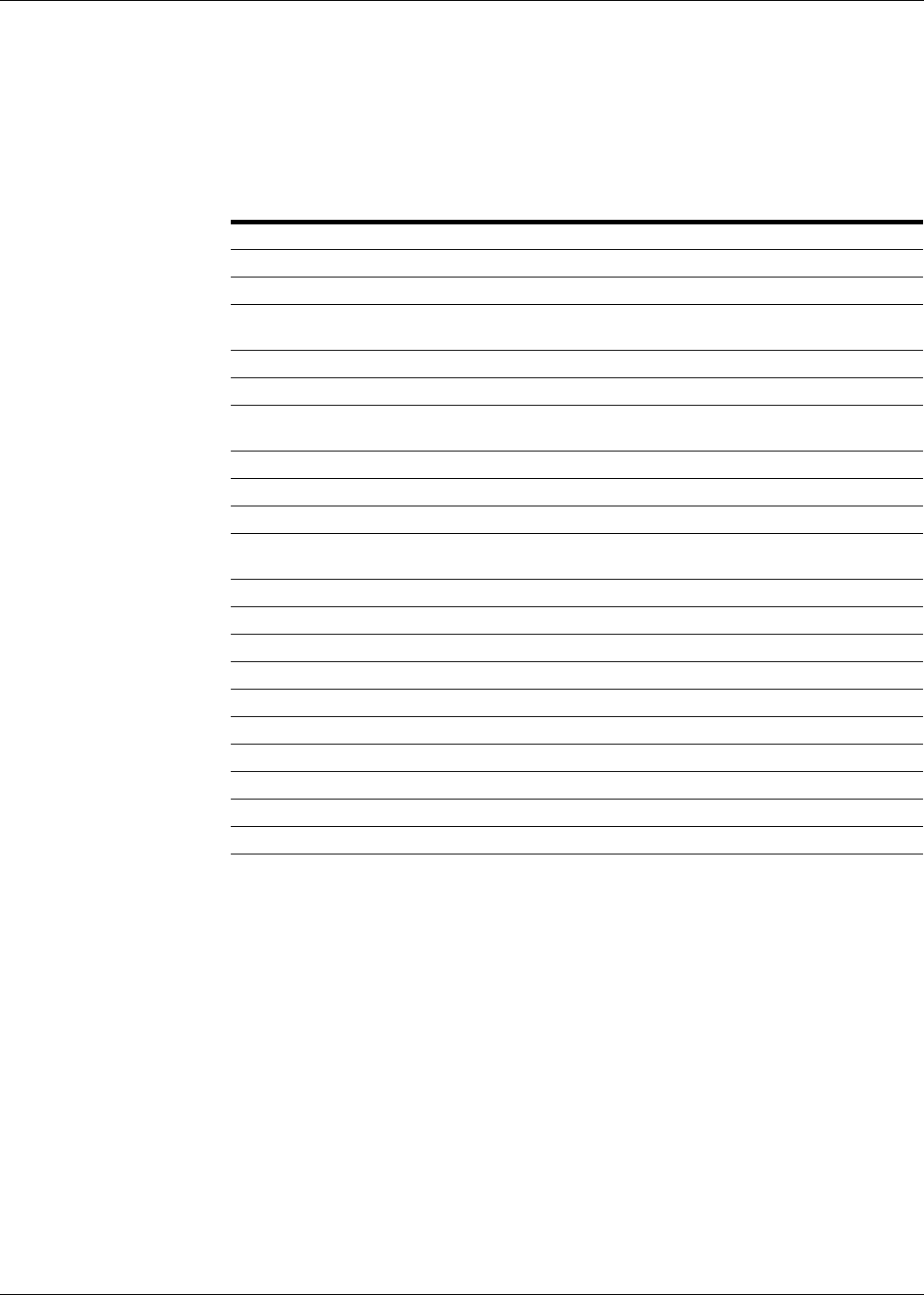
Parts Lists
Page 6 MDE-3591A TRIND™/TIRIS™ Retrofit Kits C00011-002-XXXX • 11/00
PRELIMINARY
FCC 11/30
MPD®-3 Series Kit Parts
MPD-3 Units with PMI Bezels (Slide-in Faceplates)
C00011-002-MPDS Kits for single-sided units and C00011-002-MPDD Kits for
double-sided units with PMI bezels and slide-in faceplates contain the following.
Description Part Number Quantity MPDS Quantity MPDD
antenna assembly (see note 1) T20632-G1 (see note 1) 1 2
antenna bracket kit (see note 5) K96647-01 (see note 5) 1 2
bezel assembly T20616-G1 1 2
cable assembly (J203/J806) (see
note 2)
R18163-G1 (see note 2) 1 1
cable clamp, gray Q13558-04 10 10
cable group (see note 3) Q13863-07 (see note 3) 1 1
cable, jumper assembly (see note
2)
M01380A001 (see note 2) 0 0
card cage assembly T20606-G2 1 1
decal, UL N23951-03 1 1
grommet, edge Q10315-06 1 ft. 1 ft.
grommet, heat shrinkable (see
note 2)
Q13570-01 (see note 2) 0 0
jump jack Q11011-01 9 9
label, UL certification N23957-G1 1 1
manager keypad assembly T17549 1 1
nameplate, FCC label N23949-02 1 1
screw, sems, 6-32 x 3/8 Q12083-13 1 1
sealant, silicone END 1576 1 tube 1 tube
software, CRIND™ Bios TRIND K93744-XX (see note 4) (see note 4)
standoffs, circuit board Q10651-16 4 4
tie wrap Q10178-01 4 4
washer, flat N16599-48 1 1
Notes:
1. For units with Exxon Light Box, kit is configured at order entry to replace antenna assembly T20632-G1
with T20632-G4 antenna assembly.
2. For units with Exxon Light Box only, quantity is configured at order entry at one per unit.
3. For detail refer to “Cable Group Q13863-07” on page 7.
4. Order entry item.
5. For units with Exxon Light Box Kit is configured at order entry to K96647-06.

MDE-3591A TRIND™/TIRIS™ Retrofit Kits C00011-002-XXXX • 11/00 Page 7
Parts Lists
PRELIMINARY
FCC 11/30
MPD-3 Units with Mack Bezels (Bolt-on Faceplates)
C00011-002-MPBS Kits for single-sided units and C00011-002-MPBD Kits for
double-sided units with Mack bezels and bolt-on faceplates contain the following.
Cable Group Q13863-07
Cable Group Q13863-07 for all MPD-3 Series units contains the following parts:
Description Part Number Quantity MPBS Quantity MPBD
antenna assembly (see note 1) T20632-G1 (see note 1) 1 2
antenna bracket kit (see note 5) K96647-01 (see note 5) 1 2
bezel assembly T20616-G2 1 2
cable assembly (J203/J806) (see
note 2)
R18163-G1 (see note 2) 1 1
cable clamp, gray Q13558-04 10 10
cable group (see note 3) Q13863-07 (see note 3) 1 1
cable, jumper assembly (see note
2)
M01380A001 (see note 2) 0 0
card cage assembly T20606-G2 1 1
decal, UL N23951-03 1 1
grommet, edge Q10315-06 1 ft. 1 ft.
grommet, heat shrinkable (see
note 2)
Q13570-01 (see note 2) 0 0
jump jack Q11011-01 9 9
label, UL certification N23957-G1 1 1
manager keypad assembly T17549 1 1
nameplate, FCC label N23949-02 1 1
screw, sems, 6-32 x 3/8 Q12083-13 1 1
sealant, silicone END 1576 1 tube 1 tube
software, CRIND™ Bios TRIND K93744-XX (see note 4) (see note 4
standoffs, circuit board Q10651-16 4 4
tie wrap Q10178-01 4 4
washer, flat N16599-48 1 1
Notes:
1.For units with Exxon Light Box, kit is configured at order entry to replace antenna assembly T20632-G1
with T20632-G4 antenna assembly.
2. For units with Exxon Light Box only, quantity is configured at order entry at one per unit.
3. For detail refer to “Cable Group Q13863-07” on page 7.
4. Order entry item.
5. For units with Exxon Light Box Kit is configured at order entry to K96647-06.
Description Part Number Quantity
cable, AC Power R20580-G1 1
cable, antenna (hi and low freq) M00878A002 1
cable, TRIND to CRIND R20437-G01 1

Parts Lists
Page 8 MDE-3591A TRIND™/TIRIS™ Retrofit Kits C00011-002-XXXX • 11/00
PRELIMINARY
FCC 11/30
ASC TRIND™ Tool Kit K94577-01
Tool Description Part Number Quantity
co-axial cable tool Q13628-01 1
field strength sensor Q13626-01 1
test tag, TI/RFIDcar mount Q13630-01 1
test tag, TI/RFID hand held Q13630-02 1
threaded rod, 3/8-16 x 4" N23880-01 4
tuning tool, plastic tipped Q13631-01 1
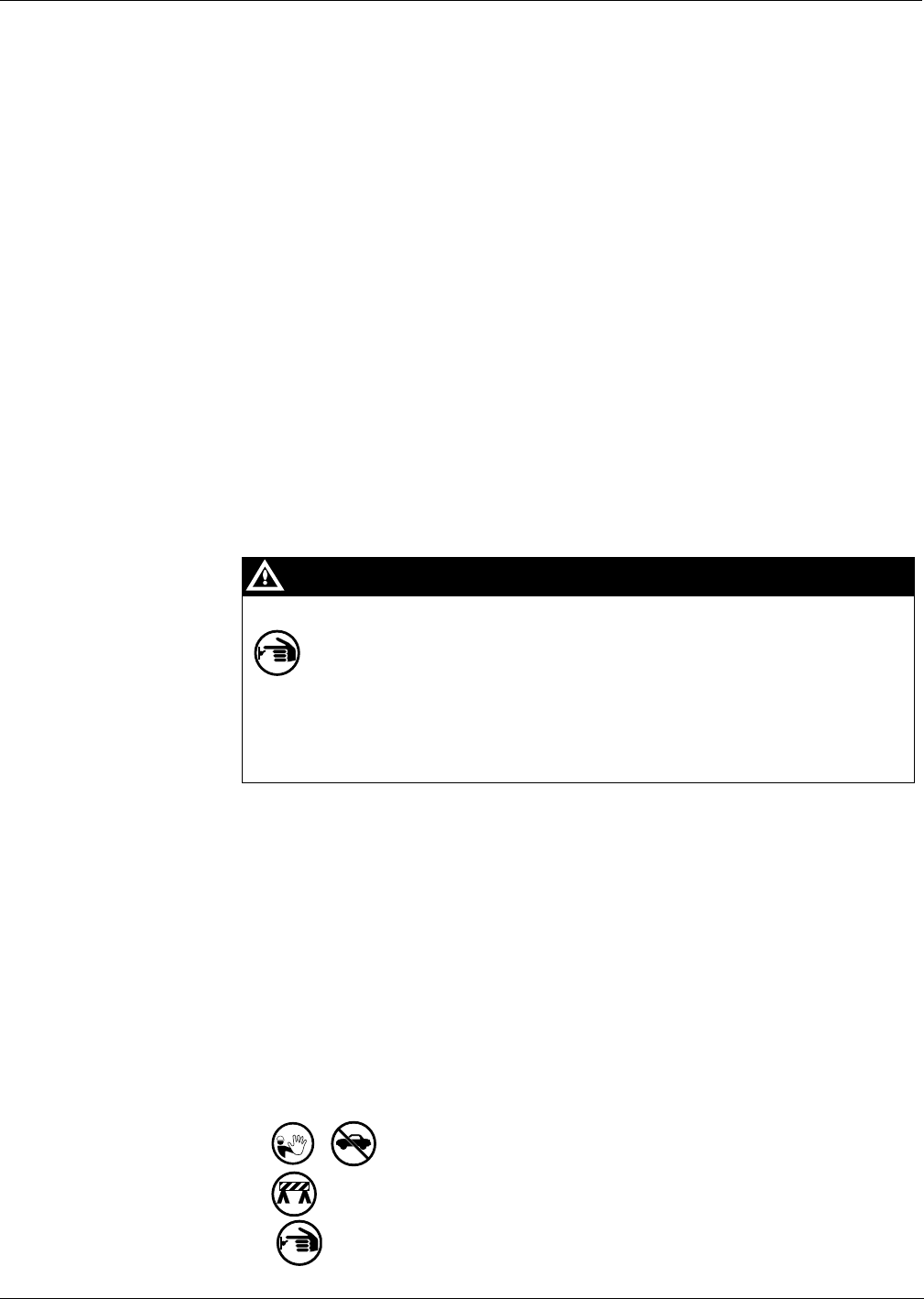
MDE-3591A TRIND™/TIRIS™ Retrofit Kits C00011-002-XXXX • 11/00 Page 9
Important Safety Information
PRELIMINARY
FCC 11/30
Important Safety Information
This section introduces the hazards and safety precautions associated with installing,
inspecting, maintaining or servicing this product. Before performing any task on this product,
read this safety information and the applicable sections in this manual, where additional
hazards and safety precautions for your task will be found. Fire, explosion, electrical shock or
pressure release could occur and cause death or serious injury if these safe service procedures
are not followed.
Preliminary Precautions
You are working in a potentially dangerous environment of flammable fuels, vapors, and high
voltage or pressures. Only trained or authorized individuals knowledgeable in the related
procedures should install, inspect, maintain or service this equipment.
The first and most important information you must know is how to stop all fuel flow to the
pump and island.
Emergency Total Electrical Shut-Off
Locate the switch or circuit breakers that shut-off all power to all fueling equipment,
dispensary devices, and submerged turbine pumps (STPs). These you must operate in the event
of an emergency.
Total Electrical Shut-Off Before Access
Any procedure requiring access to electrical components or the electronics of the dispenser
requires total electrical shut-off of that unit.
NFPA 30A, Section 4-1.2, published by the National Fire Protection Association, requires the
installation of an easily accessible switch or circuit breaker to shut-off the power to all fueling
equipment, dispensing devices and STPs in the event of an emergency. Know the function and
location of this switch or circuit breaker before inspecting, installing, maintaining, or servicing
Marconi equipment.
Evacuation, Barricading and Shut-Off
Any procedures requiring accessing the pump/dispenser or STPs requires the following three
actions:
• An evacuation of all unauthorized persons and vehicles
• Using safety tape or cones as barricades to the effected units
• A total electrical shut-off of that unit
The EMERGENCY STOP, ALL STOP, and PUMP STOP buttons at the cashier’s
station WILL NOT shut off electrical power to the pump/dispenser.
This means that even if you activate these stops, fuel may continue to flow
uncontrolled.
You must used the TOTAL ELECTRICAL SHUT-OFF in the case of an emergency
and not only these cashier station “stops.”
WARNING
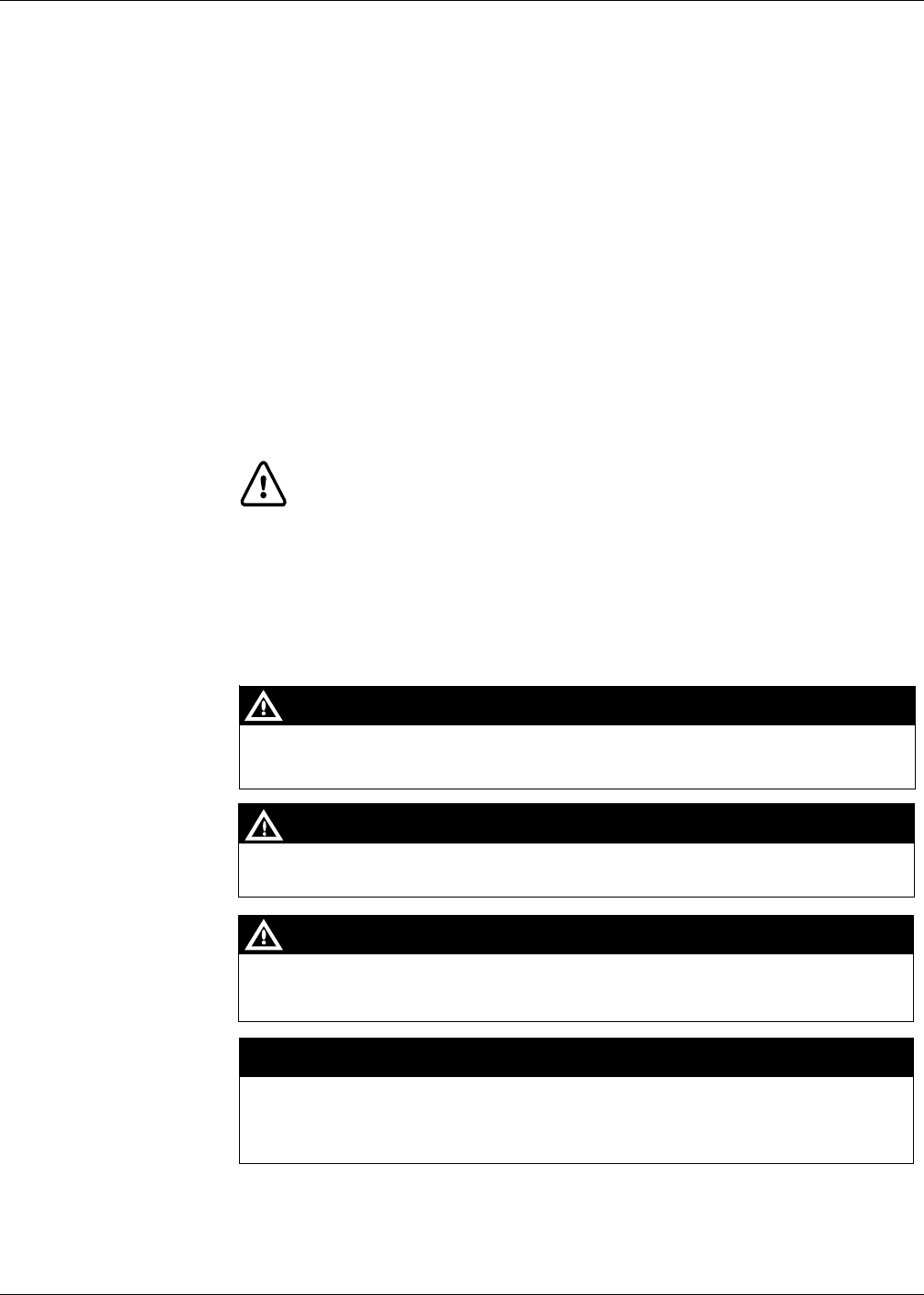
Important Safety Information
Page 10 MDE-3591A TRIND™/TIRIS™ Retrofit Kits C00011-002-XXXX • 11/00
PRELIMINARY
FCC 11/30
Read the Manual
Read, understand and follow this manual and any other labels or related materials supplied
with this equipment. If you do not understand a procedure, call a Marconi Authorized Service
Contractor or call the Marconi Call Center at 1-800-800-7498. It is imperative to your safety
and the safety of others to understand the procedures before beginning work.
Follow the Regulations
There is applicable information in: NFPA 30A: Automotive and Marine Service Code; NFPA
70: National Electrical Code (NEC); OSHA regulations; and federal, state, and local codes
which must be followed. Failure to install, inspect, maintain or service this equipment in
accordance with these codes, regulations and standards may lead to legal citations with
penalties or affect the safe use and operation of the equipment.
Safety Symbols and Warning Words
This section provides important information about warning symbols and boxes.
Alert Symbol
This safety alert symbol is used in this manual and on warning labels to alert you to a
precaution which must be followed to prevent potential personal safety hazards. Obey safety
directives that follow this symbol to avoid possible injury or death.
Signal Words
These signal words used in this manual and on warning labels tell you the seriousness of
particular safety hazards. The precautions that follow must be followed to prevent death, injury
or damage to the equipment.
This signal word designates a hazard or unsafe practice which may result in minor injury.
This signal word is used to alert you to a hazard or unsafe practice which will result in
death or serious injury.
This alerts you to a hazard or unsafe practice that could result in death or serious injury.
CAUTION
When used by itself, CAUTION designates a hazard or unsafe practice which may result in
property or equipment damage.
CAUTION
DANGER
WARNING
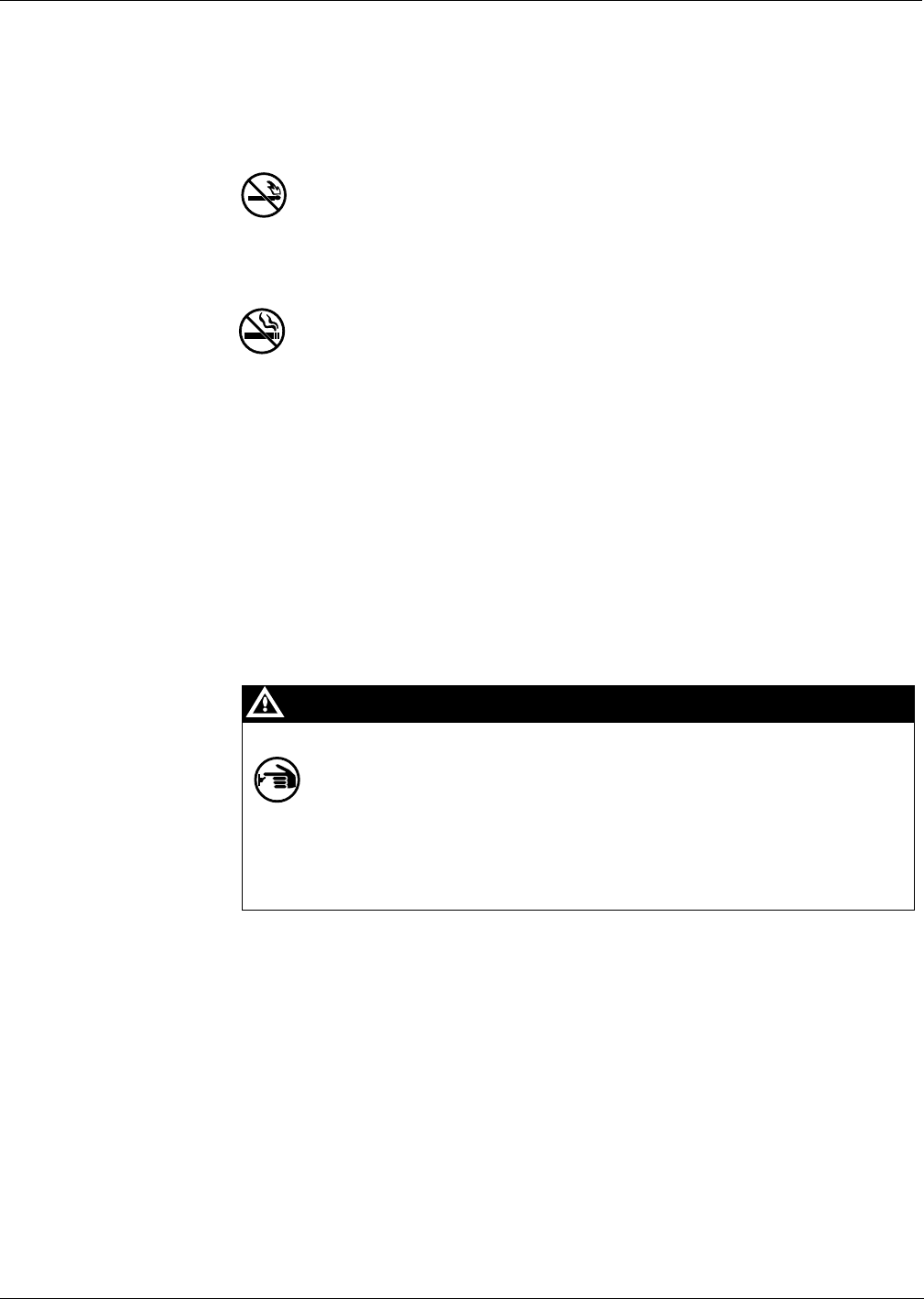
MDE-3591A TRIND™/TIRIS™ Retrofit Kits C00011-002-XXXX • 11/00 Page 11
Important Safety Information
PRELIMINARY
FCC 11/30
Prevent Explosions and Fires
Fuels and their vapors will become explosive if ignited. Spilled or leaking fuels cause vapors.
Even filling customer tanks will cause explosive vapors in the vicinity of dispenser or island.
No Open Flames
Open flames from matches, lighters, welding torches or other sources can ignite fuels
and their vapors.
No Sparks - No Smoking
Sparks from starting vehicles, starting or using power tools, burning cigarettes, cigars
or pipes can also ignite fuels and their vapors. Static electricity, including an electrostatic
charge on your body, can cause a spark sufficient to ignite fuels and their vapors. After getting
out of a vehicle, touch the metal of your vehicle to discharge any electrostatic charge before
you approach the dispenser island.
Prevent Electrical Shock and Sparks
Dispensing devices use high voltage. A potential shock hazard exists when working on or
around a dispensing device.
Follow OSHA lock-out and tag-out procedures.
Always turn OFF power to the dispensing device and associated submerged turbine pumps
(STPs) when servicing or making electrical wiring connections. Multiple disconnects may be
required.
Close Junction Boxes Tightly
Spilled or leaking fuels in the vicinity of electrical junction boxes can be hazardous if boxes
are not properly closed. Replace all bolts and tighten junction box cover before turning on AC
power. Do not use gaskets on junction box covers.
The EMERGENCY STOP, ALL STOP, and PUMP STOP buttons at the cashier’s
station WILL NOT shut off electrical power to the pump/dispenser.
This means that even if you activate these stops, fuel may continue to flow
uncontrolled.
You must used the TOTAL ELECTRICAL SHUT-OFF in the case of an emergency
and not only these cashier station “stops.”
WARNING

Important Safety Information
Page 12 MDE-3591A TRIND™/TIRIS™ Retrofit Kits C00011-002-XXXX • 11/00
PRELIMINARY
FCC 11/30
Field Wiring
Poorly wired pumps or dispensers could cause a fire, explosion or electrical shock. Place all
power and lighting wires in threaded, rigid metal conduits. Plug all unused junction box holes.
Never use knockout boxes or flexible conduit. Tighten all threaded connections and covers. Do
not use gaskets with junction box covers. Do not disturb sealing compound around wires at
junction box entrances. Use factory method of routing wires. Use tie wraps to keep unruly
wires away from pinch point and hinges. Tuck wires into enclosure before closing doors,
bezels, junction boxes, covers and breaker panels. Follow wiring recommendations in
installation or service manuals.
Proper Grounding is Required
Proper grounding is required for safe operation. See installation manual and applicable NEC,
NFPA and local electrical codes for requirements.
Avoid Pinched Wires
Pinched or cut wires (cables) may damage components. Exposed wires could create sparks and
electrical shorts when applying power.
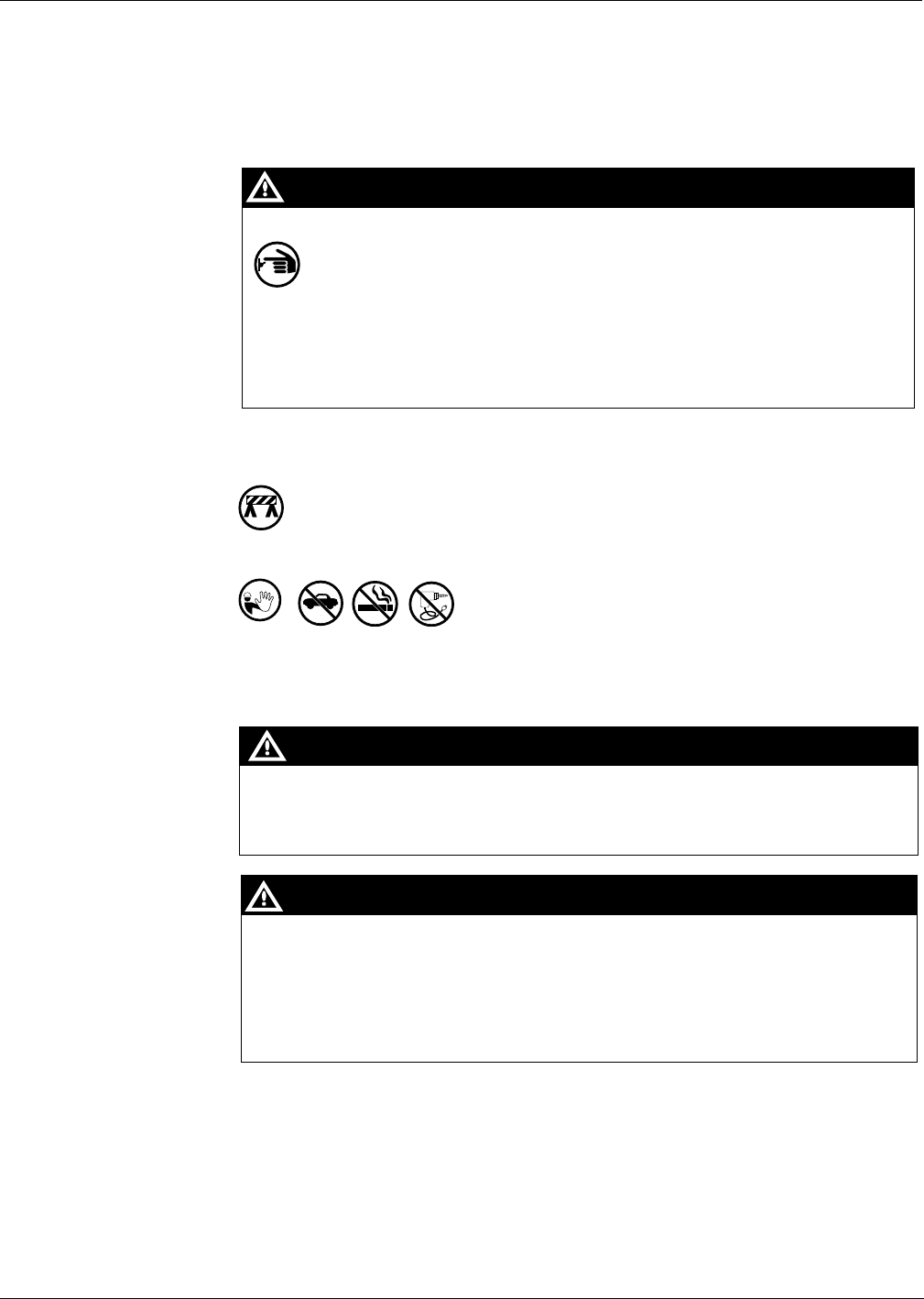
MDE-3591A TRIND™/TIRIS™ Retrofit Kits C00011-002-XXXX • 11/00 Page 13
Important Safety Information
PRELIMINARY
FCC 11/30
React Quickly to Fuel Spills, Fires or Vehicle Impact
Follow these steps in the event of a fuel spill, fire, or vehicle impact.
1Use station EMERGENCY TOTAL ELECTRICAL SHUT-OFF immediately. Turn off all
system circuit breakers to the island.
2Call emergency numbers for fires, vehicle impact or any significant spills.
3 Use safety tape, cones or barricades to block the work area. Do not go near fuel spill or
allow anyone else in the area.
4 Take precautions to avoid igniting fuel. Do not allow starting of
vehicles in the area and immediately stop use of open flames, smoking or power tools in the
area.
5Provide emergency and first aid assistance.
6Use approved and safe procedures to clean up all spills with a “fuel or gasoline absorbent”
material approved by your local regulatory agencies. (Dispose of fuel and hazardous absorbent
material promptly and according to the requirements of the fire department, local EPA, and
federal, state or local resources.)
The EMERGENCY STOP, ALL STOP, and PUMP STOP buttons at the cashier’s
station WILL NOT shut off electrical power to the pump/dispenser.
This means that even if you activate these stops, fuel may continue to flow
uncontrolled.
You must used the TOTAL ELECTRICAL SHUT-OFF in the case of an emergency
and not only these cashier station “stops.”
WARNING
If any gasoline has been inhaled, seek emergency help immediately.
Inhaled gasoline may cause unconsciousness and burns to lips, mouth and lungs.
WARNING
Gasoline spilled on skin may cause burns.
Wash area thoroughly with clean water.
Seek medical advice immediately.
WARNING
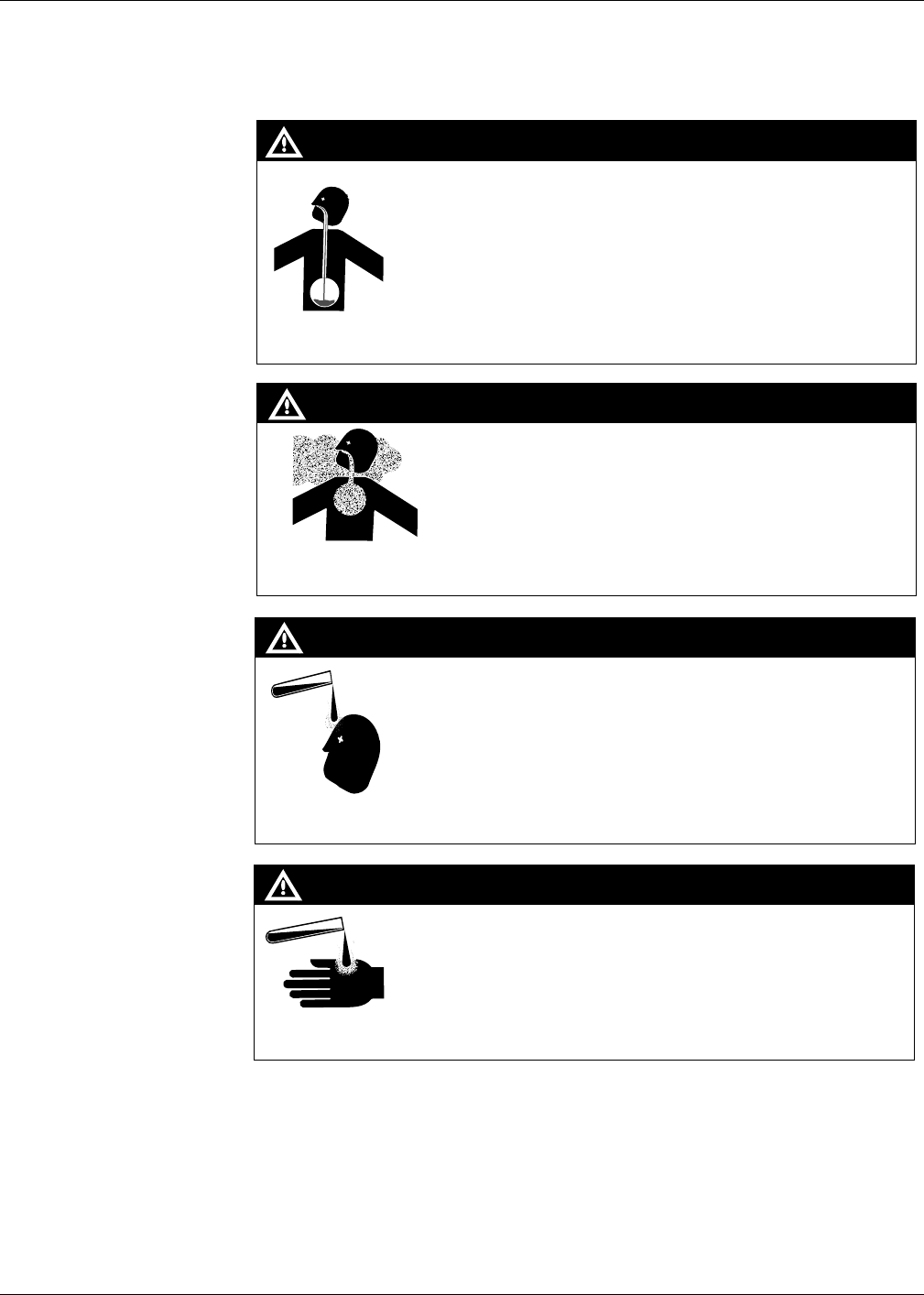
Important Safety Information
Page 14 MDE-3591A TRIND™/TIRIS™ Retrofit Kits C00011-002-XXXX • 11/00
PRELIMINARY
FCC 11/30
Emergency and First Aid Information
Refer to phone book for emergency phone numbers. If needed, follow first aid instructions as
outlined in American Red Cross Standard First Aid manuals.
Gasoline
Ingestion
Gasoline Vapor
Inhalation
Gasoline spilled in eyes may cause burns to eye tissue.
Irrigate eyes with water for approximately 15 minutes.
Seek medical advice immediately
Gasoline spilled on skin may cause burns.
Wash area thoroughly with clear/water.
Seek medical advice immediately.
Gasoline On
Skin
Gasoline In
Eyes
Gasoline inhaled may cause unconsciousness and burns to lips,
mouth and lungs.
Keep airway open.
Seek medical advice immediately.
WARNING
WARNING
WARNING
WARNING
Gasoline ingested may cause unconsciousness and burns to
internal organs.
Do not induce vomiting.
Keep airway open.
Oxygen may be needed at scene.
Seek medical advice immediately.
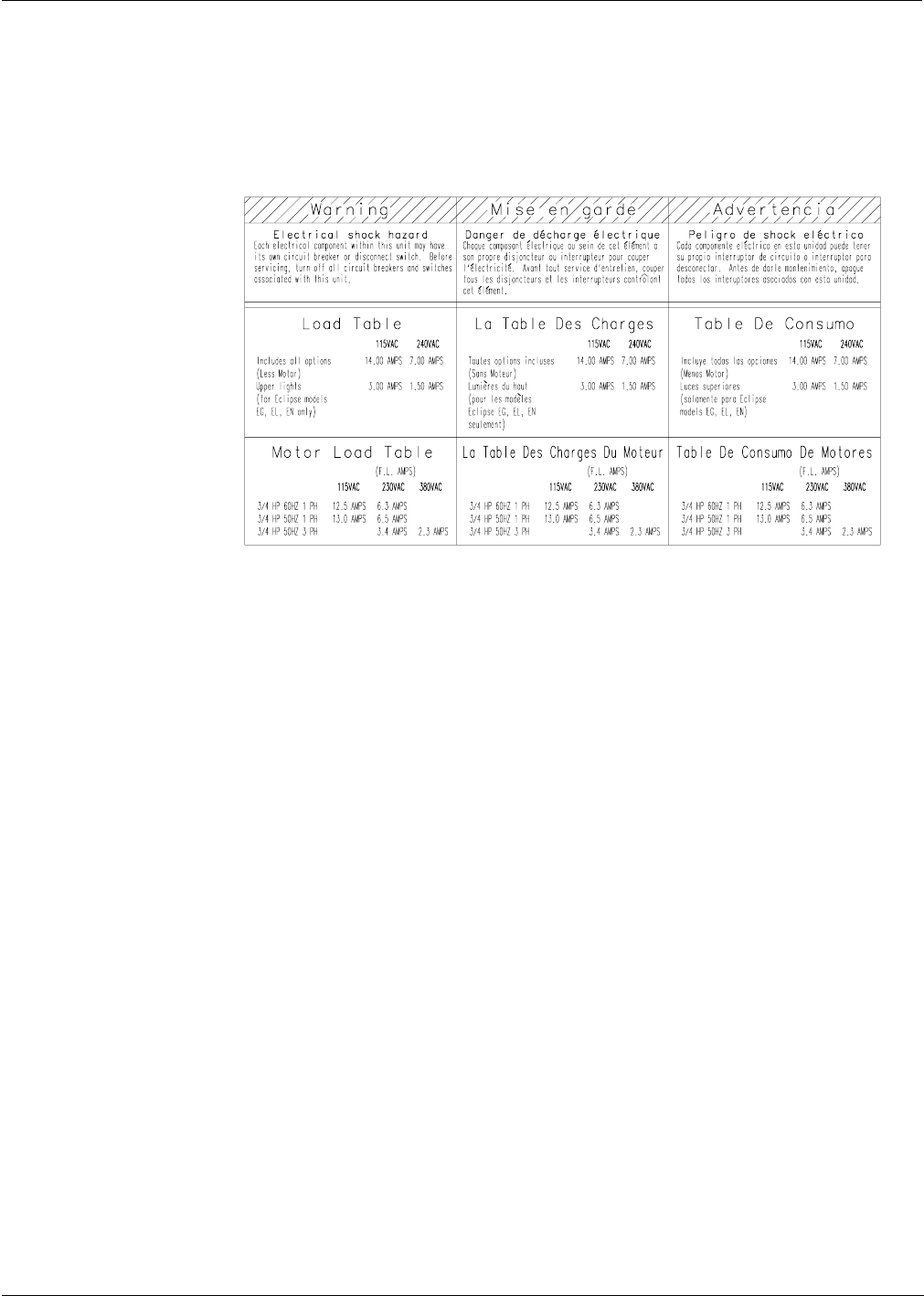
MDE-3591A TRIND™/TIRIS™ Retrofit Kits C00011-002-XXXX • 11/00 Page 15
Important Safety Information
PRELIMINARY
FCC 11/30
Warning Labels Several types of warning labels appear on Marconi products to inform and remind users of
important safety information. Read, understand and follow these warnings.
Sample Warning Label
The following labels are typical of those you may find on Marconi’s products:
Working Alone It is highly recommended that someone who is capable of rendering first aid be present during
servicing. Be familiar with Cardiopulmonary Resuscitation (CPR) methods if you are working
with or around high voltages. This information is available from the American Red Cross.
Always advise the station personnel about where you will be working, and caution them not to
activate power while you are working on the equipment. Use the OSHA tag out and lock out
procedures discussed later in this section.
Contacting Emergency Personnel
Keep the following emergency phone numbers at hand.
Ambulance:_____________________________________
Fire:___________________________________________
Police:_________________________________________
Poison Control Center:____________________________
Informing Emergency Personnel
Compile the following information for emergency personnel:
•Location of accident (e.g. address, front/back of building, etc.)
•Nature of accident (e.g. possible heart attach, run over by car, burns, etc.)
•Age of victim (e.g. baby, teenager, middle-age, elderly)
•Whether or not victim has received first aid (e.g. stopped bleeding by pressure, etc.)
•Whether or not victim has vomited (e.g. if swallowed or inhaled something, etc.)
IMPORTANT: Oxygen may be needed at scene if gasoline has been ingested or inhaled. Seek
medical advice immediately.

Important Safety Information
Page 16 MDE-3591A TRIND™/TIRIS™ Retrofit Kits C00011-002-XXXX • 11/00
PRELIMINARY
FCC 11/30
Other Useful Safety Information
This subsection provides additional safety information.
OSHA Lock-Out and Tag-Out Requirements
OSHA Standard 29 CFR 1910-147 Control of Hazardous Energy Sources (Lock-Out/Tag-Out)
covers ways to avoid personal injury because power was turned on or fuel pressure was applied
unexpectedly while servicing equipment. The rule requires:
(1) Turning off equipment power and fuel under pressure
(2) Use of a locking device (breaker, valve, etc.) or label device with a warning tag.
Station employees and service contractors need to understand and comply with this program
completely to ensure safety while the equipment is down.
Breakaways
Required by NFPA 30A, breakaways are emergency devices designed to retain liquid on both
sides of the breakaway point installed on each hose. Refer to manufacturer’s instructions for
proper installation.
Collection of Fuel in Approved Containers
NFPA 30A, Section 2, requires use of approved containers to collect, transport, and dispose of
fuel. Containers must be specifically designed and labeled for handling hazardous fuels.
Read Material Safety Data Sheets (MSDS)
Before working with any chemicals or fuels in and around a dispensing facility, read the
MSDS pertaining to those chemicals as prescribed in the Occupational Safety and Health
Administration Standard, 29 CFR 1910.1200. Refer to the supplier’s literature.
Replacement Parts
Use only genuine Marconi replacement parts and retrofit kits on your pump/dispenser. Using
parts other than genuine Marconi replacement parts could create a safety hazard and violate
local regulations.

MDE-3591A TRIND™/TIRIS™ Retrofit Kits C00011-002-XXXX • 11/00 Page 17
Important Safety Information
PRELIMINARY
FCC 11/30
Classifying Hazardous Locations
Any activity that can cause an explosion (e.g., smoking, drilling, etc.) must be
done well outside the vapor area.
The following diagrams are based on NFPA 30A, section 6 and NFPA 70, section
514.
Fuel is present.
(Flammable Liquid)
Class 1 Division 2
(Hazardous Location)
Class 1 Division 1
(Hazardous Location)
Fuel Containing
Components
Vapor Areas
18"
18"
Unclassified location
area within electronics cabinet
above Air Gap.
Class 1 Division 1
within boot area.
Air Gap
20'
Pit box.
20'
20'
20'
Unclassified location
Electronics Head
Vapor Barrier
20'
Pit box.
18"
18"
Vertical Vapor Barrier
Vertical Vapor Barrier
Class 1 Division 1
within boot area.
MPD®-3 Series
with
Vapor Barrier
The
Advantage®
Series with
Air Gap

ASC TRIND™ Technology Update
Page 18 MDE-3591A TRIND™/TIRIS™ Retrofit Kits C00011-002-XXXX • 11/00
PRELIMINARY
FCC 11/30
ASC TRIND™ Technology Update
The TRIND™ system utilizes technology and devices not commonly used in the
industry. Read the following carefully to familiarize yourself with relatively
unique aspects of TRIND and prevent field problems.
RF Transmission and Antennas
Located in the TRIND card cage is a transmitter printed circuit board (PCB). The
RF antennas are connected to this board during installation.
Applying power to the card cage with either antenna disconnected will
result in damage to the transmitter PCB.
•The transmitter PCB may be burned up immediately, or its effective life
shortened drastically.
•The PCB may perform properly at installation, but will require premature
field service at a later date.
For single-sided units, a ‘dummy load’ connector R20526-G1 is provided for
unused ‘B’ side of the PCB.
Note: Power must never be applied to the card cage without a load, either antennas
or dummy load connector.
Co-Axial Cable
Co-axial antenna cables in cable harness M00878A002 used for TRIND are more
flexible and smaller diameter than more familiar co-axial cable, such as that used
for cable television. However, all co-axial cables share this feature:
Too severe a turn or bend in the cable will break the center (solid) wire.
This can result in a seemingly good but in actuality intermittent signal. This too
may result in what appears to be proper performance at installation that is
followed by premature failure and field service. Replacing damaged cable in the
field is an extensive task.
In addition, a damaged cable will also cause a situation where the transmitter
PCB is powered without load, and damage the PCB.
Note: Turns or bends in co-axial cables must be gradual loops, no sharper than a
1" radius (2" diameter).
ATTENTION: AUTHORIZED SERVICE CONTRACTORS
READ THIS SECTION BEFORE PROCEEDING WITH INSTALLATION
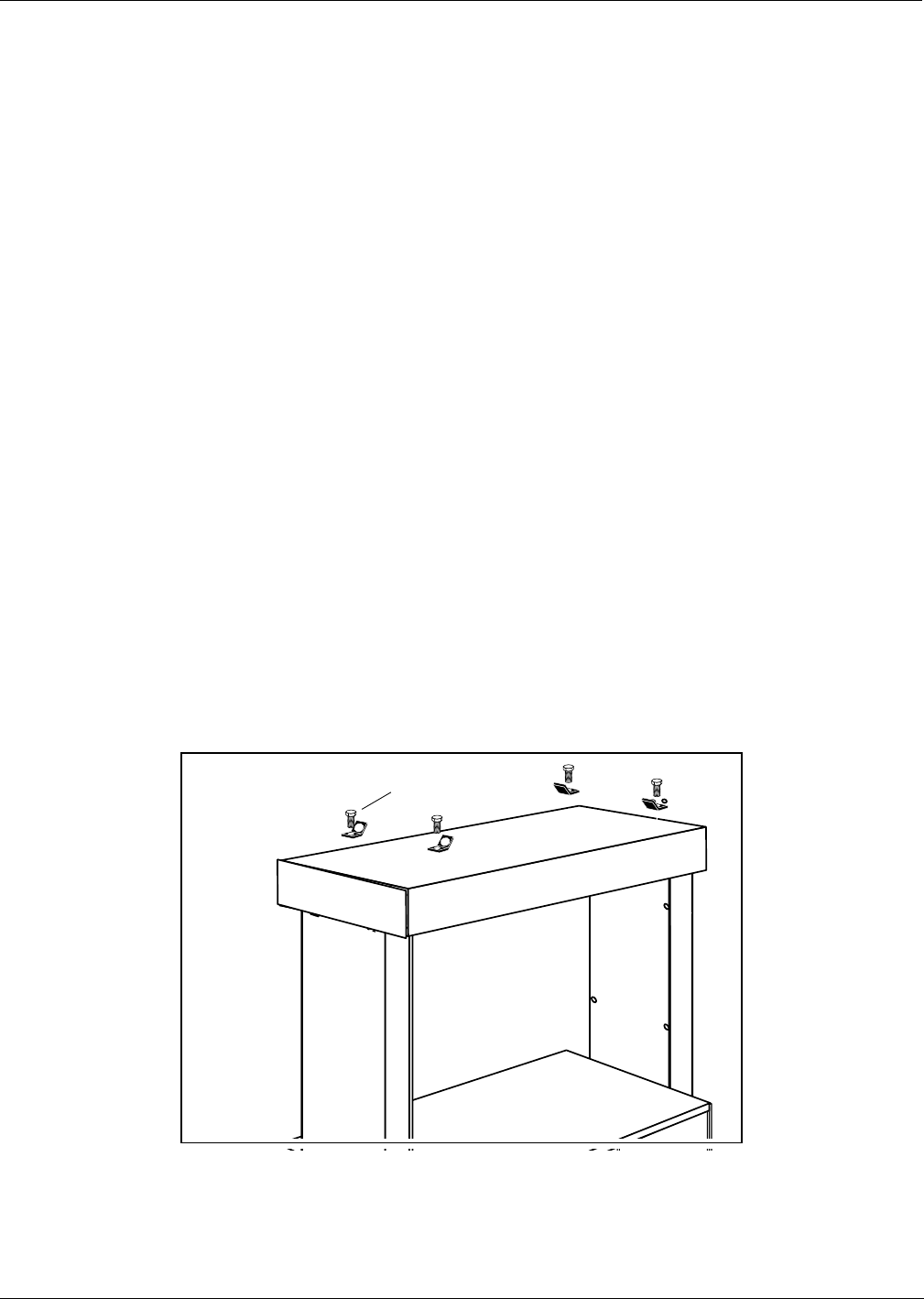
MDE-3591A TRIND™/TIRIS™ Retrofit Kits C00011-002-XXXX • 11/00 Page 19
Installation Instructions for All Kits
PRELIMINARY
FCC 11/30
Installation Instructions for All Kits
Before beginning read “Classifying Hazardous Locations” on page 17 and “ASC
TRIND™ Technology Update” on page 18.
Preparing Exxon Light Boxes
Use these procedures for dispensers with Exxon light boxes only. For units
without light boxes, proceed to ‘Preparing for Installation’ on page 19.
1Open and lift display frames on both long sides of display and lock in-place
according to light box manufacturer’s instructions.
2Remove cover from electrical connection box in display cabinet and disconnect
wires. Save cover, screws and wire connectors for reassembly.
3Remove locking nut and washer from conduit nipple in display cabinet. Save nut
and washer for reassembly.
4Loosen four 3/8-16 bolts, lock washers, flat washers and soft aluminum flat
washers securing display cabinet to top of unit.
Preparing For Installation
If present, remove four hoisting brackets from top of unit by removing four bolts,
four metal washers and four rubber washers. Save hoisting brackets and
hardware for reassembly.
Note: On units with light box, hoisting brackets may have already been removed.
Hoisting brackets
and 3/8” bolts
Removing
hoisting brackets
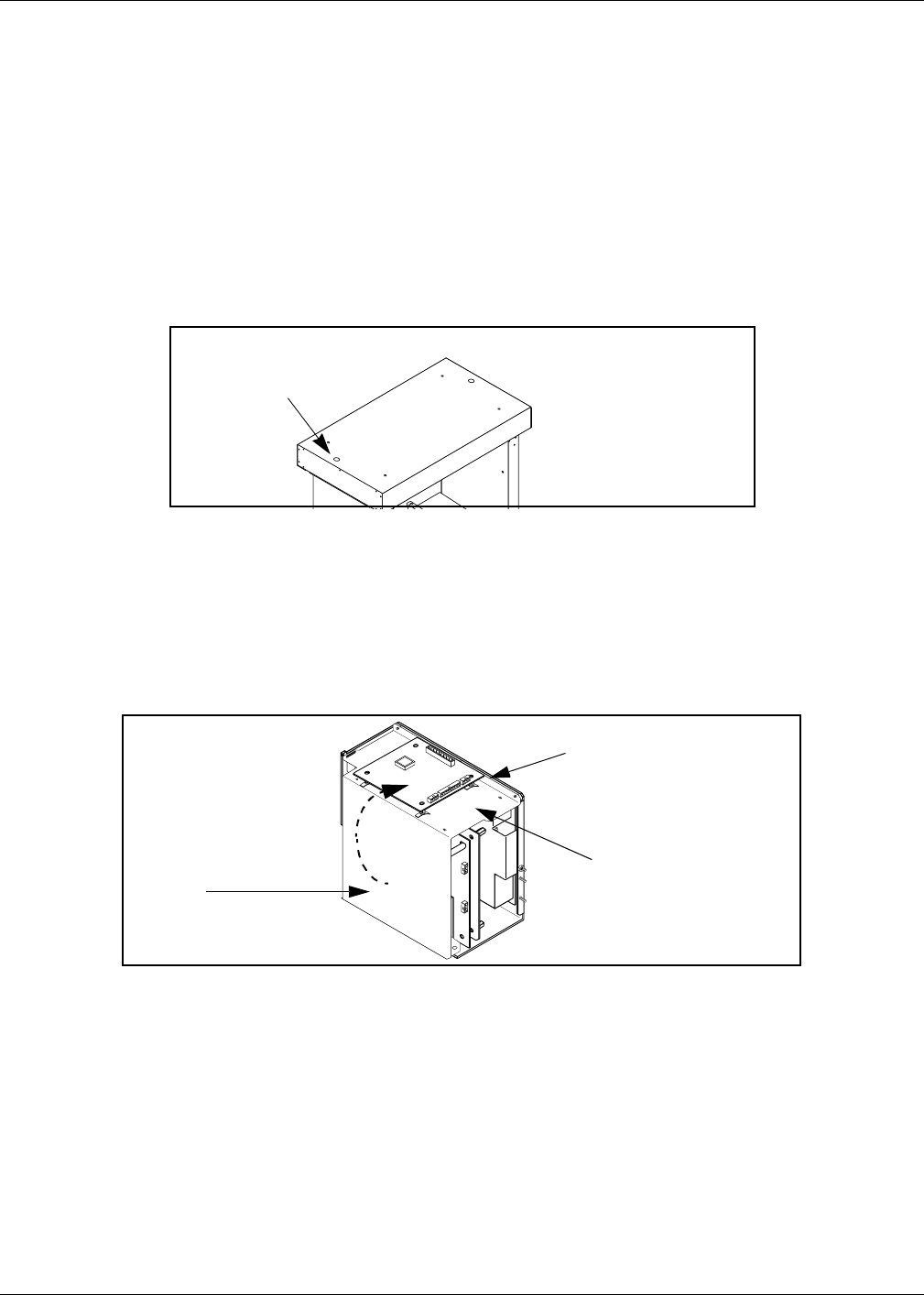
Installation Instructions for All Kits
Page 20 MDE-3591A TRIND™/TIRIS™ Retrofit Kits C00011-002-XXXX • 11/00
PRELIMINARY
FCC 11/30
Removing Knockout in Unit Top Cover
1Remove knockout from left side of unit top cover while facing ‘B’ side for The
Advantage units or ‘A’ side for MPD-3 units.
Note: For units with light box, this will require lifting side of light box for access,
by loosening and/or removing hardware as described in Step 4 of “Preparing
Exxon Light Boxes” on page 19. If light box conduit is run through the
knockout designated in this section, use the knockout on the opposite side of
the top cover for the TRIND installation.
•For units without end plate, lift left side of top cover for access to knockout
from bottom.
•For units with nine bolt end plates, remove plate for access.
2Lower top cover to original position.
Note: For units with end plate, do not replace plate at this time. For units with
light box, also remove knockout in light box aligning with knockout in top
cover before returning top cover and light box to original position.
Relocate Gateway Board on Card Cage
Gateway board is shipped mounted to side of card cage. Relocate Gateway board
to top of card cage according to the following steps:
1Remove Gateway board and standoffs from side of card cage.
Note: Existing standoffs do not need to be reused and may be clipped or broken off
card cage.
2Relocate Gateway board to top of card cage as shown, using four Q10651-16
standoffs provided with kit.
Top cover knockout ‘B’ side for The Advantage
Series
‘A’ side for MPD-3 Series
If light box present, use
available knockout
regardless of side.
Gateway Board location as
shipped
Gateway Board reinstalled on top
P250 side of
board
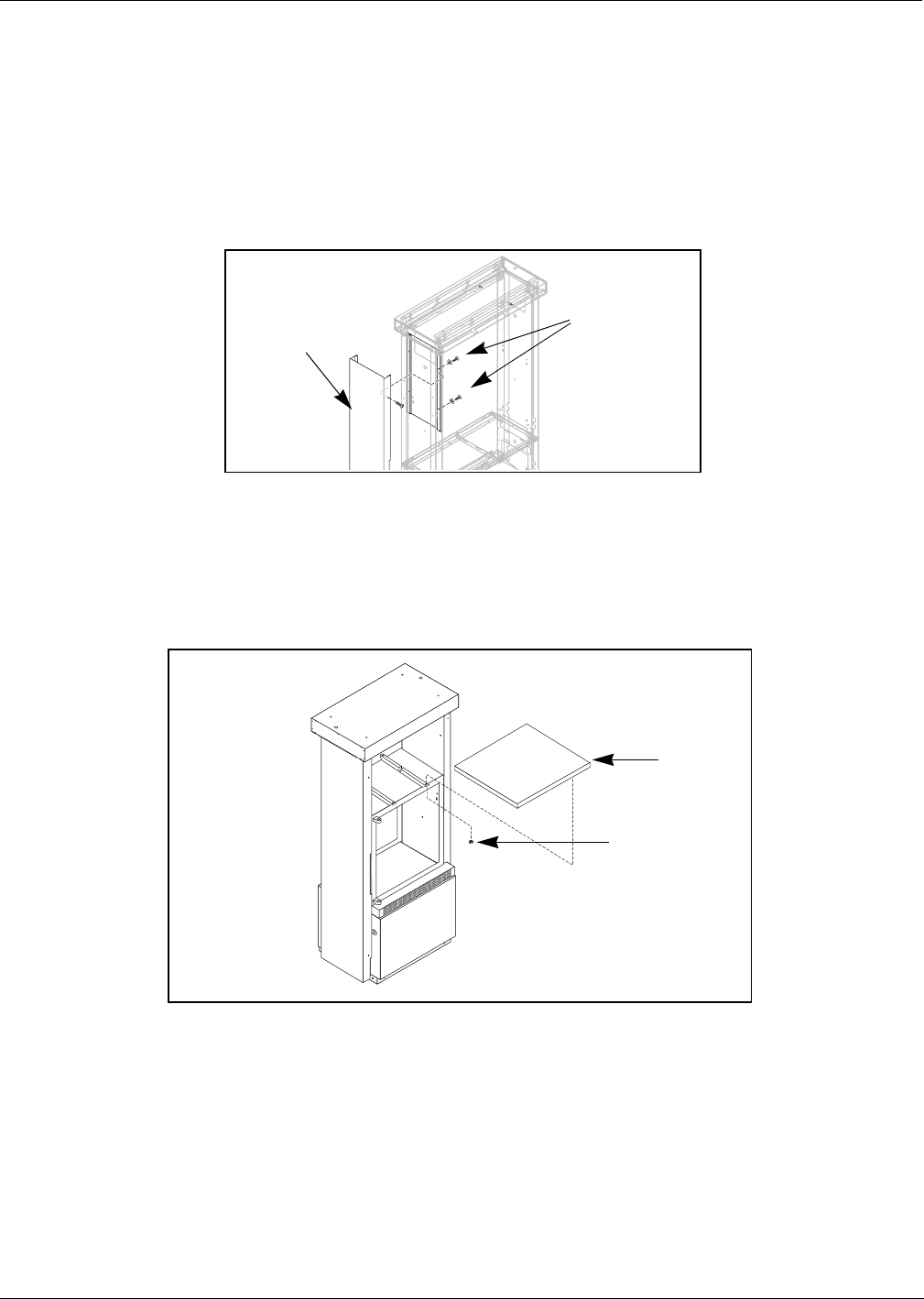
MDE-3591A TRIND™/TIRIS™ Retrofit Kits C00011-002-XXXX • 11/00 Page 21
Installation Instructions for The Advantage® Series Units
PRELIMINARY
FCC 11/30
Installation Instructions for The Advantage® Series Units
For MPD-3 Series, go to “Installation Instructions For MPD®-3 Units” on
page 35.
1From ‘A’ side of unit, remove inner sheathing on left column. Set sheathing and
screws aside for reassembly.
2Open main access doors. Refer to MDE-2531, Pump and Dispenser Start-Up/
Service Manual for access instructions.
3Remove top cover from main panel by accessing mounting hardware from inside
main cabinet. Save top cover and fastening hardware for reassembly.
4Remove any call or stop buttons, or magnetic switch hardware from door. Save all
removed hardware for reassembly.
Inside sheathing
and screws
‘A’ side
Removing inner
sheathing
Outside sheathing
Top cover
Access to top cover
fastening bolts from
inside main cabinet
Removing cabinet
top cover

Installation Instructions for The Advantage® Series Units
Page 22 MDE-3591A TRIND™/TIRIS™ Retrofit Kits C00011-002-XXXX • 11/00
PRELIMINARY
FCC 11/30
5Remove door mounting pin and right options door.
6Dispose of door. Save pin for reassembly.
Door mounting pin
Right options door
Removing options door
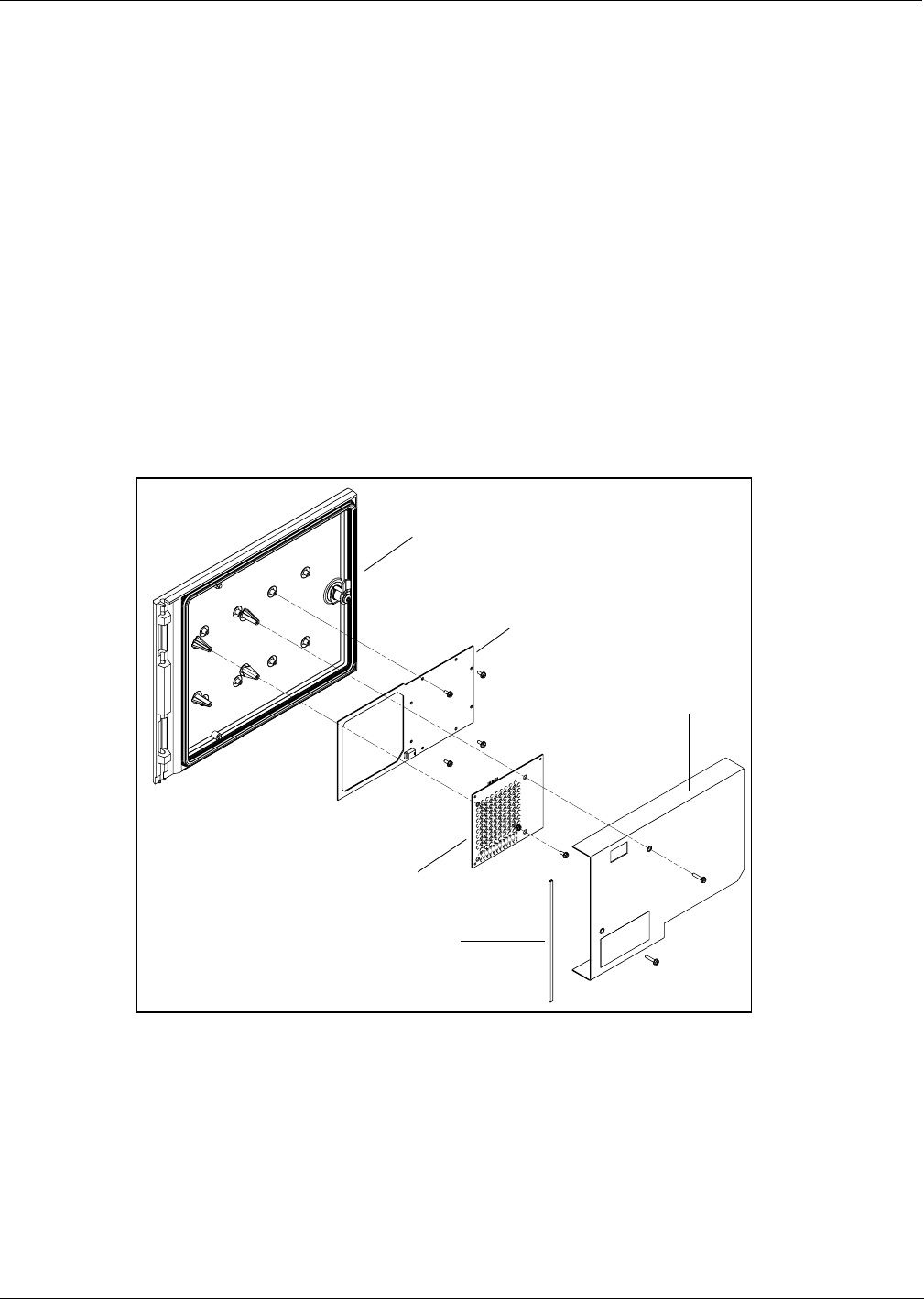
MDE-3591A TRIND™/TIRIS™ Retrofit Kits C00011-002-XXXX • 11/00 Page 23
Installation Instructions for The Advantage® Series Units
PRELIMINARY
FCC 11/30
Modifying Right Options Door
For 48" units without stop or call button on right options door, and all 36"
units, go to ‘Re-installing Door Alarm Switches’ on page 25, if unit has door
alarm. If unit does not have door alarm, go to “Installing Right Options Door”
on page 25.
For 48" units with stop or call buttons previously installed, perform the
following steps.
1Remove all hardware from new right options door according to the following
steps and save all parts for reassembly.
•Remove two screws mounting door shield on rear of door.
•Disconnect cable R20522-G2 from light/microreader printed circuit board
(PCB) by disconnecting J181 on cable from P181 on board.
•Remove Indicator Light PCB.
•Remove standoff-screws holding light/microreader board, and remove
board.
Door
shield
Light/microreader
PCB
Indicator light
PCB T20601
Strip grommet
Clear door assembly
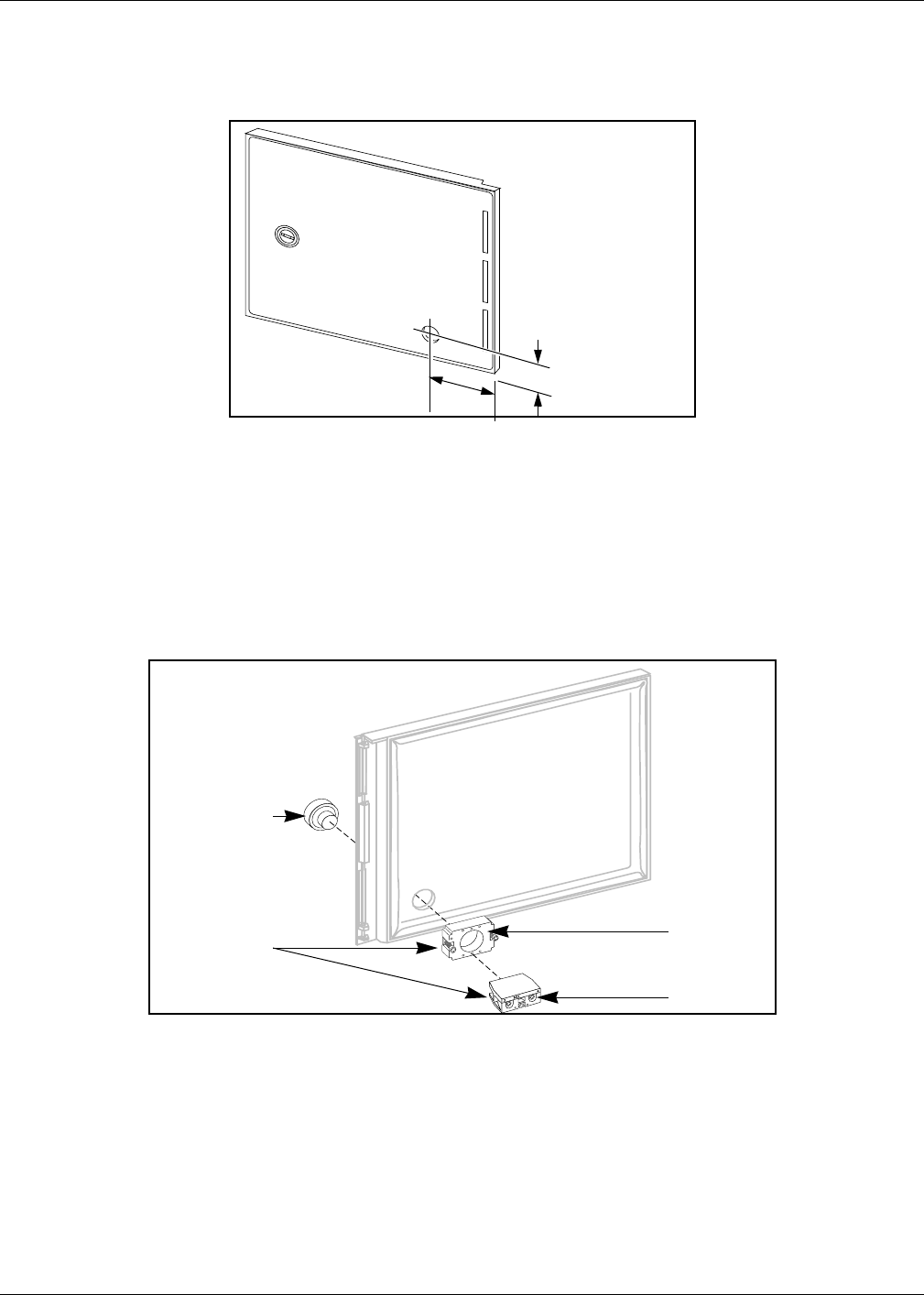
Installation Instructions for The Advantage® Series Units
Page 24 MDE-3591A TRIND™/TIRIS™ Retrofit Kits C00011-002-XXXX • 11/00
PRELIMINARY
FCC 11/30
2Mark placement of pump stop or call button on new right options door by
measuring from door edges as shown.
3Away from fuel island, drill a 7/8 inch diameter hole in the location shown above.
Remove any burrs around hole with deburring tool or rounded file.
Re-installing Button
1Hold contact base on back of door and align with hole drilled earlier.
2Insert push button from front of door by aligning tabs with slots in base.
3Turn push button 45° clockwise to lock button to base.
4Tighten two screws on base to secure push button and base assembly to door.
Note: Do not overtighten screws.
5Attach contact block to base with center screw if not already installed.
6Reinstall all new right options door hardware by reversing procedures in Step 1of
“Modifying Right Options Door” on page 23.
1 9/16"
3 3/16"
Hole location for
pump stop or
call button
Contact Block
Push button
BaseContact switch
base assembly
Re-installing
button(s)
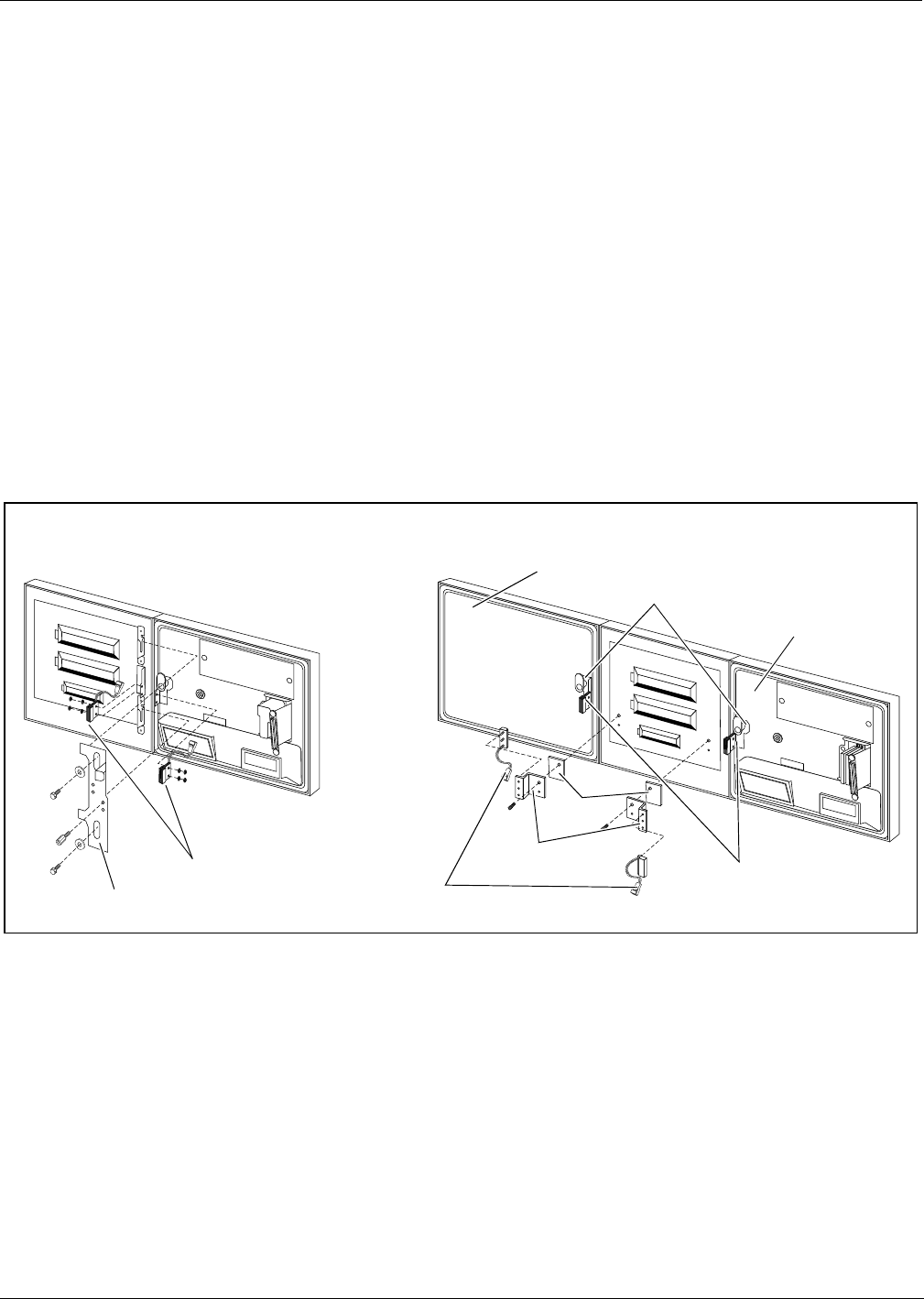
MDE-3591A TRIND™/TIRIS™ Retrofit Kits C00011-002-XXXX • 11/00 Page 25
Installation Instructions for The Advantage® Series Units
PRELIMINARY
FCC 11/30
Re-installing Door Alarm Switches
For units with cash acceptors, follow these steps to re-install door alarm
assemblies on TRIND™ right option doors. Refer to diagram on this page for more
information. Perform each step for both ‘A’ and ‘B’ side right option doors. If unit
does not have door alarm, go to ‘Installing Right Option Door’ on page 25.
1Re-install C-clips removed from old right side option doors.
2Install door alarm assembly to door alarm assembly bracket with screw
previously removed.
3Attach door alarm assembly bracket to display board with screw previously
removed.
Note: Replace the piece of fiberboard between door alarm bracket assembly and display
board.
4Be sure magnet does not touch door alarm door bracket. Slightly move door alarm
door bracket away, if necessary.
5Reinstall all new right options door TRIND hardware by reversing procedures in
Step 1 of “Modifying Right Options Door” on page 23.
Installing Right Options Door
Install new TRIND/TIRIS right options door (one per side for two-sided units),
using pin(s) removed and saved in Step 6 on page 22.
Left option door
Right option door
Door alarm assembly
Fiber
board
Door alarm
assembly bracket
C-clip
Door alarm door bracket
Door alarm assembly
Door alarm
assembly bracket
Back View of 36" Unit
Option Doors Back View of 48" Unit
Option Doors
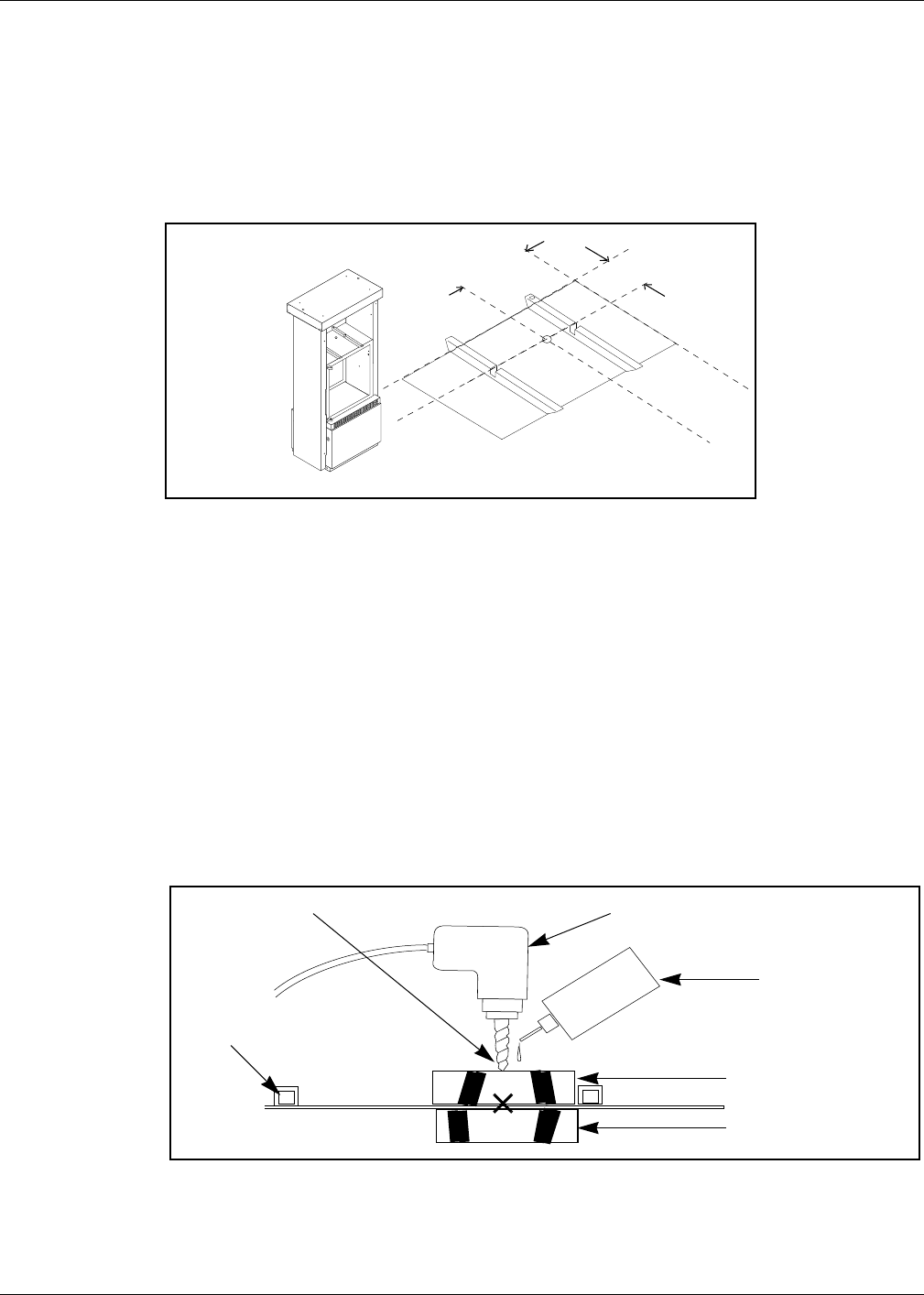
Installation Instructions for The Advantage® Series Units
Page 26 MDE-3591A TRIND™/TIRIS™ Retrofit Kits C00011-002-XXXX • 11/00
PRELIMINARY
FCC 11/30
Installing Bulkhead Grommet
1Disconnect two cables and remove ground connector to ‘A’ side printer. Remove
printer from unit and save for reinstallation.
2While facing ‘A’ side of unit, measure 6" in toward center of cabinet top from
outside edge of top, and draw a line on top cover.
3Measure 10.5" in from left side of top, and draw a line. Intersection of both lines is
pilot hole location.
4In packaging materials, locate thick rubber packing that can be broken into flat
sided pieces, approximately six inches round, square or random.
5On one flat side of thick rubber piece, apply light coating of cutting oil.
6With oil coated surfaces in contact with metal surfaces, heavily tape one each
foam piece to top and bottom of main cabinet top, above and below drilling point
marked.
Note: For foam piece taped to top, mark foam with marking pen or pencil to
identify drilling point under foam. Drilling point location accuracy of plus or
minus 1/2" is acceptable.
.
7Cover shelf area under drilling position with plastic. Kit packaging materials may
be used.
6"
10.5"
'B' Side
'A' Side
Locating
bulkhead
grommet hole
Cutting oil
Foam pieces taped to
cabinet above
and below drilling point
Pneumatic (air) drill
Gusset
on
cabinet
top, seen
from side
Drilling point marked

MDE-3591A TRIND™/TIRIS™ Retrofit Kits C00011-002-XXXX • 11/00 Page 27
Installation Instructions for The Advantage® Series Units
PRELIMINARY
FCC 11/30
8Follow these mandatory safety guidelines:
•Do not use electric drill. Use only pneumatic (air) drill set or controlled for low
speed only (300-500 rpm) or hand operated drill.
•Deposit a few drops of cutting oil at drilling point and on drill bit, to keep bit
from binding, to quench sparks and to bind drill shavings.
9Drill through foam pieces, going only as deep as required to penetrate top cover,
beginning with small diameter bit (approximately 1/8") and gradually increasing
bit size until adequate pilot hole is made.
Note: Hole 3/8" in diameter should be sufficient as pilot for knockout.
10 Remove both top and bottom foam pieces, being careful that all drilling residue
and oil is removed from cabinet area. Wipe off cabinet surface, top and bottom,
with clean cloth or rag.
Note: Use file or deburring tool to remove burrs or edges that may cut hands.
11 Using hydraulic or manual knockout punch, make one inch (1") diameter hole.
12 Remove plastic covering hardware by folding inwards to retain any drilling
residue, and dispose of plastic.
13 Carefully check interior of main cabinet for trash or residue and clean as needed.
14 Position bulkhead seal grommet (Q13570-01) with O-ring beneath hole.
15 Secure grommet in place with locking nut from top of cabinet.
16 From ‘A’ side of unit, drop (lower) CRIND™ tray
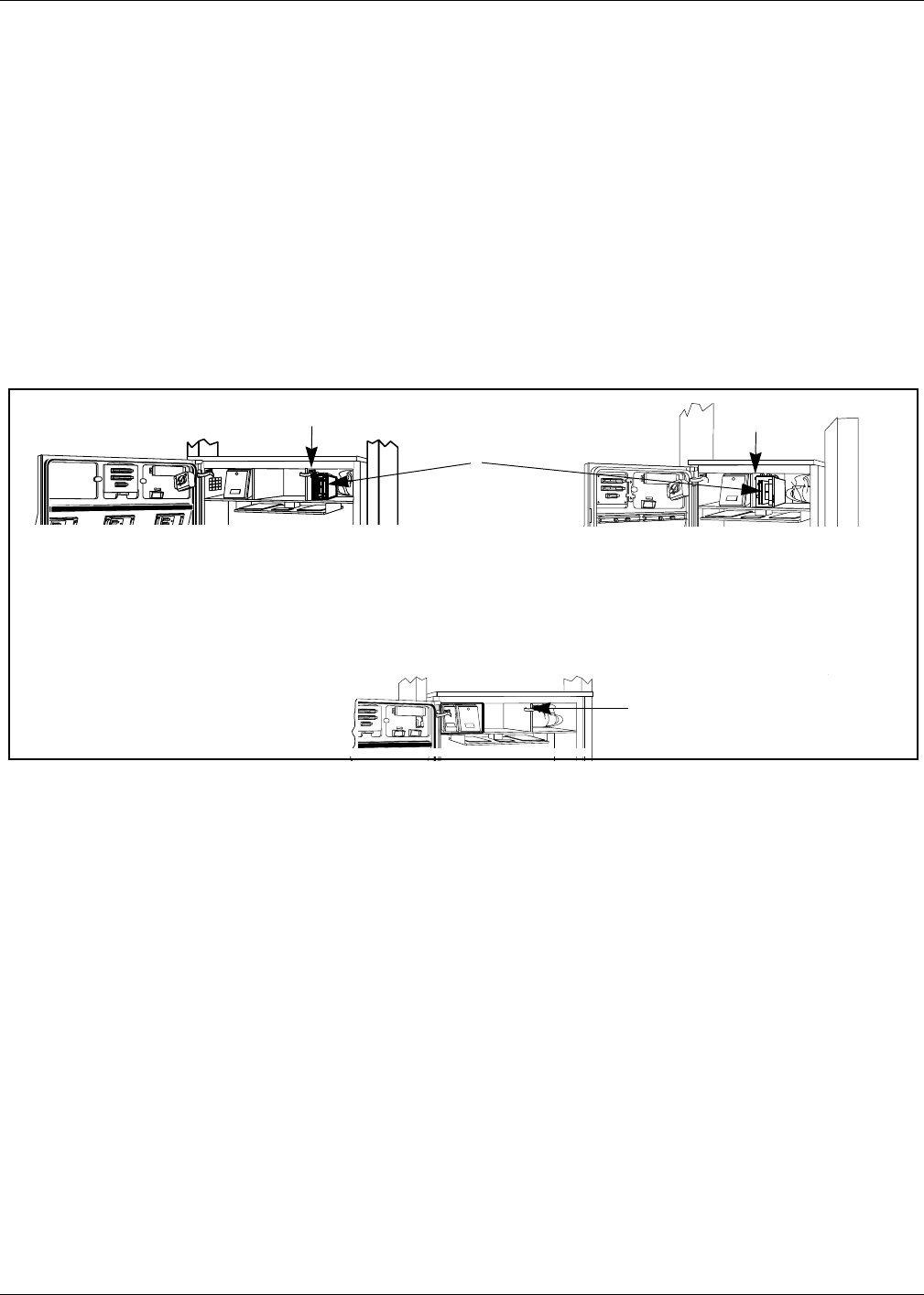
Installation Instructions for The Advantage® Series Units
Page 28 MDE-3591A TRIND™/TIRIS™ Retrofit Kits C00011-002-XXXX • 11/00
PRELIMINARY
FCC 11/30
Installing Card Cage Assembly
Install card cage assembly from ‘B’ side of unit according to the following steps:
1Carefully pry out printer cable retainer from underside of printer shelf.
2Pull printer cable out of 2 3/4" round hole from bottom, and install piece of strip
grommet Q10315-06 around perimeter of hole.
3For all single-sided units, connect dummy load connector R20526-01 to JB on low
frequency transmitter PCB Q13579-01 in card cage. See “Card Cage Assembly
T20606-G2” on page 54 for connection point.
4Install card cage assembly fuse side first on printer shelf and against center
divider behind right options door, as shown.
5Position card cage so that tab on upper left side of housing fits over latch cutout
for main door latch, securing card cage to divider.
6From ‘B’ side of unit, feed screw Q12083-13 and washer N16599-48 up through
hole in shelf into threaded hole in card cage bottom.
7Feed three prong female end of power supply cable R20580-G1 up through
grommeted hole in printer shelf to recessed receptacle on card cage assembly.
Refer to “Card Cage Assembly T20606-G2” on page 54 for connection points.
8Secure power cable R20580-G1 in cable retainer removed in Step 1, so that power
cable and printer cable are both secured, and reinstall cable retainer in
grommeted hole.
9Feeding J182 ends of cables R20773-G2 for A and B sides up through grommeted
hole and connect P1 to J1 and P2 to J2 on T20662-G2 card cage harness.
10 Return printer to shelf and reconnect two printer cables and ground connector.
11 Reorient printer and secure to shelf.
Tab Card cage assembly
front side
Tab fits over cutout behind
door latch: see step 4
Card cage assembly location behind
right options door of 36" wide unit
Card cage assembly location behind
right options door of 48" wide unit
Tab
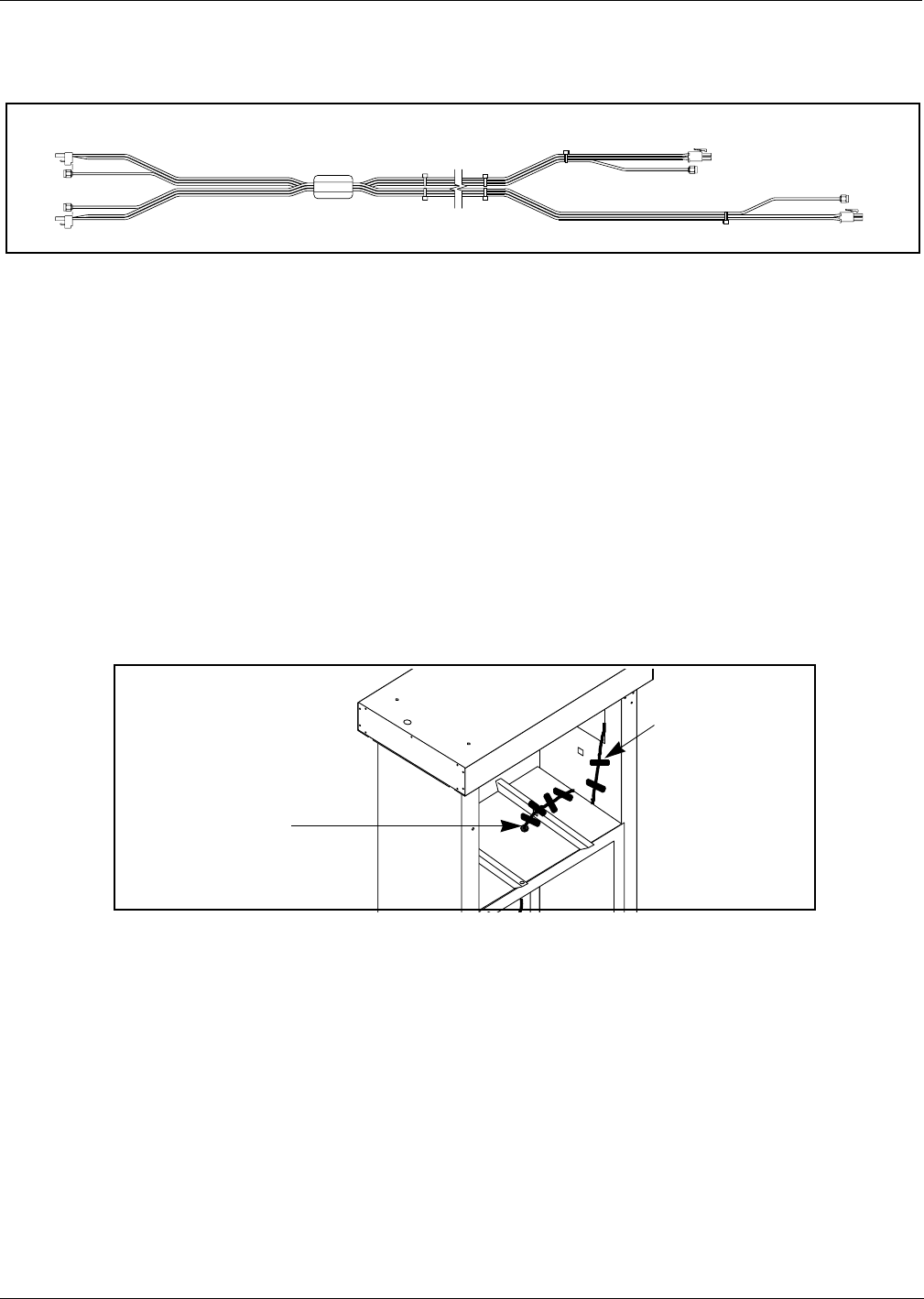
MDE-3591A TRIND™/TIRIS™ Retrofit Kits C00011-002-XXXX • 11/00 Page 29
Installation Instructions for The Advantage® Series Units
PRELIMINARY
FCC 11/30
Installing Transmitter Cables
Before proceeding be sure to be able to easily identify A and B side cable ends.
Electric tape, wire numbers or other suitable device may be used.
Note: Sharp bends in antenna cables will cause damage. All cable turns must be in
loops and gradual. Refer to “ASC TRIND™ Technology Update” on page 18.
1Feed P1A/B and /P3A/B ends of cable harness M00878A002 up through bulkhead
grommet in main cabinet.
2Be sure that there is sufficient length (24") of M00878A002 harness remaining in
electrical cabinet to reach connection points on card cage. Cables must be routed
through underside of card cage to connection points on ‘B’ side. See “Card Cage
Assembly T20606-G2” on page 54 for connection points.
3Lay cable harness flat across top of main cabinet, through gusset opening to
column as shown.
4Use electrical tape to secure cable harness flat to top of cabinet and in gusset
opening. See illustration above.
5Route cables from top of main cabinet up along inside of column, keeping cables
flat and parallel.
6Loop cable harness 3" down into space between column and main cabinet and
back up again to allow for reinstallation of inside sheathing.
Note: Turn in cables must be gradual, not sharp, to prevent damage to cables.
7Feed cables up through knockout opening in unit top cover.
PB
P2B
P2A
PA
P1B
P3B P3A
P1A
M00878A002 Cable Assembly
Cables fed through gusset
opening to column and up
inside of column.
Routing cables to
main cabinet
Cables
secured with
electrical
tape
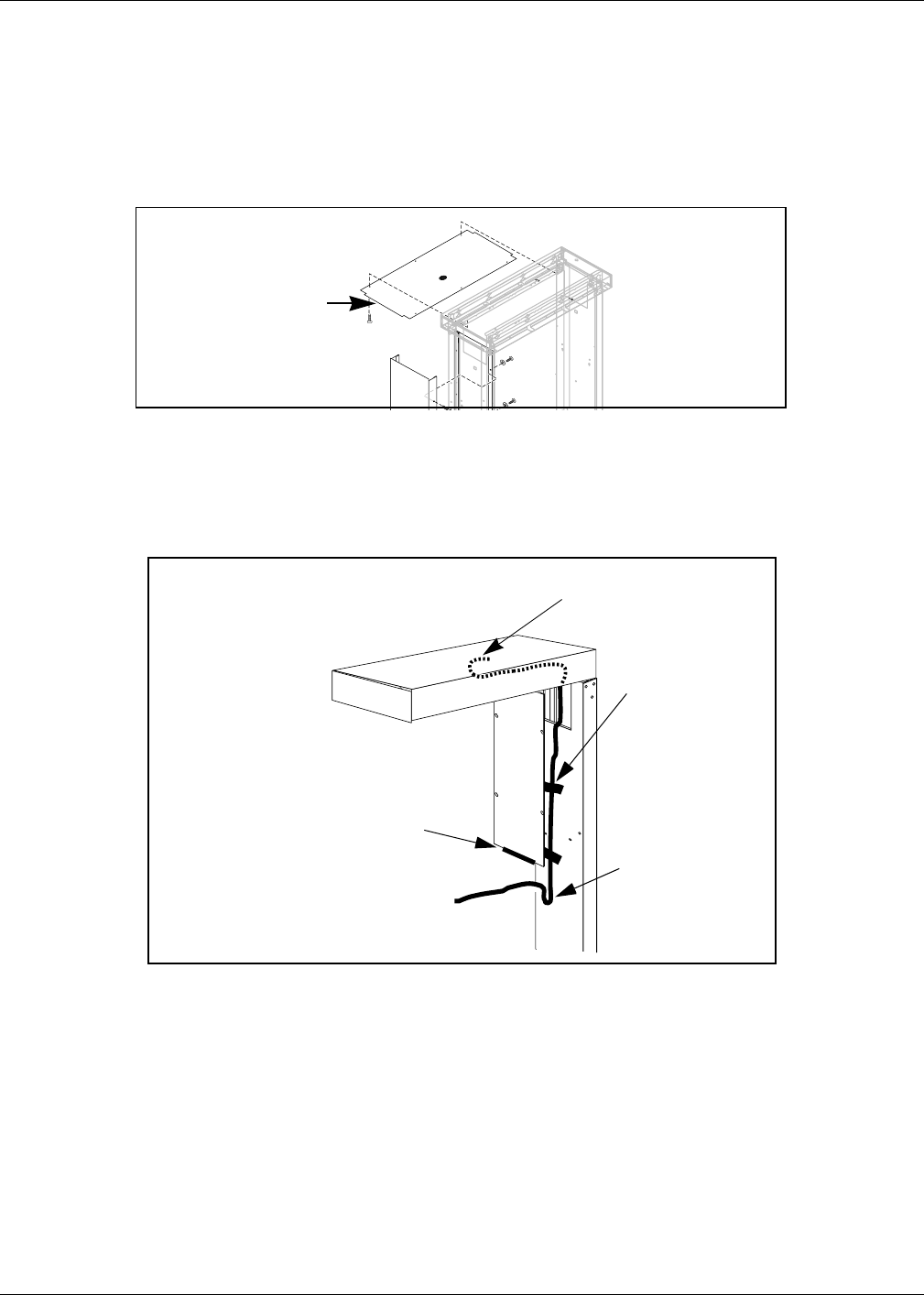
Installation Instructions for The Advantage® Series Units
Page 30 MDE-3591A TRIND™/TIRIS™ Retrofit Kits C00011-002-XXXX • 11/00
PRELIMINARY
FCC 11/30
8Without removing top sheathing, install piece of edge grommet Q10315-06 along
edge of top sheathing where cables pass in column. See exploded illustration
below.
Note: Carefully check for any points where cable harness is run where cables may
come in contact with sheet metal edges, and install edge grommet to prevent
cable damage.
9Leave cable ends in upper housing.
10 Press cable harness flat and parallel to column and secure with electric tape as
shown.
11 Install edge grommet Q10315-06 on bottom edge of inner sheathing and replace
inner sheathing, using screws saved during disassembly.
Edge grommet Q10315-06 to
protect cables from metal
edge of top sheathing
Installing edge grommet
Exploded View:
Do Not Remove
Top Sheathing
From Unit
Electrical tape
Sufficient cable
to make loop, not
sharp turn, back
up to top of main
cabinet. Sharp
bend will damage
cables
Strip grommet
Q10315-06 on
bottom edge of
inner
sheathing
Cables on column
shown without
main cabinet
cable ends in upper housing
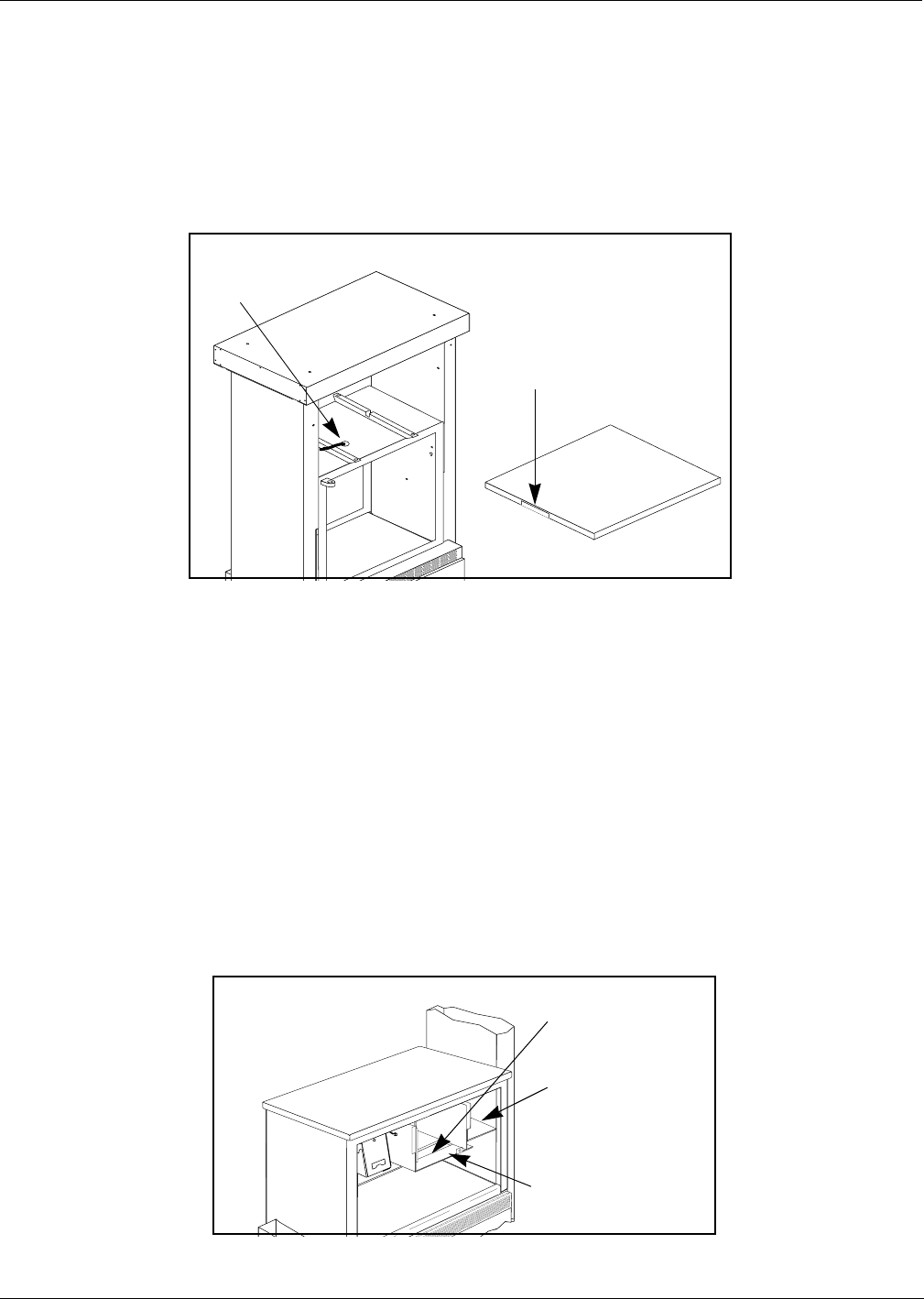
MDE-3591A TRIND™/TIRIS™ Retrofit Kits C00011-002-XXXX • 11/00 Page 31
Installation Instructions for The Advantage® Series Units
PRELIMINARY
FCC 11/30
Replacing Main Cabinet Top Cover
1Use hacksaw to cut 3/8" slots in cabinet top cover to allow strip a minimum of 6"
wide to be folded back with pliers and hammered flat as shown, to allow cables to
pass under top cover to grommet.
Note: Remove top cover from work area to cut slot. Do not cut metal in proximity to
dispensers. Place top cover on cardboard while hammering to prevent
damage to paint.
2Clean edges and burrs around cuts in cover with file or deburring tool.
3Thoroughly seal spaces around and between cables in main cabinet bulkhead
grommet with RTV sealant.
Note: Place some packaging plastic inside bulkhead grommet from top to prevent
sealant from running out bottom when applied.
Routing R20773-G2 Cables
Note: Retrofit kit comes with ten (10) adhesive-backed cable clamps (Q13558-04).
Note the following variations for routing cables to main cabinet:
Horse Shoe style CRIND™
For these units, utilize opening in printer shelf bottom for routing.
6” strip
hammered flat
under top cover
cables
Slotting top cover
Horse Shoe style
CRIND
Printer shelf
Horse shoe style module
Opening for cable
routing
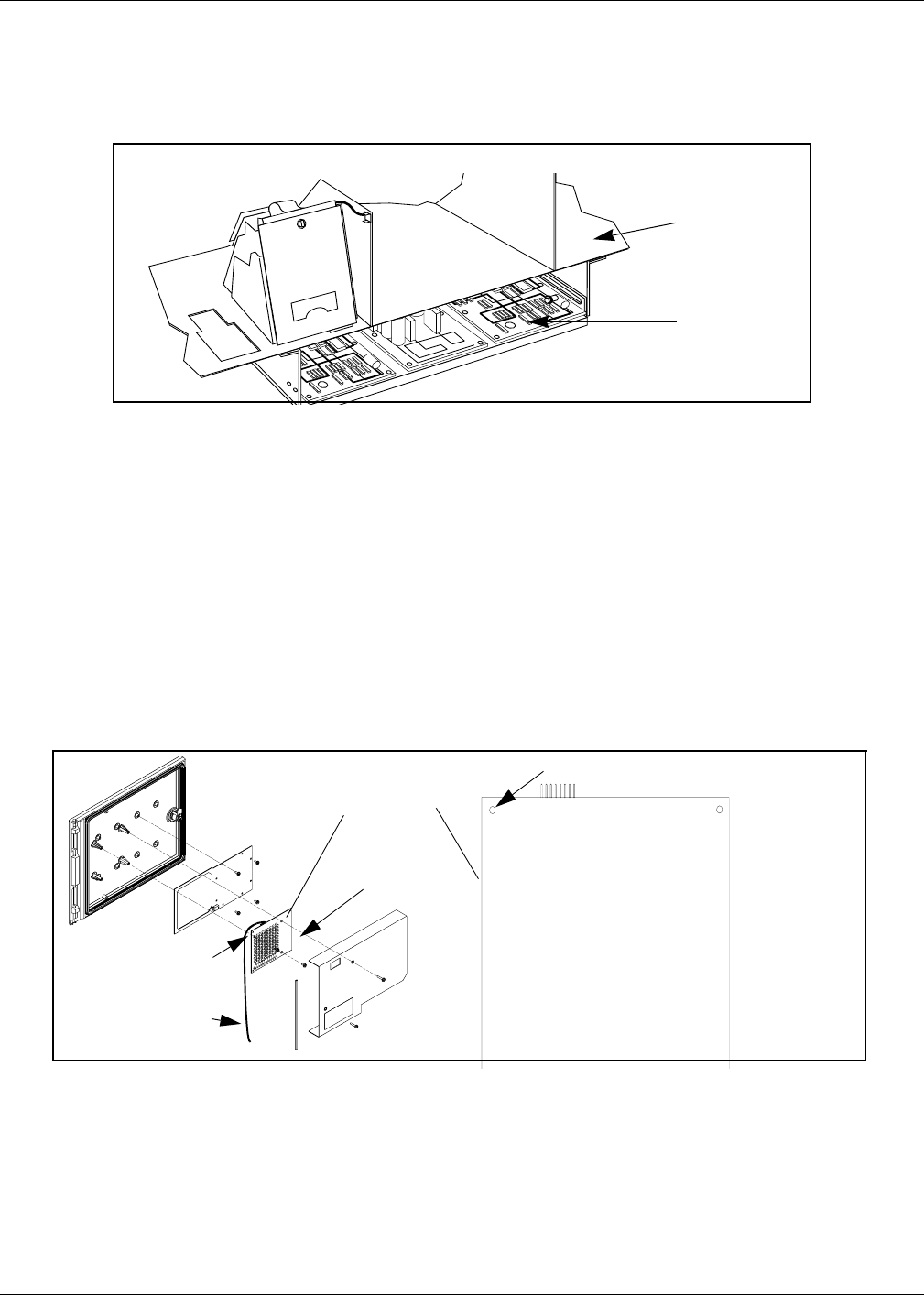
Installation Instructions for The Advantage® Series Units
Page 32 MDE-3591A TRIND™/TIRIS™ Retrofit Kits C00011-002-XXXX • 11/00
PRELIMINARY
FCC 11/30
Pull Out CRIND Tray
For these units utilize round 2-3/4" hole in printer shelf bottom, used for printer
cable. Use cable clamps to secure cables to underside of printer shelf.
Cable Routing Along Option and Main Doors
When routing door cables to card cage, leave excess cable on door, routing cable
around edges of printed circuit board.
Note: It is critical that door cables do not get crimped or pulled when either options
door or main door are opened or closed. Be sure that door cables are secured
such that they cannot be caught in main door. when door is closed, and
always close main door before options door.
1Remove option door shield
2Connect J182 connectors on R20773-G2 cables to P182 on Light/Microreader PCB
for each side right options door.
3Loosely secure cables using tie wrap Q10178-01 and hole on indicator light
printed circuit board.
4Assuring sufficient cable to reach connection points on card cage, use clamps to
secure cables to underside of lighting frame. Be sure clamps are secured to non-
removable part of frame, so access is maintained for lighting service.
Printer shelf with
2-3/4" round hole
Pull out CRIND
electronics tray
Pull Out
CRIND Tray
Indicator light
PCB T20601
P182 connection
and cable route
Hole to secure cable
with tie wrap
Hole to secure cable with tie wrap
R20773-G2 cable
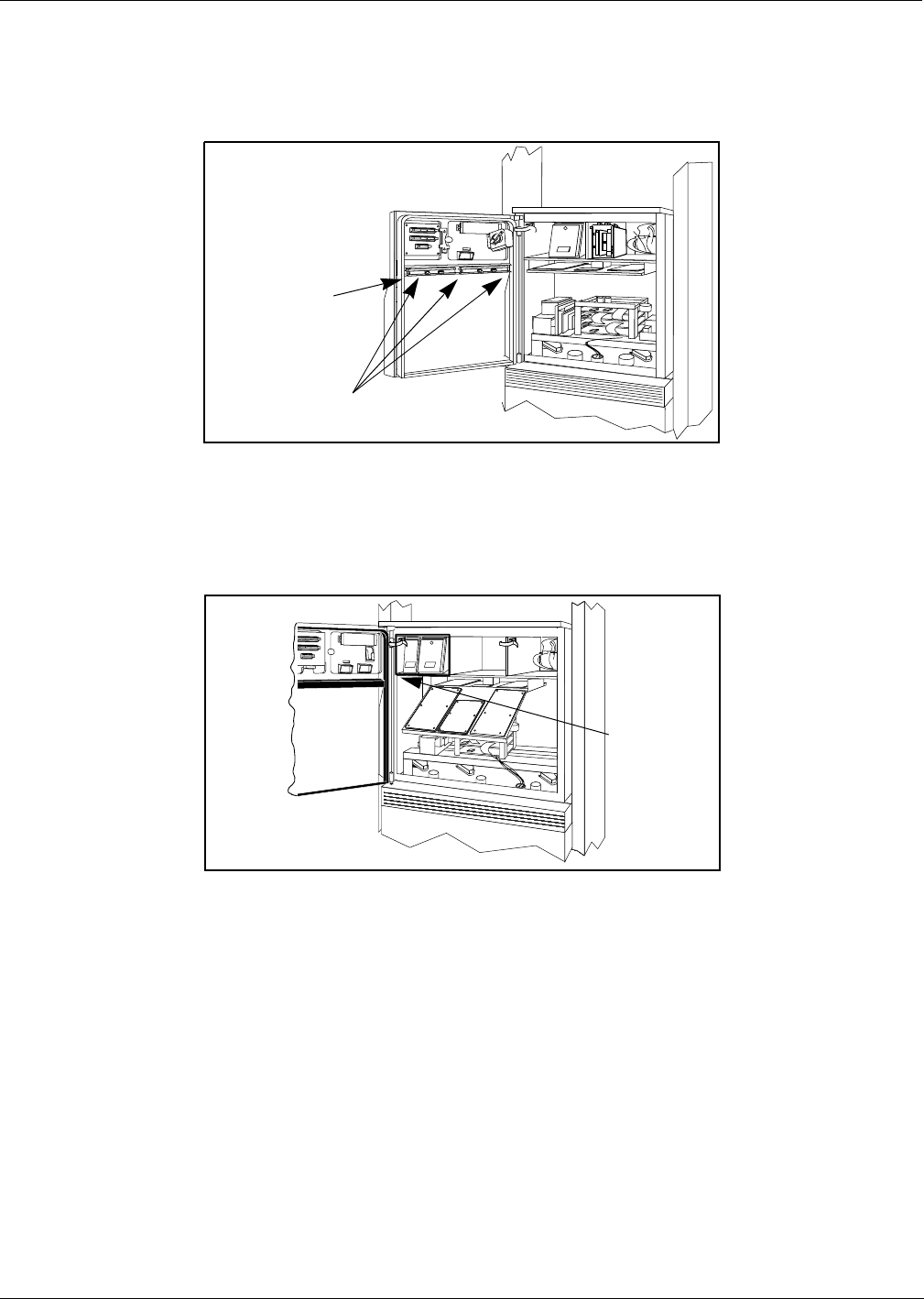
MDE-3591A TRIND™/TIRIS™ Retrofit Kits C00011-002-XXXX • 11/00 Page 33
Installation Instructions for The Advantage® Series Units
PRELIMINARY
FCC 11/30
5Being sure that option door opens and closes freely without stressing or crimping
cables, use tie wrap Q10178-01 to loosely secure cables to small fixed tab at end of
light frame, forcing cables between light frame and door gasket.
6Secure J1/J2 end of each R20773-G2 cable to existing cable clamp (for door
cabling) just inside main cabinet, allowing enough slack for main door to open and
close freely without pulling on or crimping cable. See illustrations below and on
next page.
Attach clamps and
cables to underside
of panel light frame
Loosely secure
cables to tab on
light frame with
tie wrap
R20773-G2 Cable routing on
option door
Secure cable
to existing
door cable
clamp
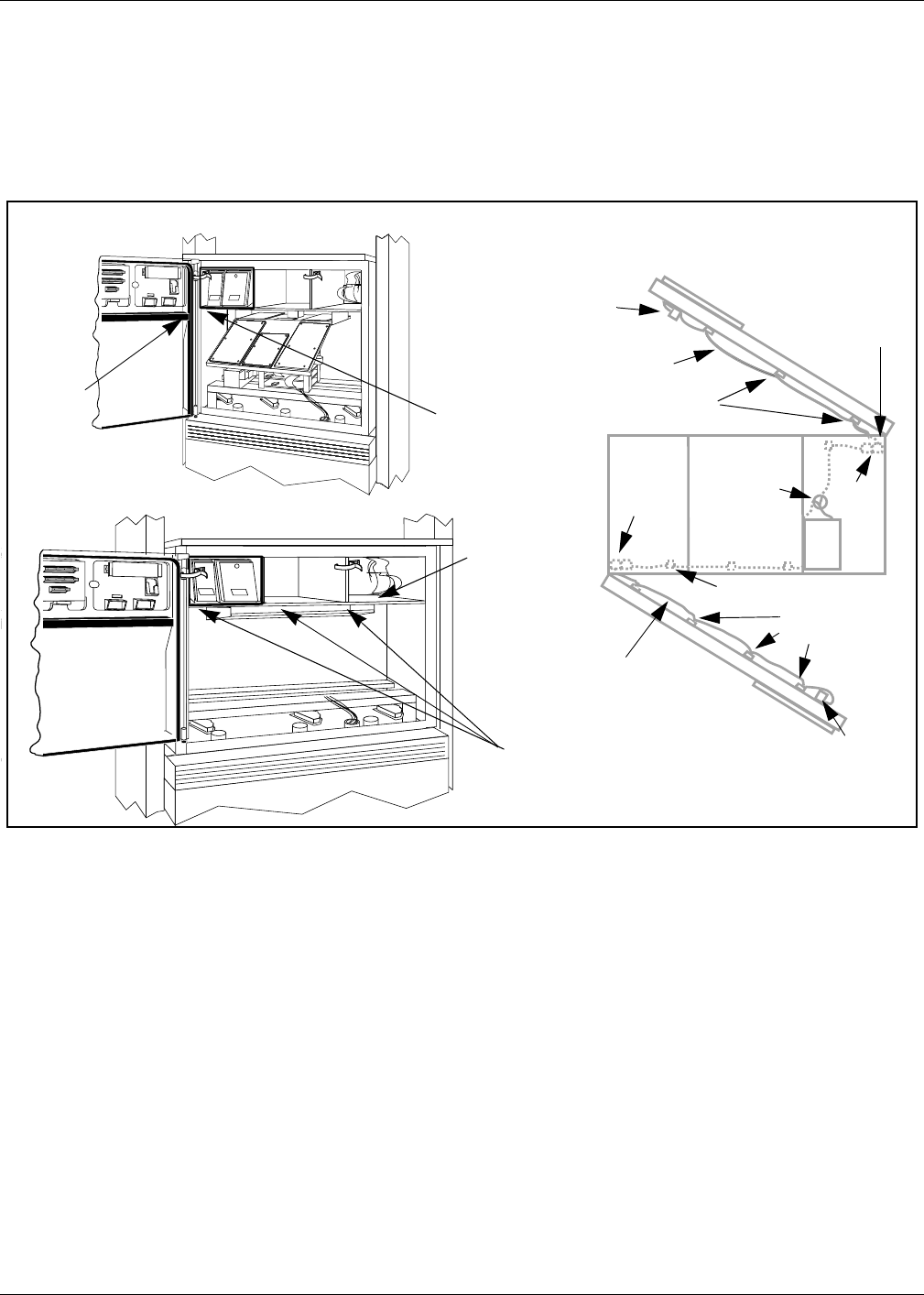
Installation Instructions for The Advantage® Series Units
Page 34 MDE-3591A TRIND™/TIRIS™ Retrofit Kits C00011-002-XXXX • 11/00
PRELIMINARY
FCC 11/30
T20662-G2 Cable Routing In Main Cabinet
Card Cage cable harness T20662-G2 contains two cables with connectors P1 and
P2. P1 for A Side is shorter of the two. Each cable is designed to extended to the
point where the main door and electronics cabinet are hinged. Feed cables
through 2-3/4" round hole in printer shelf.
Go to “Instructions for All Units” on page 45.
Stress or
crimping
point for
cables
Use clamps
to secure
cables to
underside of
shelf
A Side
Use clamps to
secure cables to
underside of
shelf
2-3/4"
round hole
for printer
cable
T20662-G2
cable routing
from card
cage under
printer shelf
B Side
B Side
A Side
Viewed from above
T20262-G2
cable fed
under shelf
through
grommeted
2 3/4’’ hole
door cable
clamp
R20773-G2 cable
P2/J2
card
cage
kit cable
clamps
P1/J1
cable clamps under shelf
R20773-G2 cable
kit cable clamps
J182/P182
J182/P182
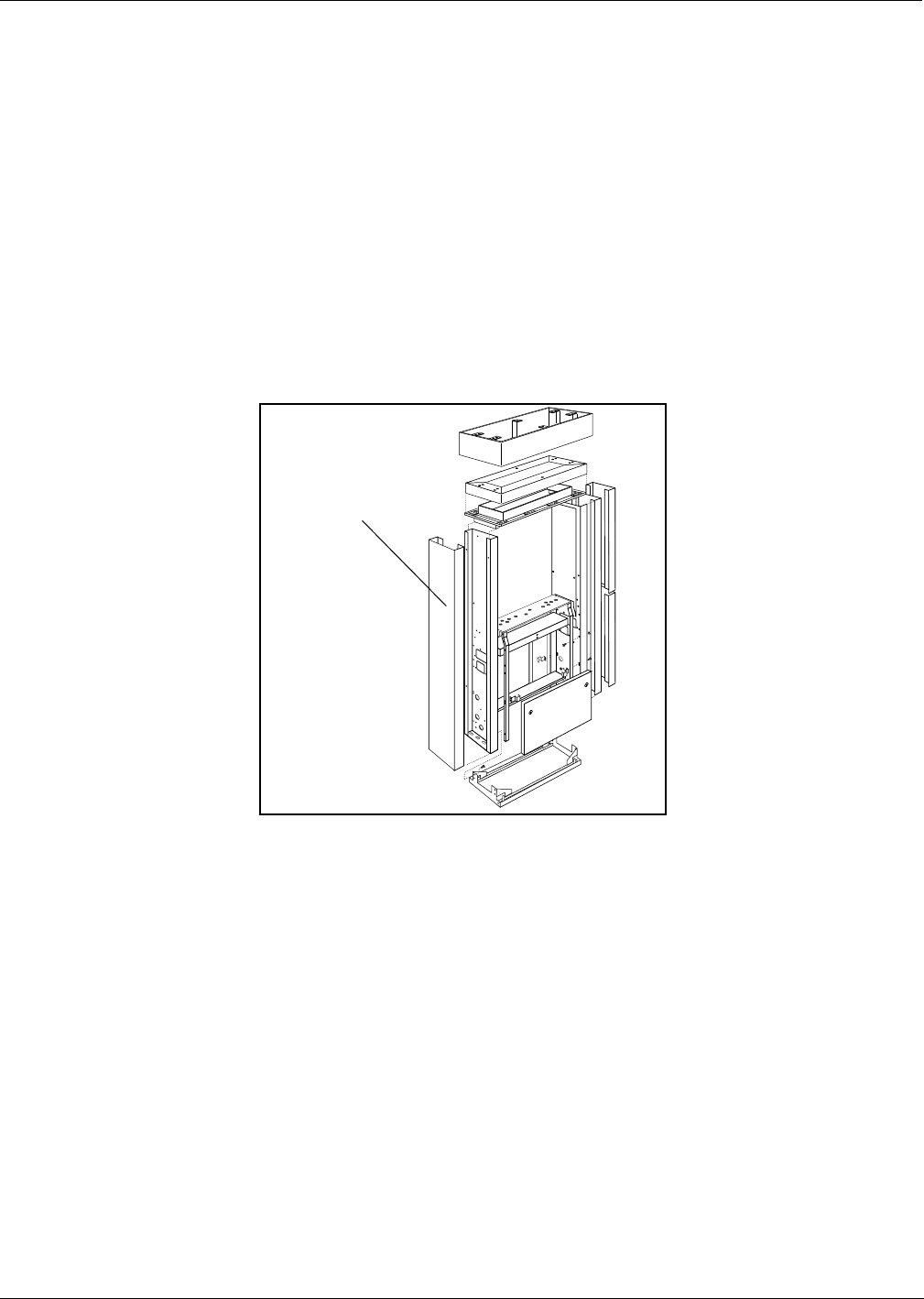
MDE-3591A TRIND™/TIRIS™ Retrofit Kits C00011-002-XXXX • 11/00 Page 35
Installation Instructions For MPD®-3 Units
PRELIMINARY
FCC 11/30
Installation Instructions For MPD®-3 Units
Before beginning read “Classifying Hazardous Locations” on page 17 and “ASC
TRIND™ Technology Update” on page 18.
The TRIND™ retrofit can only be done on MPD-3 units with CRIND™ printer on
left.
Preparing For Installation
1From ‘A’ side, remove left column outside sheathing (or top section only for two
piece sheathing).
2Temporarily secure inner sheathing to frame using tape.
3Open main access door. Refer to MDE-2531 for instructions.
Outside sheathing -
left column
A side
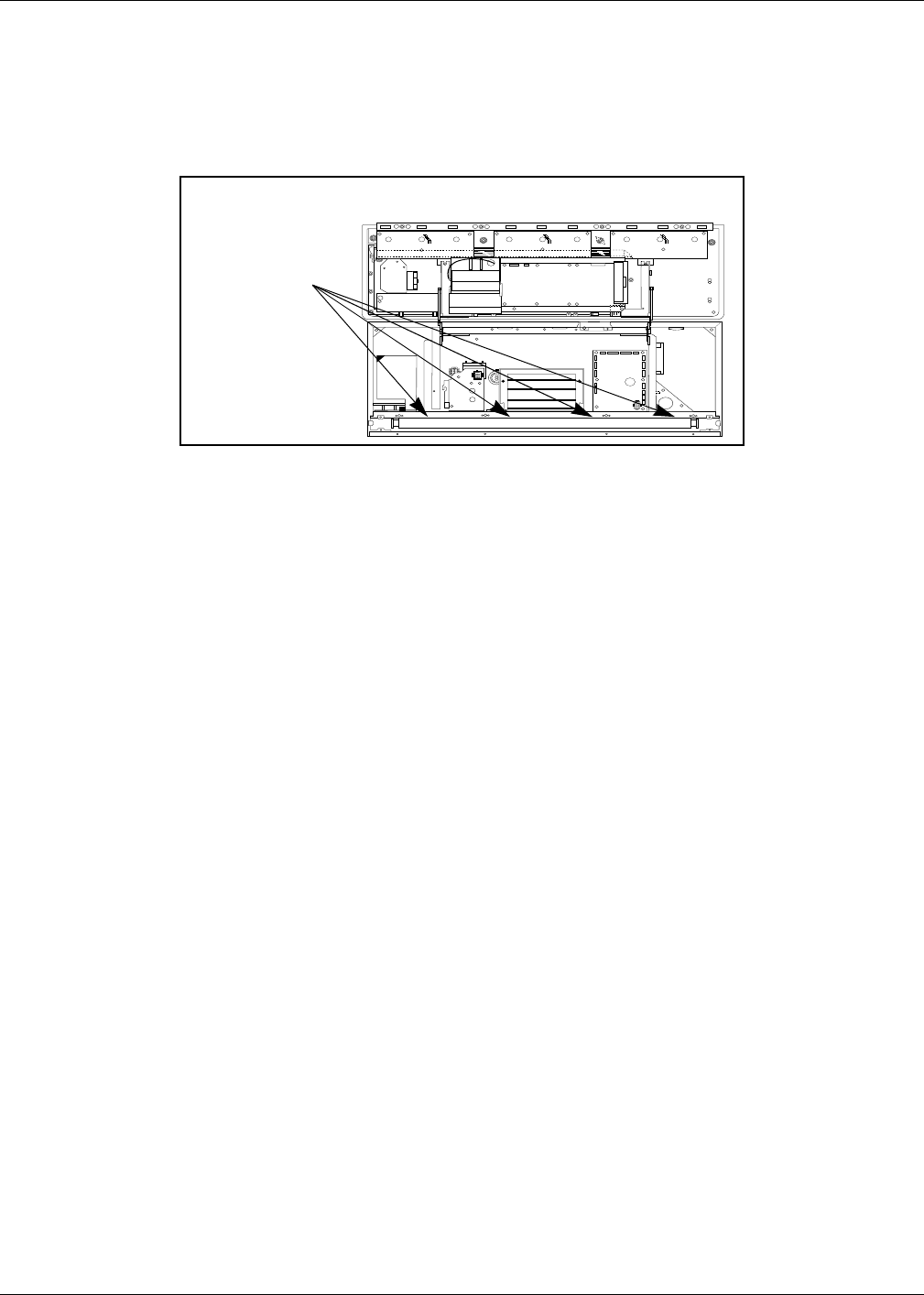
Installation Instructions For MPD®-3 Units
Page 36 MDE-3591A TRIND™/TIRIS™ Retrofit Kits C00011-002-XXXX • 11/00
PRELIMINARY
FCC 11/30
Removing Main Cabinet
1Locate four nuts on each side of main cabinet, ‘A’ and ‘B’, that secure cabinet to
frame.
2Remove all eight nuts and washers, and save for reassembly.
3Disconnect barrel connectors to allow cabinet to be removed from unit.
Note: If barrel connectors are mounted to holding plate(s), remove plates and
discard.
4Carefully lift cabinet up and off studs, and remove from fuel island.
5Remove inner sheathing on left column (viewed from ‘A’ side). Set sheathing and
screws aside for reassembly. See illustration below.
Note: For units with VaporVac®, VaporVac pan does not need to be removed.
Sheathing can be carefully pulled out from center until top bends clear of
pan.
+
+
+
++
+
+
+
+
+
+
+
+
+
+
+
+
+
+
+
+
+++
+
+
++
++
+
+
++
+
+
+
Four nuts each side, ‘A’
and ‘B’, on mounting
studs behind lip
Removing main cabinet
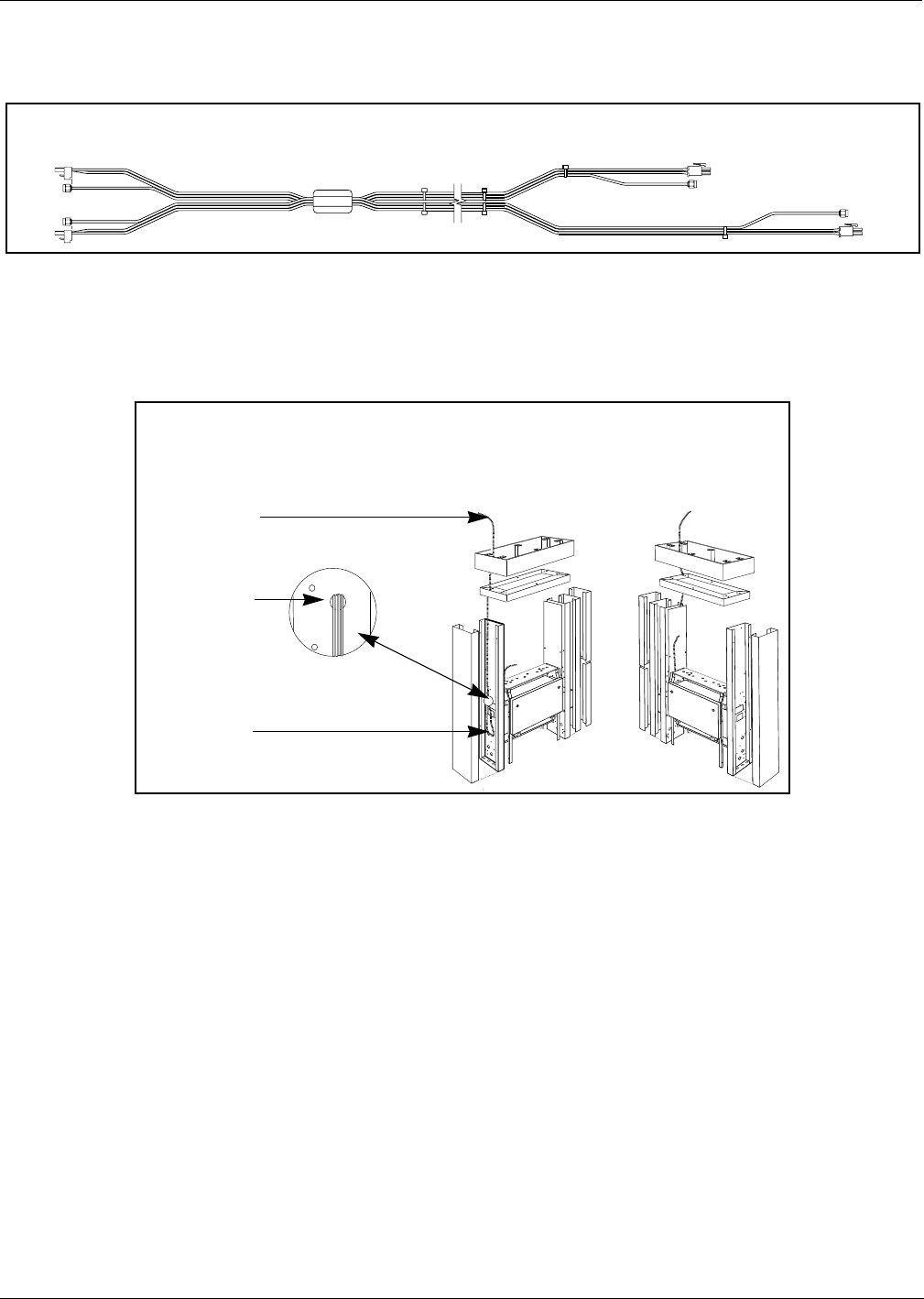
MDE-3591A TRIND™/TIRIS™ Retrofit Kits C00011-002-XXXX • 11/00 Page 37
Installation Instructions For MPD®-3 Units
PRELIMINARY
FCC 11/30
Installing Transmitter Cables
Before proceeding be sure to be able to easily identify A and B side cable ends.
Electric tape, wire numbers or other suitable device may be used as needed.
Note: Sharp bends in antenna cables will cause damage. All cable turns must be in
loops and gradual. Refer to “ASC TRIND™ Technology Update” on page 18.
1Feed cable ends PA/B and P2A/B (see illustration above) down from upper piping
housing into left column seen from ‘A’ side. Leave a minimum of 12'' of cable in
upper housing.
2Feed cables down between piping brackets and inside column.
3There are several holes in column above or below main cabinet level,
approximately 7/16" in diameter. Locate hole that provides access for using
knockout and is most closely aligned with bottom of cabinet, and open hole to 7/8"
diameter or larger.
Note: Various units have different holes and configurations. Any hole on column,
square, rectangular or round, of sufficient size or made so with knockout can
be used for cables.
4Use rounded file or deburring tool to round edges of hole. Cover edges of hole with
electric tape.
M00878A002 Cable Assembly
cables connections to card cage cable connections for upper housing
PB
P2B
P2A
PA
P1B
P3B P3A
P1A
Cable harness
Harness looped
in column
Routing M00878A002 cable harness to main cabinet
Harness fed
up through
hole
enlarged
using
knockout
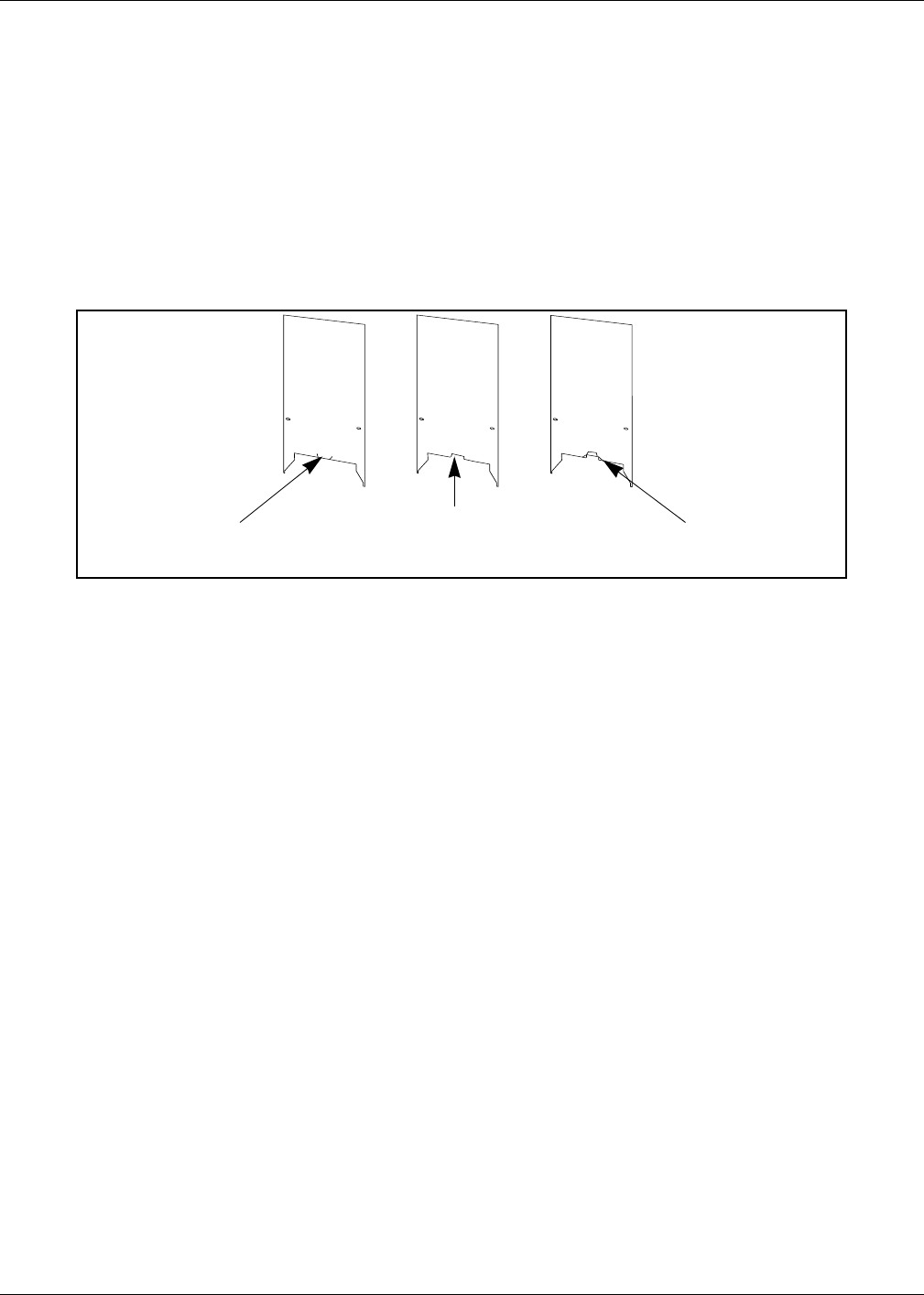
Installation Instructions For MPD®-3 Units
Page 38 MDE-3591A TRIND™/TIRIS™ Retrofit Kits C00011-002-XXXX • 11/00
PRELIMINARY
FCC 11/30
5Loop cables below hole and back up through hole and out of column.
6Feed cable ends into vapor barrier, dressing and securing cables in place with
electrical tape.
7Away from island, use snips or shears to cut slits 1-1/2" apart in bottom center of
inside sheathing at 45 degree angles. See illustration below.
8Fold pieces forward on cabinet side of sheathing. Use hammer to flatten folded
pieces as shown.
9Reposition inner sheathing and tape in place, being sure that cables pass through
opening at bottom.
10 Replace outside sheathing, and remove tape from inner sheathing.
11 Dress and secure cables on cabinet top with electrical tape.
Notching inner sheathing
Step 7:
Cut two slits 3/8"
deep at 45 degree
angle approximately
1 1/2" apart in
bottom center of
sheathing
Step 8: Use pliers to fold pieces in direction of cabinet
and away from column. Use hammer to flatten
Finished inner
sheathing - side
facing main cabinet
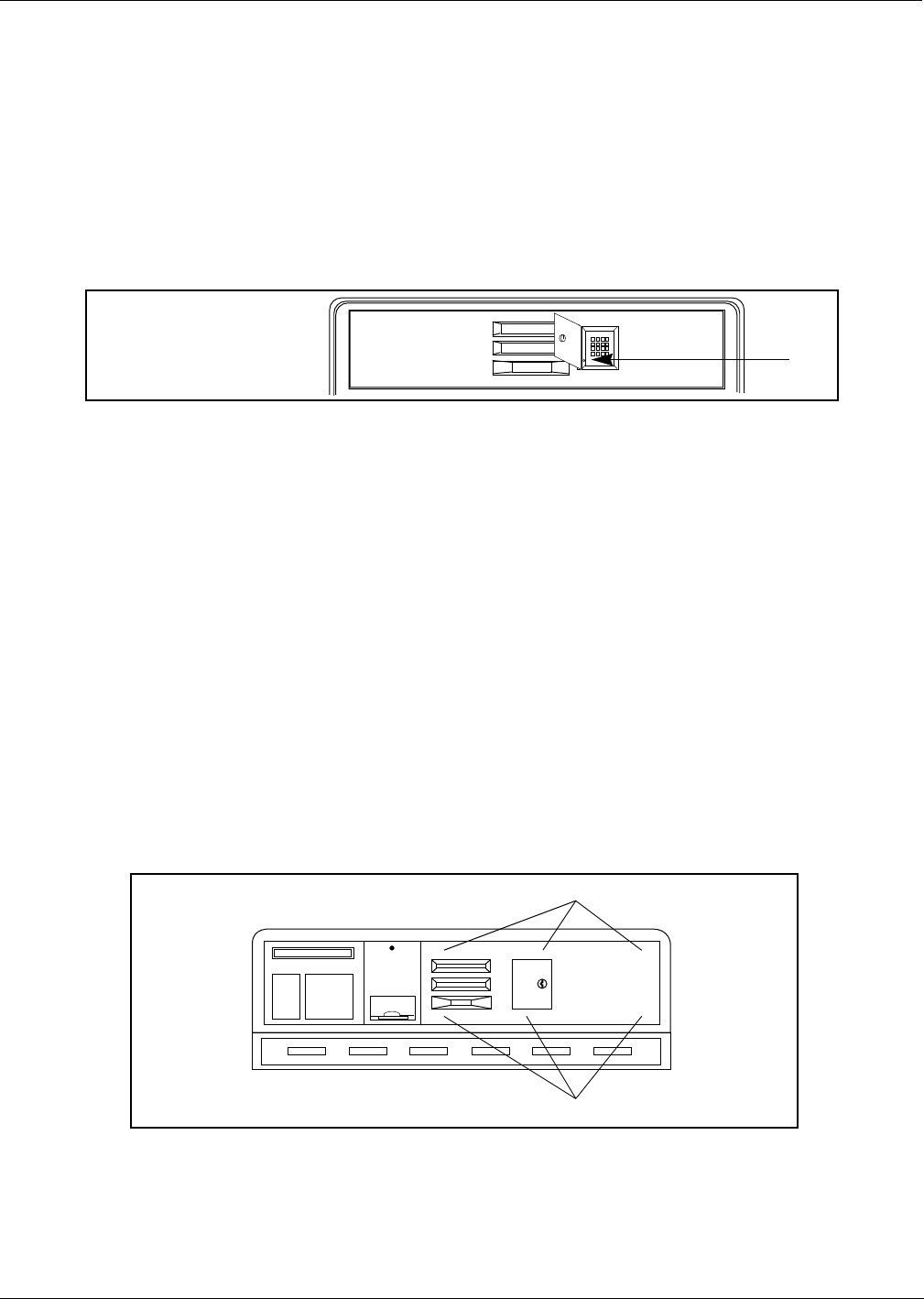
MDE-3591A TRIND™/TIRIS™ Retrofit Kits C00011-002-XXXX • 11/00 Page 39
Installation Instructions For MPD®-3 Units
PRELIMINARY
FCC 11/30
Removing Faceplate
MPD-3 units have two types of faceplates; slide-in (PMI bezel) and bolt-on (Mack
bezel). Follow directions for the type of faceplate and bezel that applies.
For units with slide-in faceplates on PMI bezels, do the following:
1 Release right side faceplate using keyswitch.
2Open manager keypad door and remove single screw.
3Gently force faceplate up, and slide tip of knife or flat blade screwdriver under
bottom edge of faceplate.
4Pry bottom of faceplate away from unit, until faceplate can be removed from unit.
5Dispose of faceplate.
For units with bolt-on faceplates on Mack bezels, do the following:
1Open bezel door and lift until door is latched open.
2Disconnect cable between manager keypad and logic board on bezel door, and
discard cable.
3Locate six sets of nuts and washers on studs securing faceplate to bezel door, and
remove hardware.
Note: This may require removing mounting hardware from price per unit (PPU)
and CRIND™ logic boards to gain access.
4Remove 6 sets of nuts and washers from faceplate studs and remove faceplate.
Dispose of hardware and faceplate.
5With putty knife, remove keypad door gasket and any adhesive residue.
Screw
Removing faceplate
Stud locations behind faceplate
Stud locations behind faceplate
Faceplate stud
locations on
Mack bezels
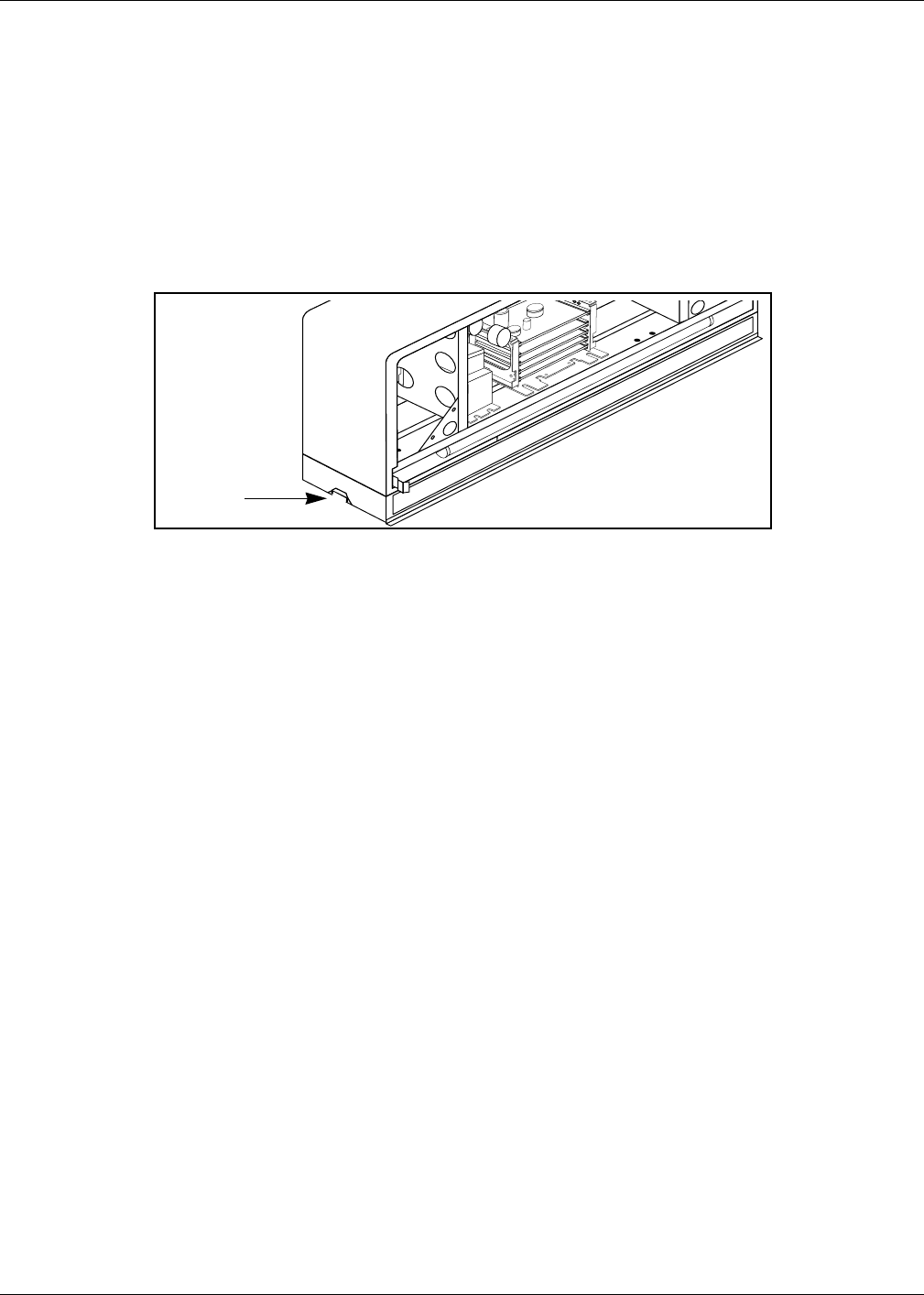
Installation Instructions For MPD®-3 Units
Page 40 MDE-3591A TRIND™/TIRIS™ Retrofit Kits C00011-002-XXXX • 11/00
PRELIMINARY
FCC 11/30
Routing Cables into Main Cabinet
1Open bezel doors on main cabinet.
2Locate indent on rear of door behind 3/4" diameter unopened access point.
3Use 3/4" drill bit to open hole in plastic door from rear of door.
Note: If electric drill is used work must be 20’ from fuel island.
4Use deburring tool or file to round edges of hole.
5On left side of main cabinet (viewed from ‘A’ side), in center bottom of wrapper,
use snips to cut two 3/8" slits at 45 degree angle.
Note: Slots and folds duplicate those done on inner sheathing. See illustration on
page 38.
6Fold pieces out from cabinet and press flat against wrapper from outside.
7Carefully return cabinet to unit, and lower cabinet on to studs.
8Feed cables up into cabinet under slot made in wrapper.
9Secure cabinet in place with nuts and washers removed with cabinet.
10 Heavily seal around cable entry slot with RTV sealant from inside cabinet.
11 Reconnect barrel connectors.
Center of left side
wrapper, slotted for
cable feed
Reinstalling main
cabinet
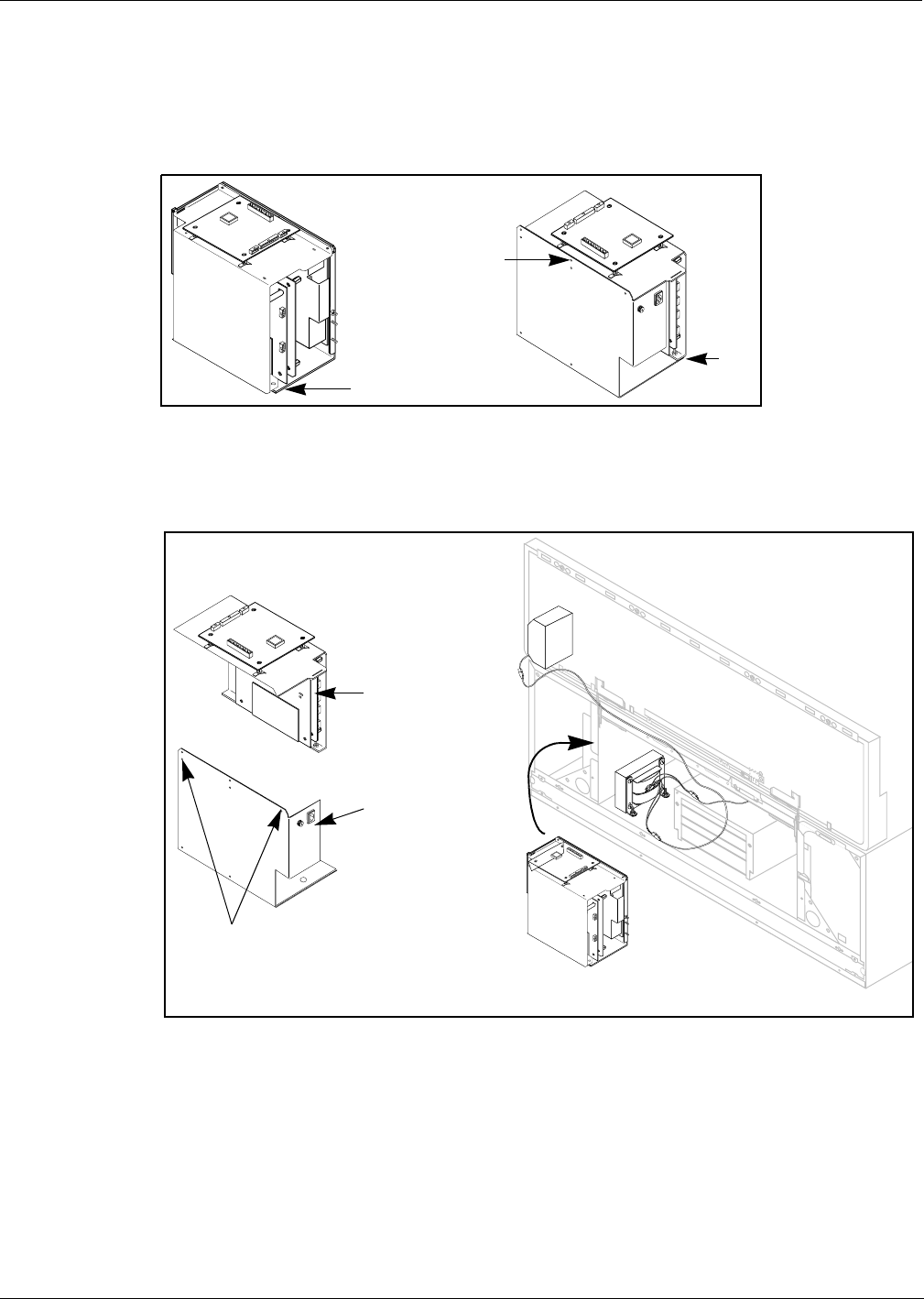
MDE-3591A TRIND™/TIRIS™ Retrofit Kits C00011-002-XXXX • 11/00 Page 41
Installation Instructions For MPD®-3 Units
PRELIMINARY
FCC 11/30
Installing Card Cage Assembly
Install card cage assembly from ‘A’ side of unit, according to the following steps:
1Begin to separate card cage assembly into two pieces by removing one screw on
top and two nuts at bottom, one each front and rear.
2Disconnect cables joining two sides of card cage.
3From ‘A’ side, place bottom section of card cage fuse side first on to left shelf.
4Reassemble card cage using nuts removed in Step 1 and two (2) tie wraps in place
of screw and reconnect cables.
5For all single-sided units, connect dummy load connector R20526-01 to JB on
transmitter PCB. See “Card Cage Assembly T20606-G2” on page 54 for
connection point.
6For all units, from ‘A’ side of unit, fasten card cage to shelf using 6-32 x 3/8" screw
(Q12083-13) supplied with kit.
Screw
Nut
Nut
Card cage
assembly
+
+
+
+
Installing disassembled
card cage
Card cage installation location from ‘A’ side
Bottom section of
card cage, fuse side
Top section of
card cage
Tie wraps (2) at each corner
to reassemble card cage
rather than screw
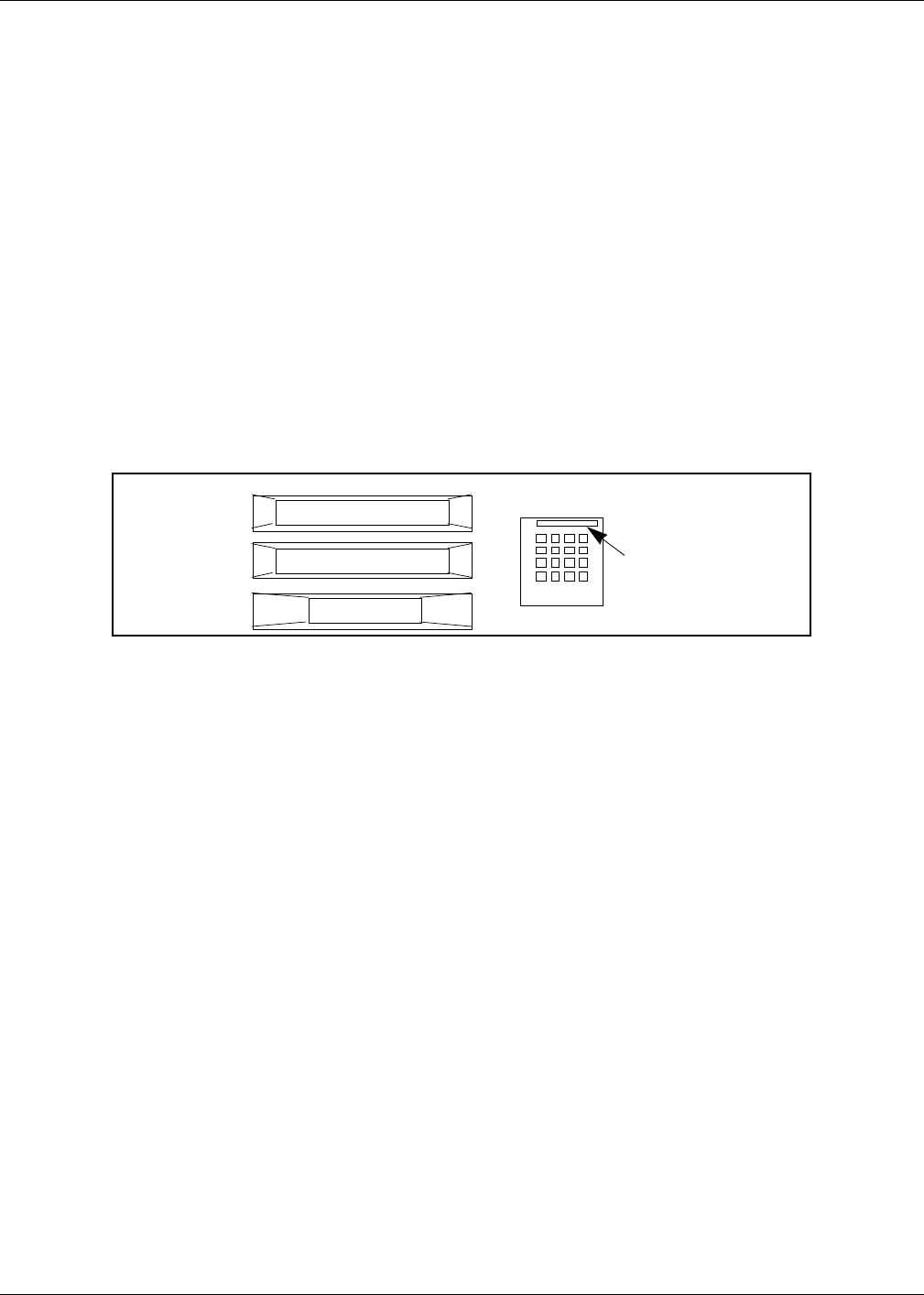
Installation Instructions For MPD®-3 Units
Page 42 MDE-3591A TRIND™/TIRIS™ Retrofit Kits C00011-002-XXXX • 11/00
PRELIMINARY
FCC 11/30
Installing TRIND™ Faceplate Assembly.
Perform the following steps for each side of unit.
For installing TRIND slide-in faceplates on PMI bezels, do the following:
1Remove new TRIND faceplate assembly from box. For ‘B’ side faceplates only, feed
faceplate cables back into faceplate housing through round hole in shield to
shorten cable leads.
Note: ‘B’ side cables have a shorter run to card cage than ‘A’ side.
2Peel adhesive backing off round gasket N23881-01. Install gasket adhesive side
first to sheet metal shield on back of faceplate to form seal around hole for cables
on faceplate assembly.
3Peel paper backing off adhesive strip on rectangular locking plate N23873-G1 and
install plate along top lip of manager keypad recess.
4Feed ends of cables R20773-G2 through 3/4" hole on bezel door drilled in Step 3 of
“Routing Cables into Main Cabinet” on page 40. Pull slack cable through hole.
5Follow these directions to install new TRIND faceplate:
•Feed top edge of faceplate in to groove on top of door.
•Gently push bottom of faceplate in until faceplate drops into bottom groove.
Note: Faceplate may be tight fit. If needed, with faceplate forced up into top groove,
firmly hit faceplate along bottom edge with palm of hand until faceplate is in
bottom groove.
•Secure in place with keylock.
6Refer to MDE-2620, Graphics Panel Application for instructions on installing
graphics.
For installing TRIND™ bolt-on (stud type) faceplates, do the following:
1Remove new TRIND faceplate assembly from box. For ‘B’ side faceplates only, feed
faceplate cables R20773-G2 back into faceplate housing through round hole in
shield to shorten cable leads.
Note: ‘B’ side cables have a shorter run to card cage than ‘A’ side.
2Remove existing manager keypad from bezel door, and use putty knife to remove
keypad gasket and adhesive residue from door.
Locking plate N23873-G1
with adhesive backing
Installing
locking
plate
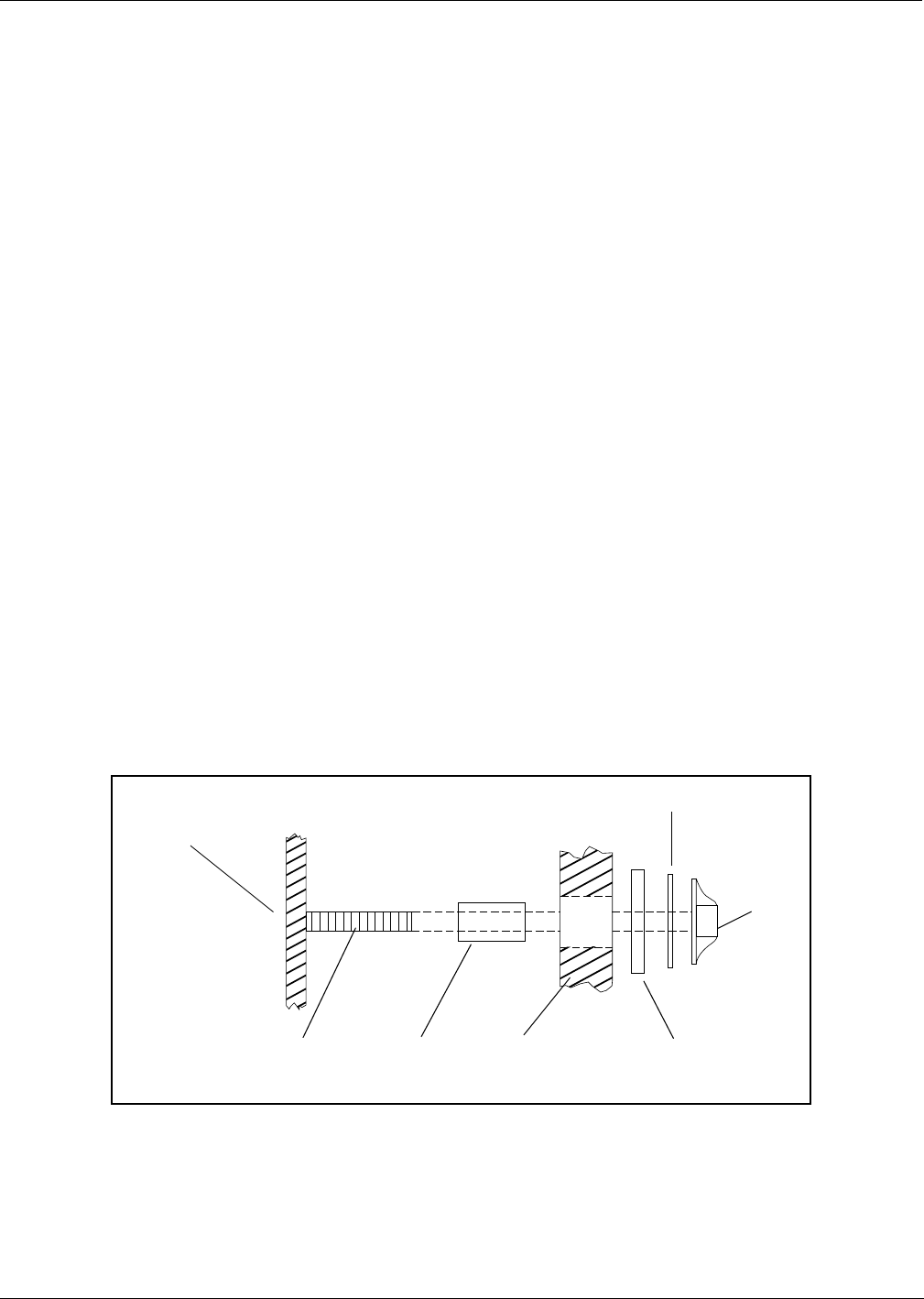
MDE-3591A TRIND™/TIRIS™ Retrofit Kits C00011-002-XXXX • 11/00 Page 43
Installation Instructions For MPD®-3 Units
PRELIMINARY
FCC 11/30
3Replace the door gasket removed in step 2 with adhesive backed gasket Q11659-
01.
4Replace existing keypad and keypad cable with T17549-G1 keypad and long cable
R18163-G1, but do not install keypad on bezel door.
Note: At user’s discretion, new keypad can be placed behind brand panel lighting
or in the well behind the printer door, on either side of printer, provided cable
is run and secured properly and safe access is maintained.
5Remove yellow tape on back of bezel door covering round hole.
6Peel adhesive backing off round gasket N23881-01. Install gasket adhesive side
first to seal around hole on back of bezel door.
7Feed ends of cables R20773-G2 through 3/4" hole on door and pull slack cable
through hole.
8Install 6 split spacers K87404-01 on the faceplate side of the bezel door, in the
mounting holes for the faceplate. See illustration on this page.
9Install faceplate assembly T17534-XX securing in place from back side of bezel
door using in this order:
•6 adhesive backed gaskets, Q11659-01.
Note: Do not remove paper backing on adhesive side, and install paper side to bezel
door.
•6 flat washers, N16599-01
•6 self-locking nuts, Q10218-04
10 Refer to MDE-2620, Graphics Panel Application for instructions on installing
graphics.
TRIND faceplate
BezelFaceplate
stud
Split spacer Gasket, adhesive
backed with paper left
on and facing bezel
Washer
Nut
Faceplate mounting hardware
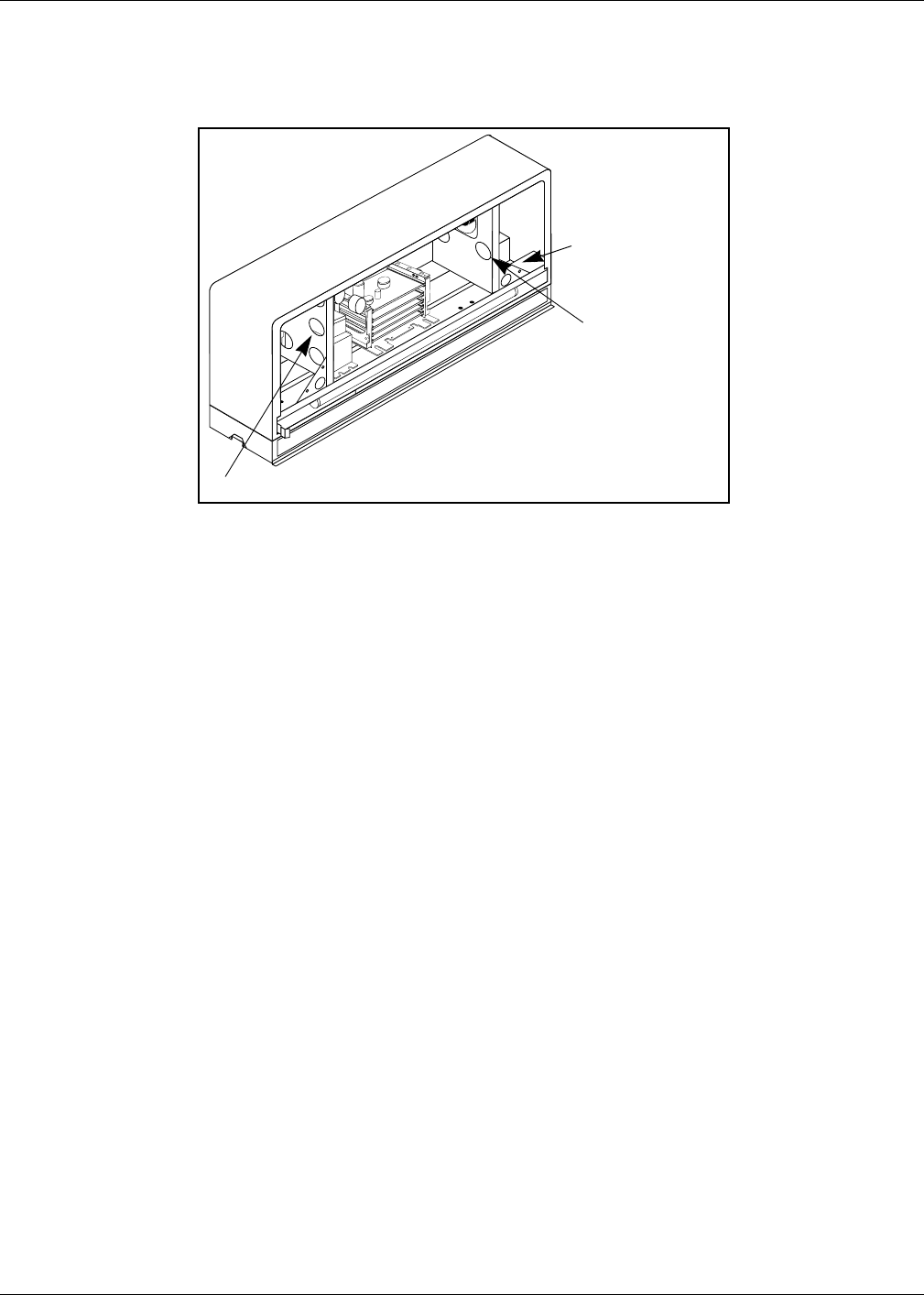
Installation Instructions For MPD®-3 Units
Page 44 MDE-3591A TRIND™/TIRIS™ Retrofit Kits C00011-002-XXXX • 11/00
PRELIMINARY
FCC 11/30
Routing Cables in Main Cabinet
Kit comes with ten cable clamps (Q13558-04).
Install strip grommet Q10277-02 in 1-1/2" hole for power cable R20850-01.
Note: Route cables on ‘B’’ side to card cage so that all cables are between card cage
and shelf where possible, or door will not close without potential damage to
cables or hardware.
Routing cables in
main cabinet
Existing snap-in 1 1/2" bushings- use for routing
Bundle cables
between shelf wall
and card cage,
using clamp
‘B’ side
Install Q10277-02
strip grommet for
power cable
R20580-G1
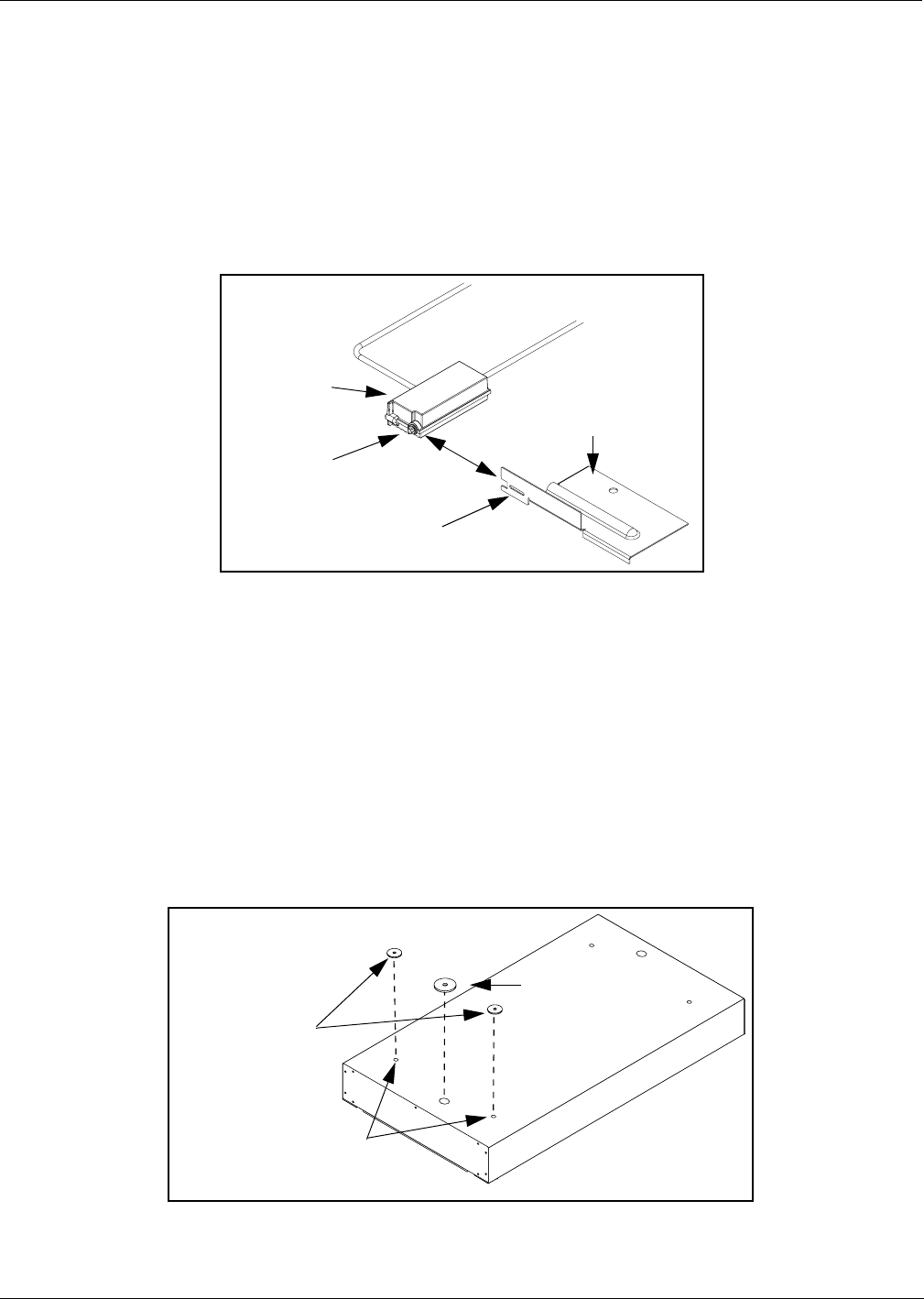
MDE-3591A TRIND™/TIRIS™ Retrofit Kits C00011-002-XXXX • 11/00 Page 45
Instructions for All Units
PRELIMINARY
FCC 11/30
Instructions for All Units
Installing Overhead Antennas and Brackets
For All Units
Do the following:
1For each antenna assembly mounting box, remove screw.
2Slide bracket slot over mounting box until antenna is secured in bracket.
3Replace screw.
For Units Without Light Boxes
Note: For units with Light Boxes proceed to “For Units With Exxon Light Boxes” on
page 47.
To seal top cover, do the following:
1Peel adhesive backing off small gaskets N23958-01.
screw
antenna box
slot
bracket
Antenna wire gasket
N23959-01 adhesive side
down
Lifting hook holes
N23958-01 gaskets,
adhesive side down
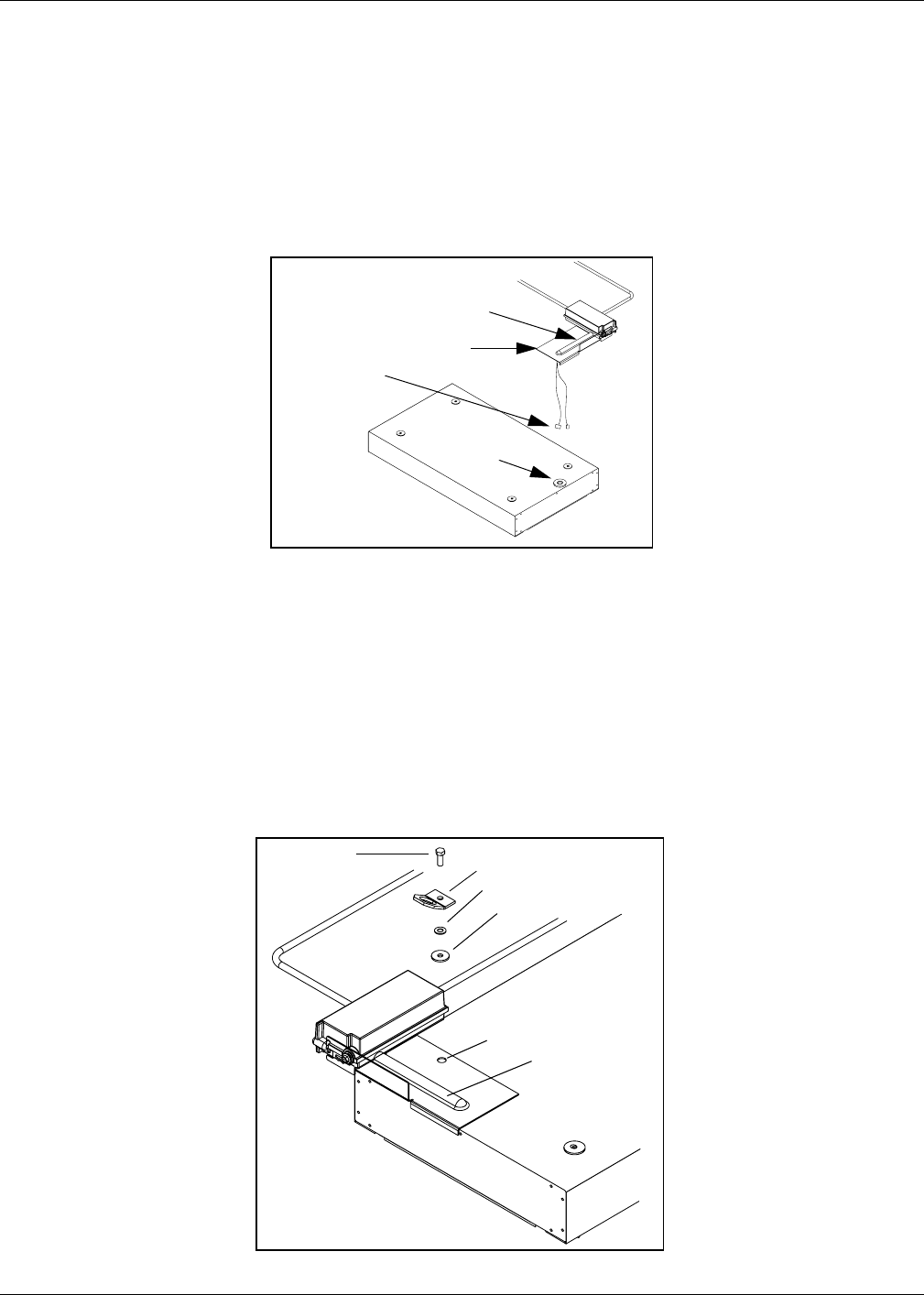
Instructions for All Units
Page 46 MDE-3591A TRIND™/TIRIS™ Retrofit Kits C00011-002-XXXX • 11/00
PRELIMINARY
FCC 11/30
2Center gaskets with lifting hook holes and install adhesive side down.
3Peel adhesive backing off large gasket N23959-01.
4Center gasket with knockout hole and install adhesive side down.
Routing Antenna Cables to Upper Housing
1Carefully feed connector ends of P1A/B and P3A/B cables through antenna gasket
on knockout opening to upper housing.
Note: Cables will always be on the left side of antenna assembly when facing unit.
2Being sure that cables are contained in raised bracket cable channel, position
antenna and brackets for mounting by aligning mounting hole on bracket with
lifting hook hole.
Installing Brackets
Bracket
Bracket cable
channel
Antenna
gasket
Cable
connectors
bolt lifting bracket
metal washer
rubber washer
bracket mounting hole
raised cable
channel
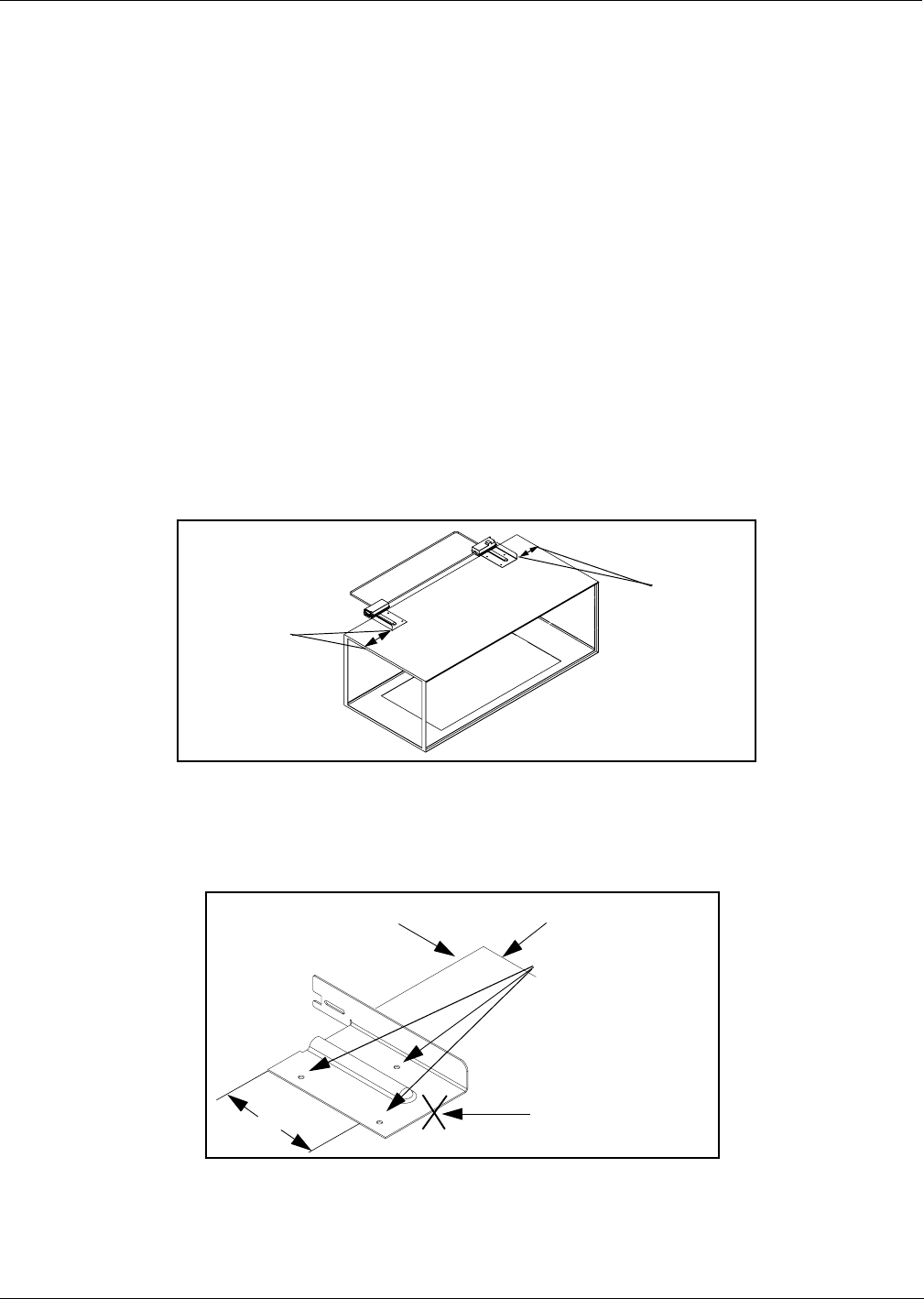
MDE-3591A TRIND™/TIRIS™ Retrofit Kits C00011-002-XXXX • 11/00 Page 47
Instructions for All Units
PRELIMINARY
FCC 11/30
Do the following:
1For brackets attached to cable side of antenna assembly, be sure that cables are
contained in raised bracket channel.
2For all brackets, with or without cables, position rubber washer, metal washer
and lifting bracket removed in “Preparing For Installation” on page 19 over
bracket mounting hole.
3Secure with bolt removed in “Preparing For Installation” on page 19. Repeat for
all brackets and sides.
4Proceed to “Sealing Antenna Bracket with Cables on All Units” on page 49.
For Units With Exxon Light Boxes
Do the following:
1Place assembled antenna and bracket (as completed in “For All Units” on page 45)
on A or B side of top of Light Box, as shown.
2Center assembly by measuring equal distances from each end of Light Box.
3Use center punch to mark centers of three mounting holes per bracket.
4For bracket side with antenna cables only, place a mark on Light Box top at
center of cable channel.
Note: Cables will always be on the left side of antenna assembly when facing unit.
Measurement
from near side
of bracket to
edge of Light
Box = X
Measurement
from near side
of bracket to
edge of Light
Box = X
bracket mounting holes
mark at center of raised
channel
long side of Light Box short side of Light Box
6 3/4’’
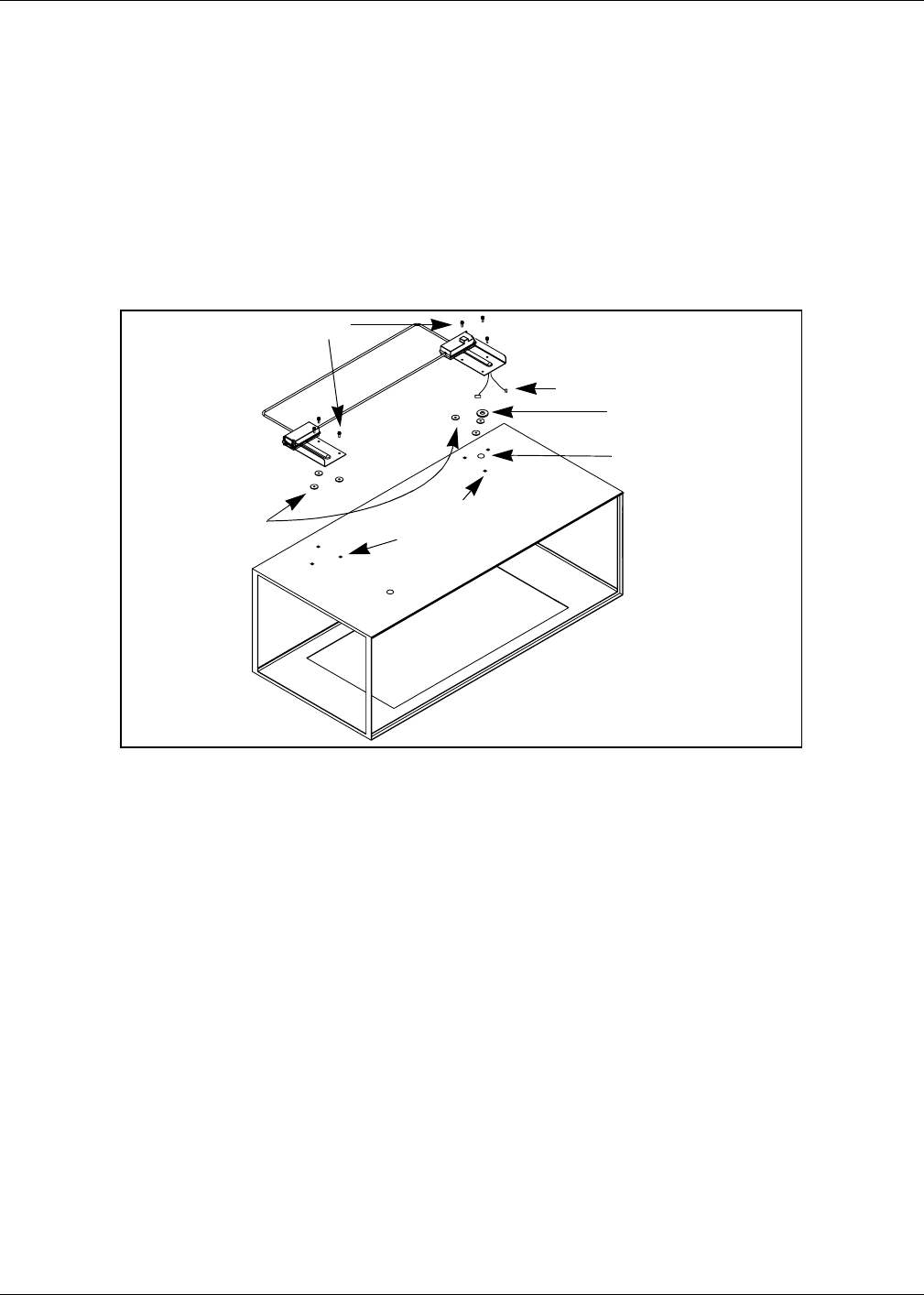
Instructions for All Units
Page 48 MDE-3591A TRIND™/TIRIS™ Retrofit Kits C00011-002-XXXX • 11/00
PRELIMINARY
FCC 11/30
5Remove antenna and bracket assembly from top of Light Box.
6Use carpenter’s square to draw line from long side of Light Box to mark.
7Measure along line 6 3/4'' from Light Box long side and mark with center punch.
8Drill 7/8'' diameter hole at center punch mark. Use file to clean sharp edges and
burrs from hole perimeter.
Installing Antenna Assemblies on Light Box
Do the following per side:
1Peel adhesive backing off gaskets N23958-01 (3 per bracket supplied with kit),
and apply adhesive side down and centered on three center punches per bracket
(marked in Step 3 on page 47).
2Peel adhesive backing off gasket N23959-01 (1 per antenna assembly) and apply
adhesive side down and centered on 7/8'' hole made in Step 8 on page 48.
Note: Gasket is only used on side of antenna assembly containing cables.
3Feed connector ends of cables through N23959-01 gasket and into Light Box.
4Being careful to keep cables in bracket channel, feed excess cable into Light Box
and position antenna assembly so that bracket holes (3 each) are aligned with
gaskets and center punches.
5Use self-tapping screws (3 per bracket) supplied with kit to secure bracket to top
of Light Box.
antenna cables
N23959-01 cable gasket for
7/8’’ cable access hole
7/8’’ hole
self-tapping screws (3 per bracket)
Gaskets N23958-01
(3 per bracket)
center punch
marks (3 per
bracket)
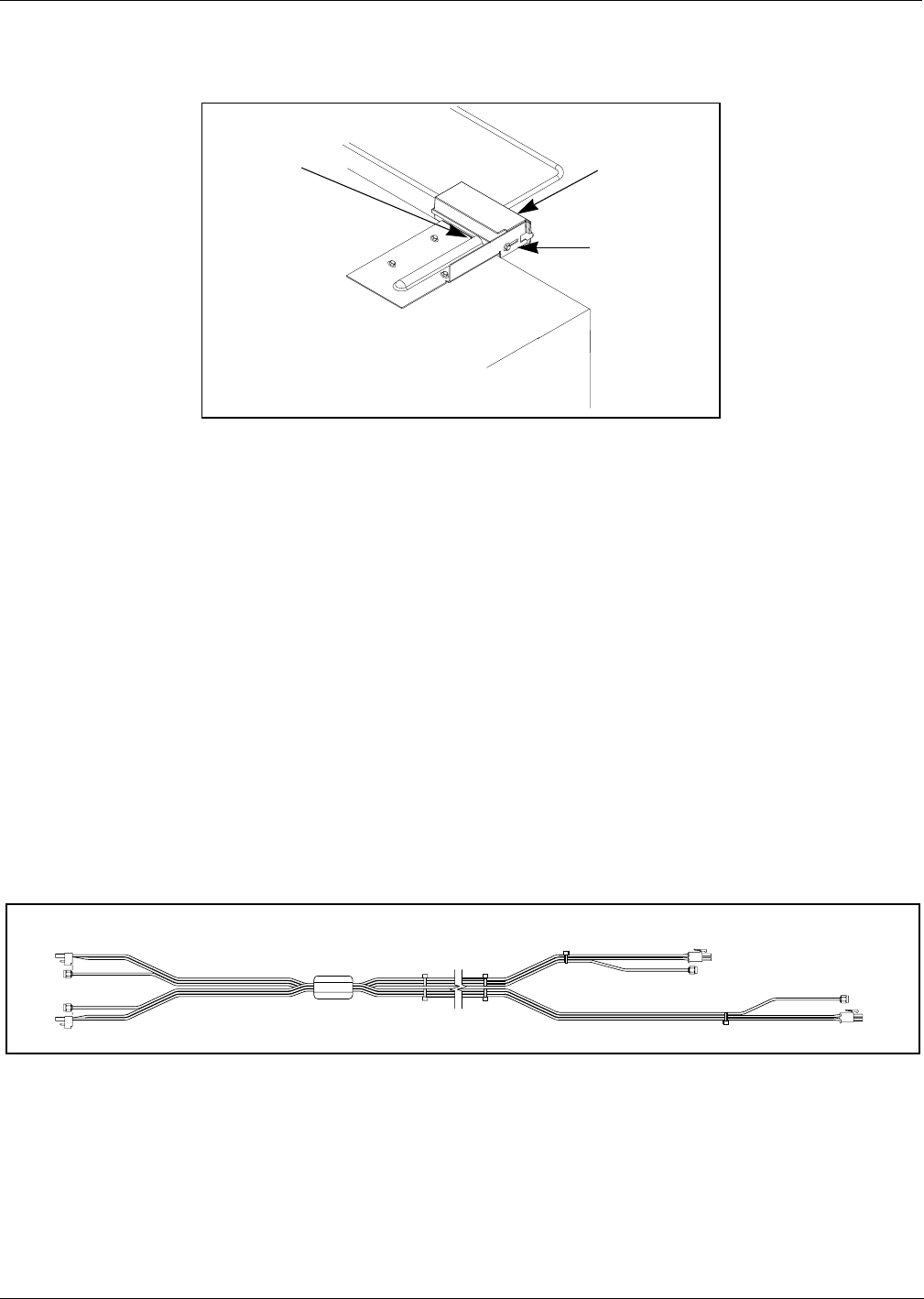
MDE-3591A TRIND™/TIRIS™ Retrofit Kits C00011-002-XXXX • 11/00 Page 49
Instructions for All Units
PRELIMINARY
FCC 11/30
Sealing Antenna Bracket with Cables on All Units
To seal bracket cable channel (each side) do the following:
1Loosen both screws holding each antenna assembly to bracket.
2Pull antenna and mounting box out from bracket and allow antenna to lower, to
allow sealing of access end of bracket cable channel with RTV sealant.
Note: Only one bracket per side (left side when facing unit) contains cables.
3Restore antenna assembly to original level position on bracket and re-secure with
screw.
Preparing Antenna Cable Connections
For all units, gain access to upper housing from underside, by removing upper
housing bottom sheathing or VaporVac belly pan, as required. Refer to MDE-2531
Service Manual for instructions. Save all parts and hardware for reassembly.
For additional information refer to “Cable Block Diagram R20762” on page 52 and
“Cabinet Cable Connections” on page 53.
Do the following:
1Locate previously installed P1A/B and P3A/B ends (4 total) of cables on cable
harness M00878A002 in upper housing.
2Be sure that all connectors can be identified for A and B sides, respectively.
screw
antenna
assembly
mounting box
access end of
cable channel
M00878A002 Cable Assembly
PB
P2B
P2A
PA
P1B
P3B P3A
P1A
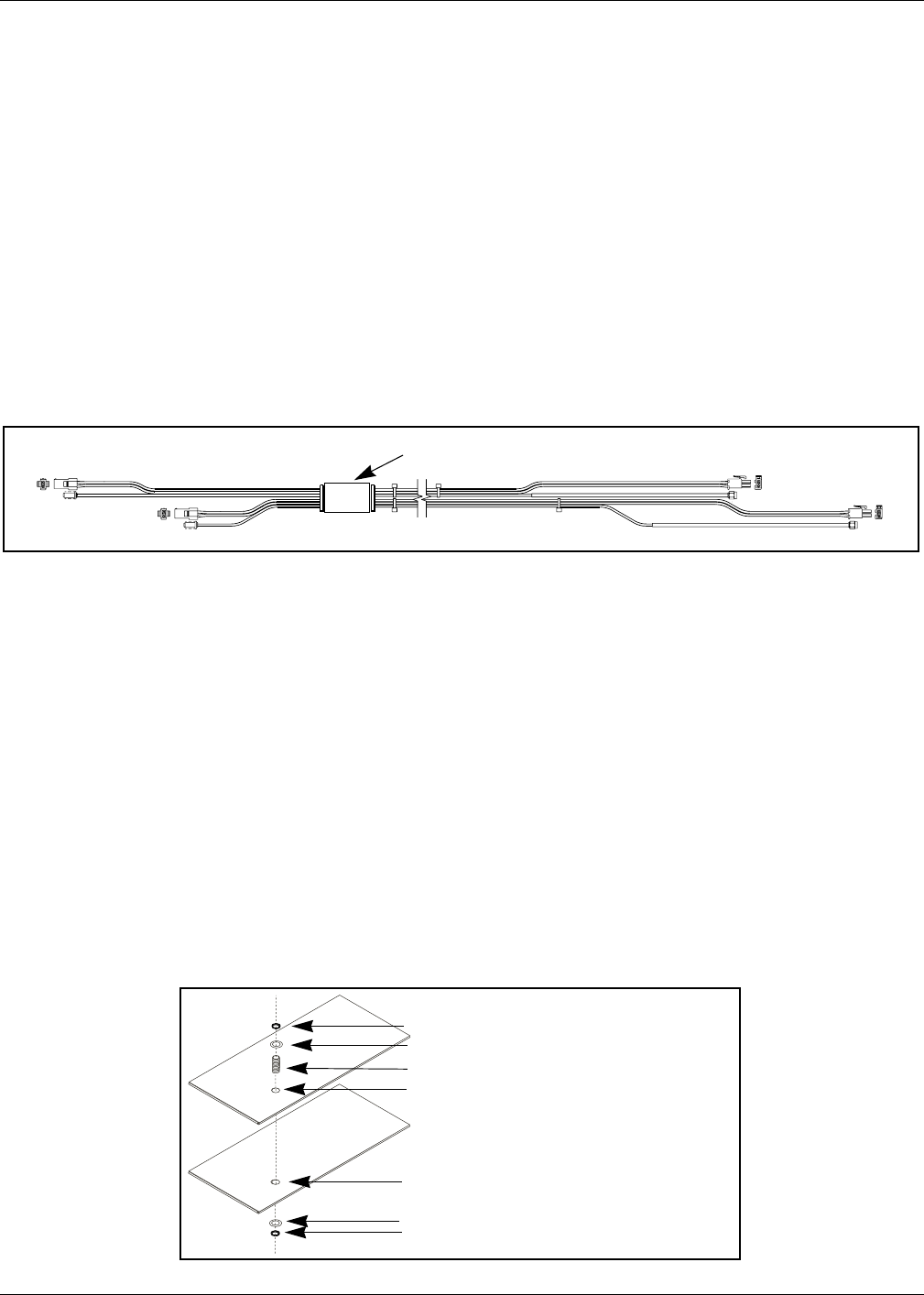
Instructions for All Units
Page 50 MDE-3591A TRIND™/TIRIS™ Retrofit Kits C00011-002-XXXX • 11/00
PRELIMINARY
FCC 11/30
Upper Housing Connections Without Light Box
Do the following to connect M00878A002 cable harness assembly to antenna:
1For A Side, inside upper housing:
•Connect P1A on harness to J1 low frequency antenna cable.
•Connect P3A on harness to J2 high frequency antenna cable.
2Fro B Side, inside upper housing:
•Connect P1B on harness to J1 low frequency antenna cable.
•Connect P3B on harness to J2 high frequency antenna cable.
3Use tie wraps supplied with kit to secure cables to frame in upper housing, away
from maintenance access areas for piping and valves.
Upper Housing Cabling With Light Box
Do the following:
1Locate aligned conduit knockouts on Light Box and top cover, and remove both.
2Feed conduit washer and lock nut over longer sections of cable divided by potted
nipple, with nut locking side facing nipple.
3Install locking nut at least four full turns onto nipple.
4From Light Box, feed shorter sections of cable through knockout holes and into
upper housing.
5From upper housing, feed cables through second conduit washer and locking nut,
with locking side of nut facing nipple.
6Tighten conduit lock nut (easier from Light Box) until nipple is held firmly in
place from both upper housing and Light Box.
J1A
J2A J1B
J2B
P1A
P2A
P2B P1B
M01380A001 Cable Extension Assembly
conduit nipple, pottedupper housing connections light box connections
conduit locknut, locking side down
conduit nipple on M01380A001 cable assembly
bottom of Light Box with knockout removed
conduit locknut, locking side up
top cover with knockout removed
conduit washer
conduit washer

MDE-3591A TRIND™/TIRIS™ Retrofit Kits C00011-002-XXXX • 11/00 Page 51
Instructions for All Units
PRELIMINARY
FCC 11/30
7Make the following cable connections in Light Box:
•Connect P1A on cable harness to A Side J1 antenna cable.
•Connect P2A on cable harness to A Side J2 antenna cable.
•Connect P1B on cable harness to B Side J1 antenna cable.
•Connect P2B on cable harness to B Side J2 antenna cable.
8Make the following cable connections in upper housing:
•Connect P1A on M00878A001 harness to J1A on extension assembly
M01380A001 assembly.
•Connect P3A on M00878A001 harness to J2A on extension assembly
M01380A001 assembly.
•Connect P1B on M00878A001 harness to J1B on extension assembly
M01380A001 assembly.
•Connect P3B on M00878A001 harness to J2B on extension assembly
M01380A001 assembly.
9Use tie wraps supplied with kit to secure cables to frame in upper housing, and
for both Light Box and upper housing to keep cables away from maintenance
access areas for piping, valves and fixtures.
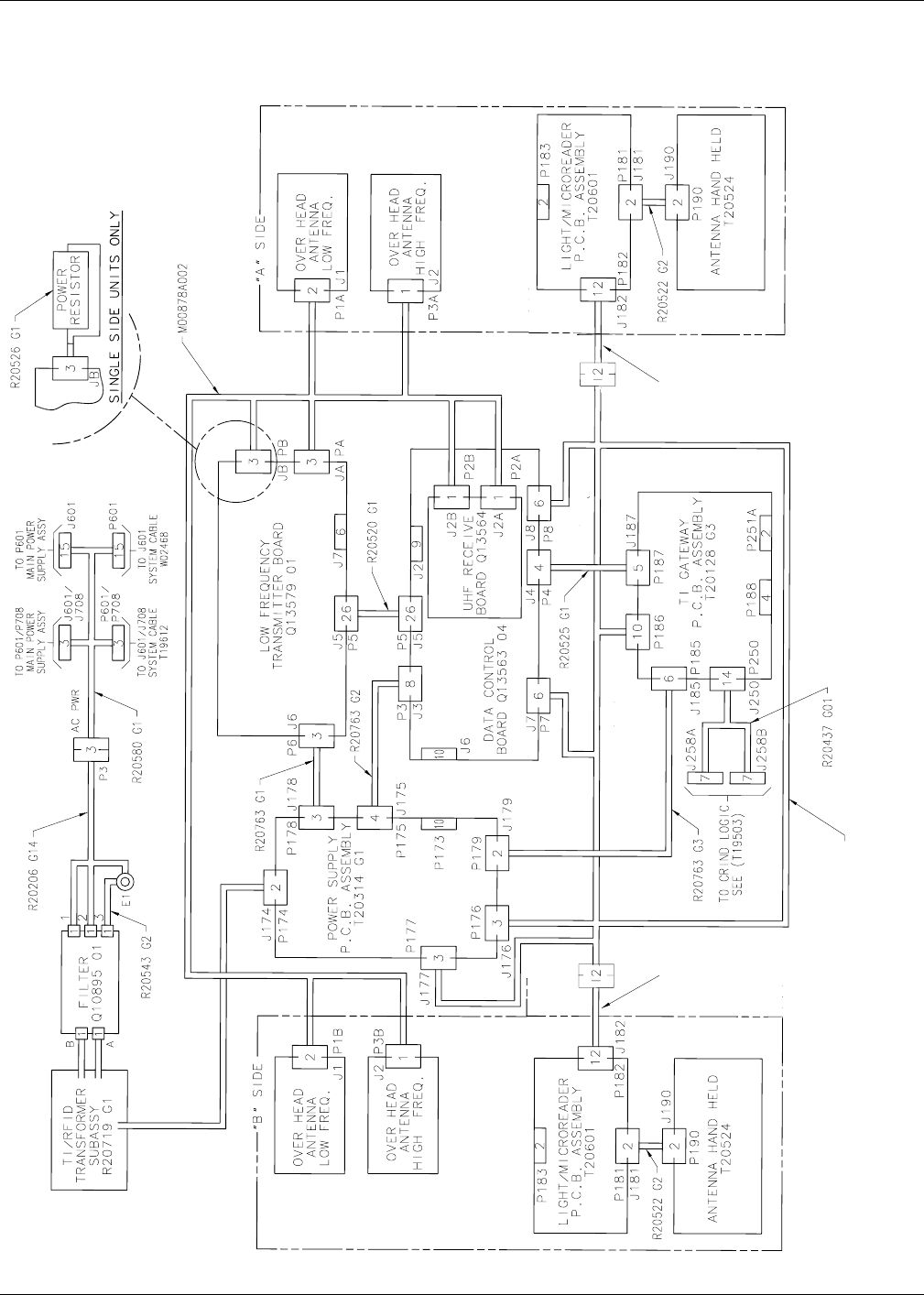
Instructions for All Units
Page 52 MDE-3591A TRIND™/TIRIS™ Retrofit Kits C00011-002-XXXX • 11/00
PRELIMINARY
FCC 11/30
Cable Block Diagram R20762
T20662-G2
R20773-G2 R20773-G2
J1/J2
P2 P2
J1/J2
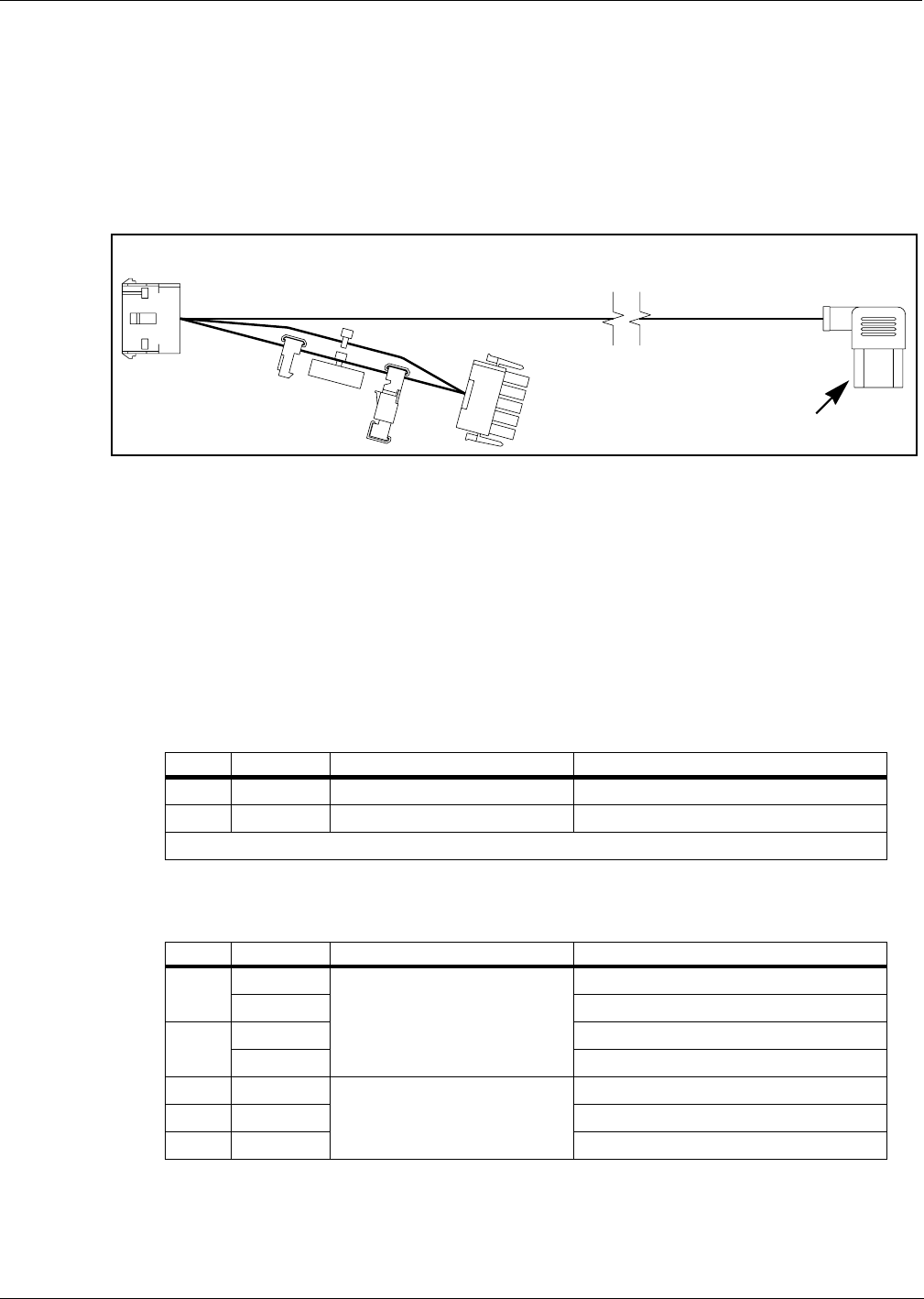
MDE-3591A TRIND™/TIRIS™ Retrofit Kits C00011-002-XXXX • 11/00 Page 53
Instructions for All Units
PRELIMINARY
FCC 11/30
Connections for power supply cable R20580-01 are unit specific. Plug three prong
female end into three-prong receptacle of card cage (see “Card Cage Assembly
T20606-G2” on page 54), and use appropriate connector to intercept power on unit
power cable by installing R20580-01 in-line.
Note: Check whether brand panel lighting ballast is connected to power supply. If
so, disconnect ballast from power supply and terminate wires ends according
to NFPA 70, the National Electric Code and applicable local codes.
Cabinet Cable Connections
For illustration of card cage assembly, see “Card Cage Assembly T20606-G2” on
page 54.
Note: For all single-sided units, install dummy load connector R20526-01 on JB
on transmitter PCB and skip all ‘B’ side connections. If power is applied to
card cage without antenna cables or dummy load connected the transmitter
board will be damaged.
Cable harness T20662-G2 is shipped with card cage connections made. Make the
following connections to the cable harness connectors:
Card Cage Connections:
Note: For illustration refer to “Card Cage Assembly T20606-G2” on page 54.
Side Connector On Installed Cable to Connector on Card Cage Harness
A J1 A Side R20773-G2 P1
B J2 B Side R20773-G2 P2
Notes: Cable R20773-G2 comes already installed in MPD-3 faceplate assembly.
Side Connector On Installed Cable to Connector on...
A PA M00878A001 JA on Card Cage
P2A J2A on Card Cage
B PB JB on Card Cage
P2B J2B on Card Cage
A&B J250 R20437-G01 P250 on Card Cage
A J258A P258A on CRIND Logic Board A Side
B J258B P258B on CRIND Logic Board B Side
AC PWR
J601/J708
P601/P708
P601
J601
MATE TO
T19612-G2
R20580-G1 Power Cable
To card cage assembly
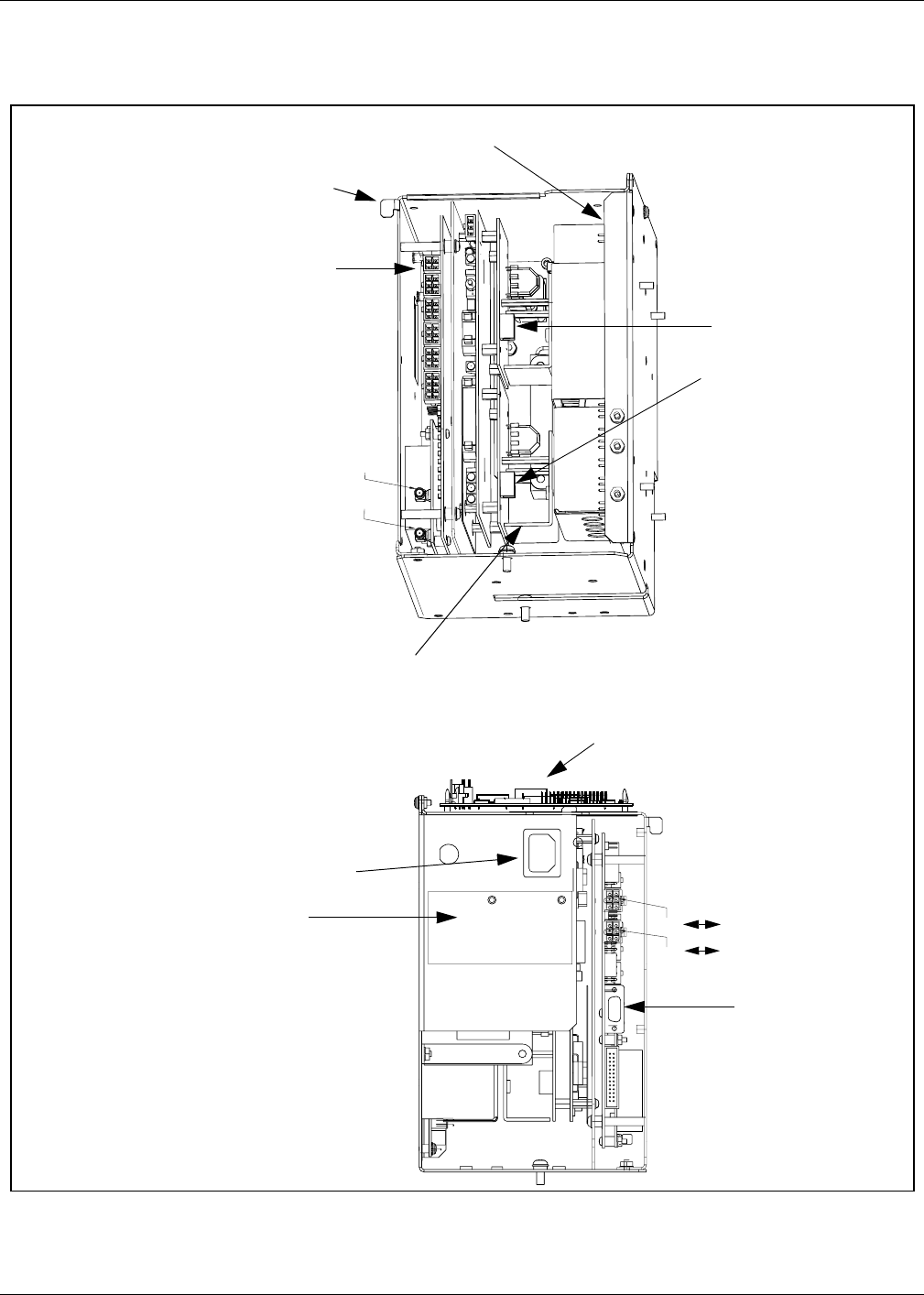
Instructions for All Units
Page 54 MDE-3591A TRIND™/TIRIS™ Retrofit Kits C00011-002-XXXX • 11/00
PRELIMINARY
FCC 11/30
Card Cage Assembly T20606-G2
B
A
A
B
B
A
Transmitter (low freq) PCB
assembly Q13579-01
Data control
board
Q13563-04
Power supply (Regulator) PCB
T20314-G1
JB for ‘B’ side or
R20526-G1 dummy
load connector
JA for ‘A’ side
P250 on TIRIS Gateway PCB T20128-G3
J2A
J2B
Recessed male three
prong power receptacle
UL® label J8 for ‘B’ side
J7 for ‘A’ side
RS232 port
Back Side
Front Side
Tab for
securing to
shelf divider
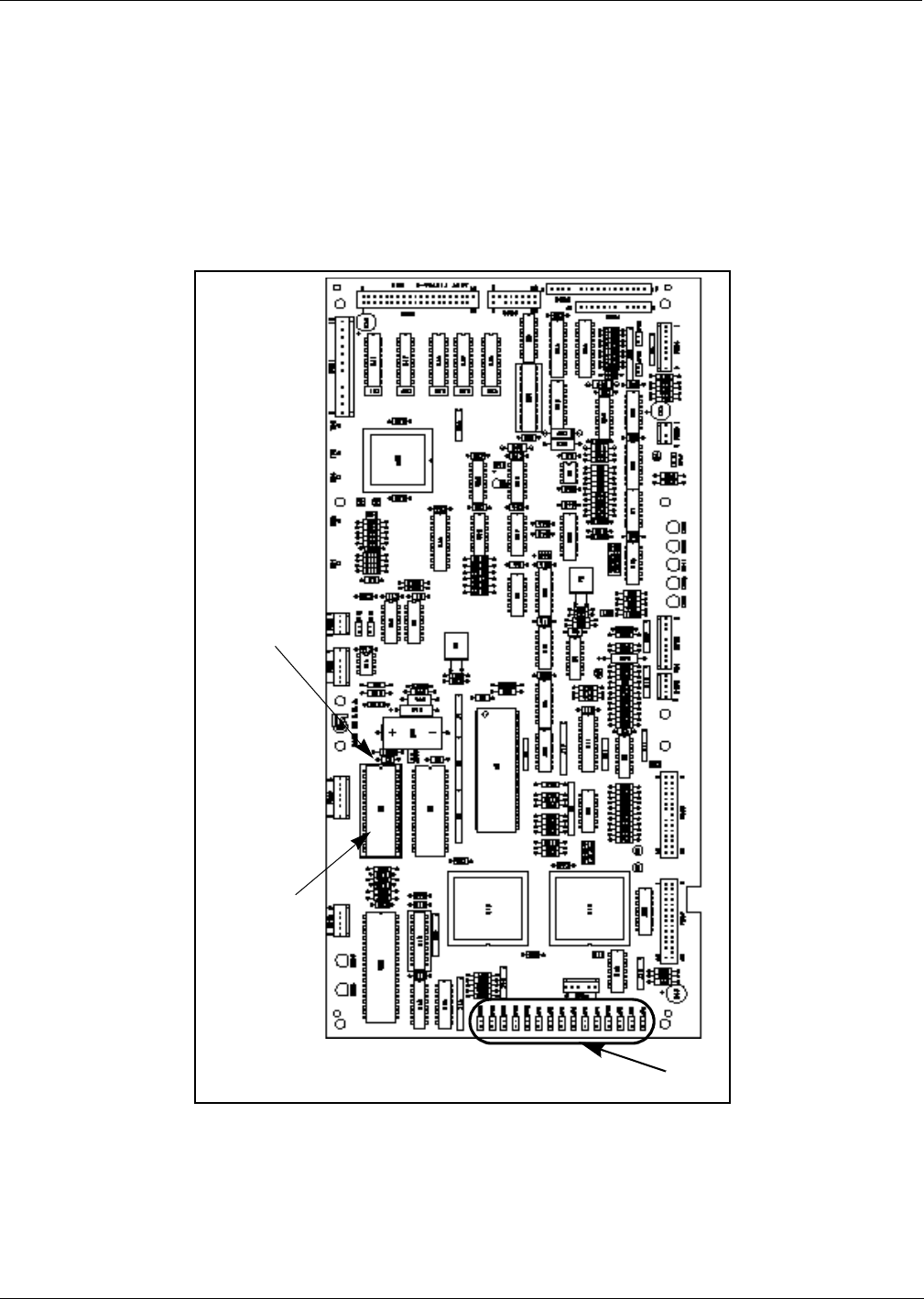
MDE-3591A TRIND™/TIRIS™ Retrofit Kits C00011-002-XXXX • 11/00 Page 55
CRIND® BIOS TRIND™ Multi 1 Upgrade
PRELIMINARY
FCC 11/30
CRIND® BIOS TRIND™ Multi 1 Upgrade
Units must have current Z-180 CRIND logic board.
Install the CRIND Bios TRIND software K93744-01, one per logic board, on the T17764-XX
CRIND logic board(s) according to the following steps.
Note: A properly grounded electrostatic discharge wrist strap must be worn during this
procedure.
U7
Chip
orientation
notch
T17764-XX
CRIND
logic board
(-G3 shown)
JP1-16
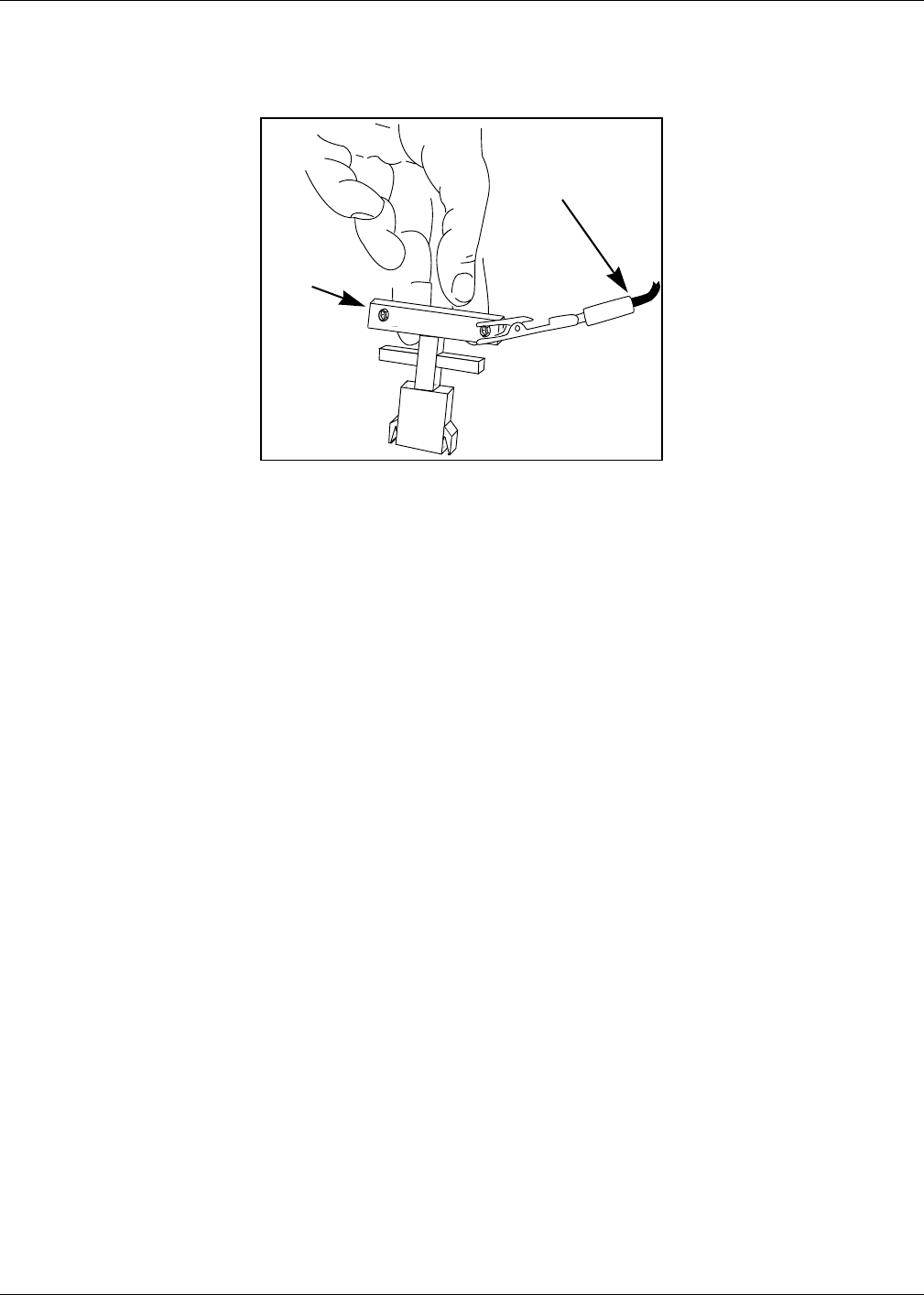
CRIND® BIOS TRIND™ Multi 1 Upgrade
Page 56 MDE-3591A TRIND™/TIRIS™ Retrofit Kits C00011-002-XXXX • 11/00
PRELIMINARY
FCC 11/30
1Locate and remove existing BIOS at U7 on CRIND® logic board T17764-XX using a
grounded chip removal tool.
2Install TRIND BIOS K93744-01 (one per logic board) at position U7, orienting notch on chip
with indication mark on board as shown.
3Install jump jack on JP-16 for each side of unit.
Note: Jumper on JP-16 informs the CRIND that a TRIND system is present.
4Restore CRIND tray to operating position.
Chip
removal
tool
Grounding strap
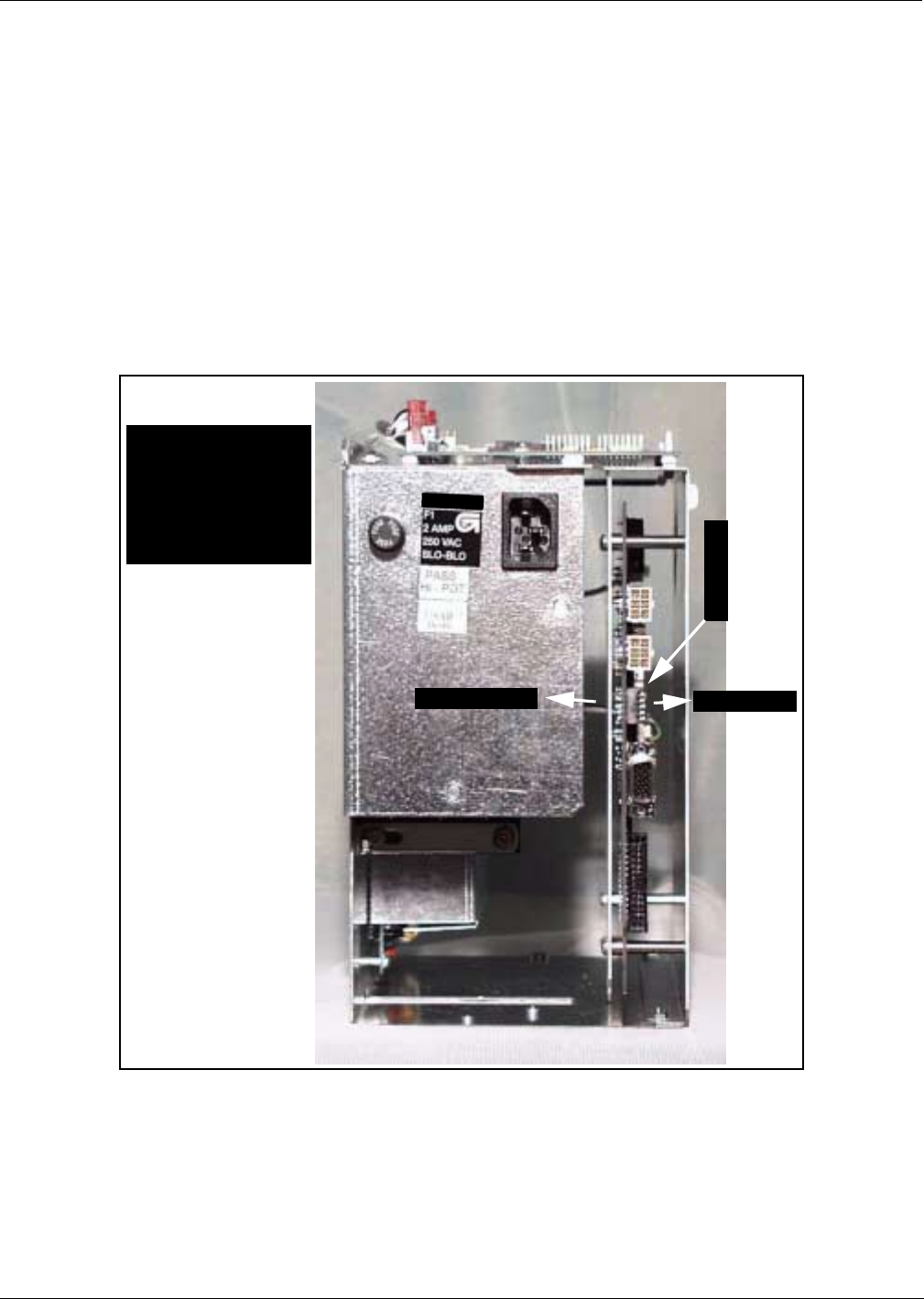
MDE-3591A TRIND™/TIRIS™ Retrofit Kits C00011-002-XXXX • 11/00 Page 57
Dispenser Set-Up
PRELIMINARY
FCC 11/30
Dispenser Set-Up
Addressing Dispenser
Each dispenser on the G-Site controller must be addressed differently; no two dispensers may
have the same address. Address is at discretion of the installer. Follow these steps:
1From A side of unit, locate dip switches on power supply board (PCB) T20314-G1 in card
cage.
2Using switches 2, 3, 4 and 5 address each dispenser according to the following table:
Note: Switch one in down position is standalone mode selected, used for service only.
Setting Baud Rate
For major oil company (MOC) TRIND™ installations there is no requirement to set or change
baud rate.
Switch Numbers = Value
1 = Standalone Mode
2 = 1
3 = 2
4 = 4
5 = 8 1
2
3
4
5
Dip switch down Dip switch up
T20606-G2
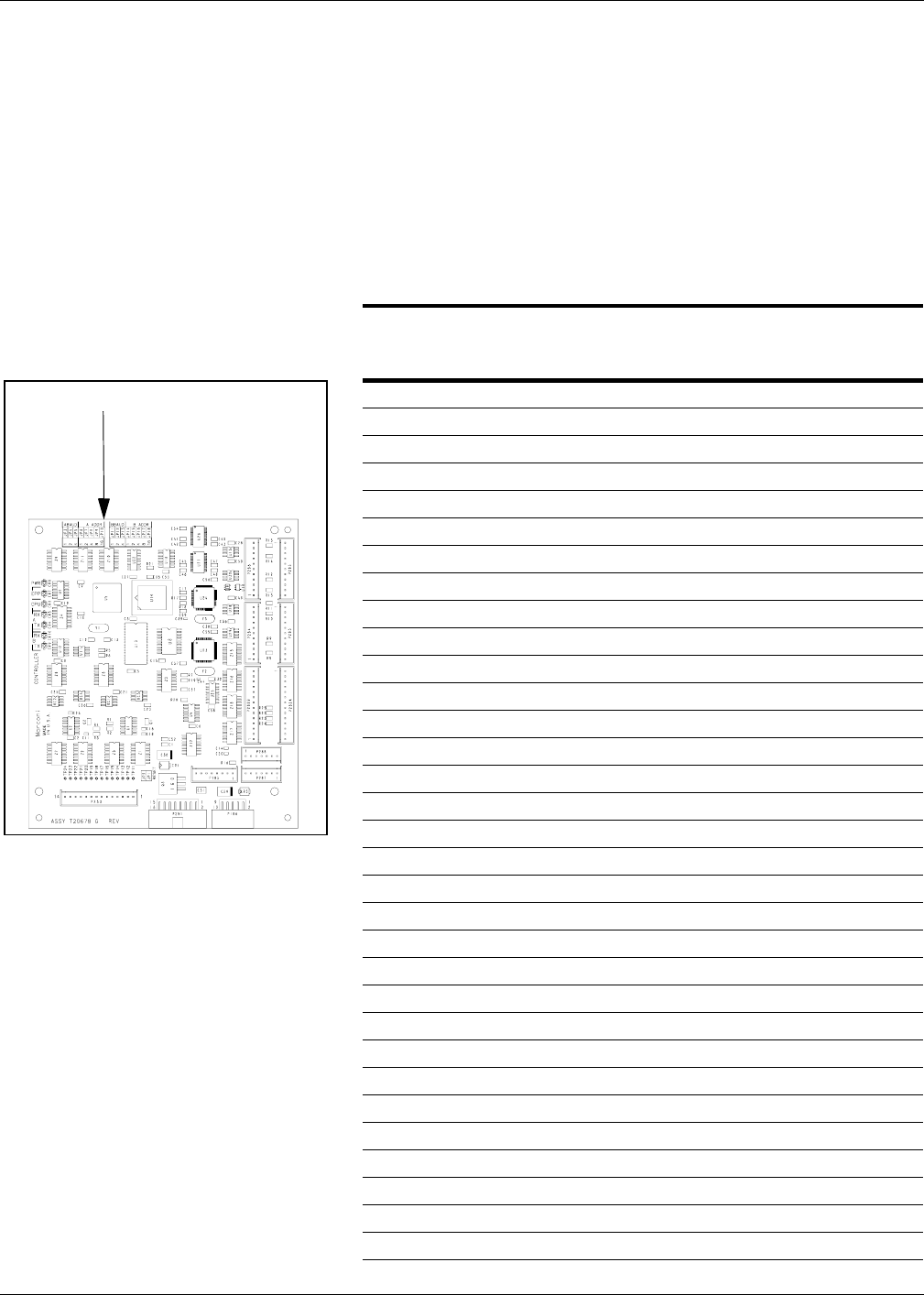
Dispenser Set-Up
Page 58 MDE-3591A TRIND™/TIRIS™ Retrofit Kits C00011-002-XXXX • 11/00
PRELIMINARY
FCC 11/30
Addressing Gateway Board
Address for TRIND™ must match address on CRIND® logic board. Follow these
steps:
1Access unit’s CRIND logic board. Refer to MDE-2562 CRIND Service Manual.
2Locate jump jacks on A and B side CRIND logic boards T17764-XX.
3Note position of jump jacks and set jump jacks on Gateway board T20128-G3 to
match address on CRIND logic boards for both A and B sides.
MOC and Generic CRIND Addresses
Address On CRIND Logic Board T17764-XX JP8 JP7 JP6 JP5 JP4
= Address on Gateway Board T20128 ‘A’ Side JP6 JP7 JP8 JP9 JP10
= Address on Gateway Board T20128 ‘B’ Side JP14 JP15 JP16 JP17 JP18
1 IN OUT OUT OUT OUT
2 OUT IN OUT OUT OUT
3 ININOUTOUTOUT
4 OUT OUT IN OUT OUT
5 IN OUT IN OUT OUT
6 OUT IN IN OUT OUT
7 INININOUTOUT
8 OUT OUT OUT IN OUT
9 INOUTOUTINOUT
10 OUT IN OUT IN OUT
11 IN IN OUT IN OUT
12 OUT OUT IN IN OUT
13 INOUTININOUT
14 OUTINININOUT
15 IN IN IN IN OUT
16 OUT OUT OUT OUT IN
17 IN OUT OUT OUT IN
18 OUT IN OUT OUT IN
19 IN IN OUT OUT IN
20 OUT OUT IN OUT IN
21 IN OUT IN OUT IN
22 OUTININOUTIN
23 IN IN IN OUT IN
24 OUT OUT OUT IN IN
25 IN OUT OUT IN IN
26 OUT IN OUT IN IN
27 IN IN OUT IN IN
28 OUT OUT IN IN IN
29 INOUTINININ
30 OUTININININ
31 IN IN IN IN IN
32 OUT OUT OUT OUT OUT
Jump jack locations on Gateway Board
Accessible at upper left
hand corner of front of
card cage
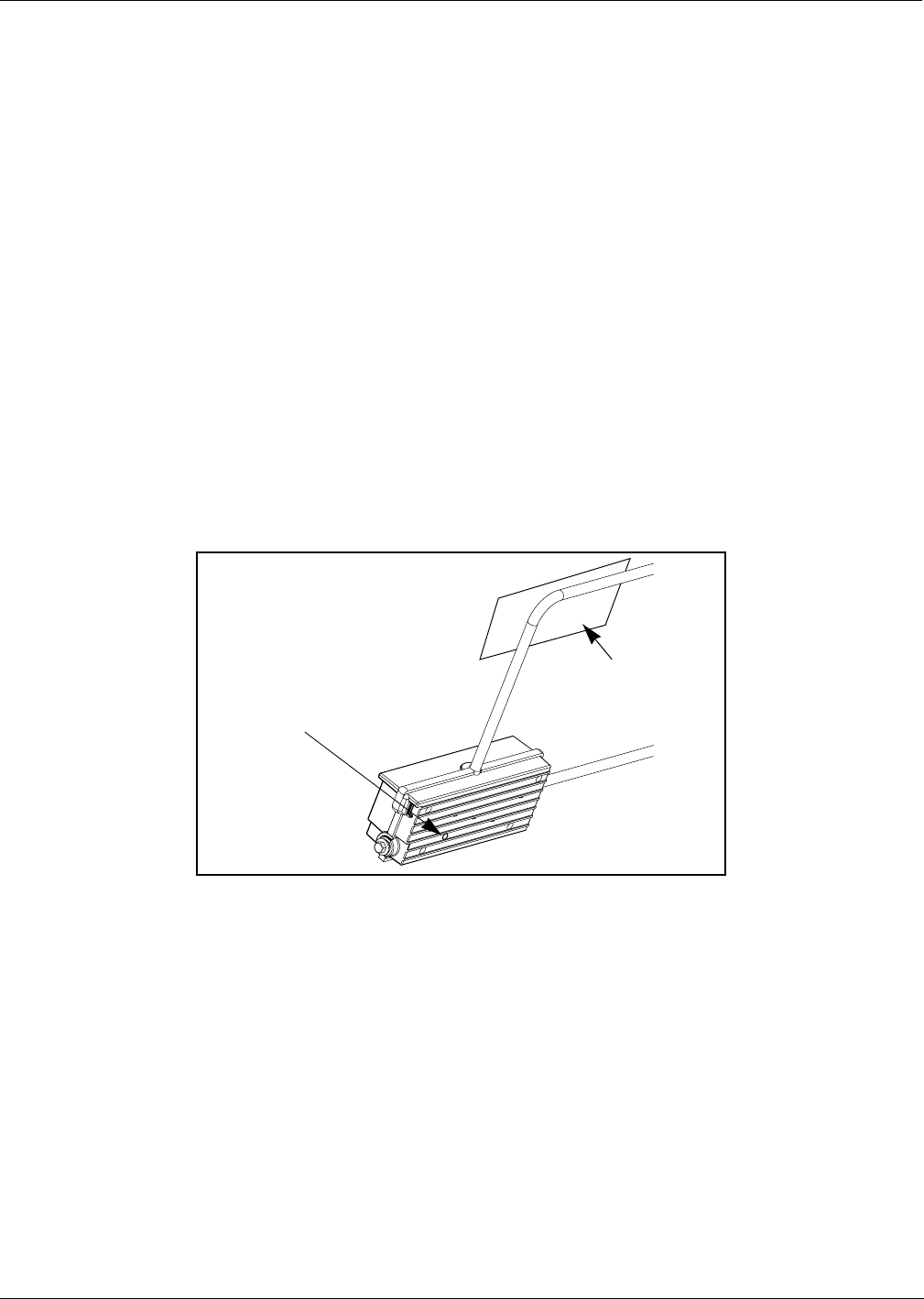
MDE-3591A TRIND™/TIRIS™ Retrofit Kits C00011-002-XXXX • 11/00 Page 59
Dispenser Set-Up
PRELIMINARY
FCC 11/30
Preparation for Tuning Antennas
Antenna tuning requires use of field strength sensor Q13626-01 supplied with
ASC tool kit.
1For units without G-Site™ put unit in ‘Stand Alone’ mode by disconnecting J4 on
the DCB board and placing jumper on light microreader board at JP3.
Note: JP3 and J4 can never both be in or both out. One and only one must always
be in, the other out.
2If applicable, restore CRIND tray to operating position.
3Restore power to unit(s) and cold start the CRIND. Refer to MDE-2562, CRIND
Service Manual for detailed instructions.
Note: Be sure transmitter cables are connected before restoring power.
4Once the CRIND display indicates unit is downloading, remove the Cold Start
jump jack.
Tuning Antennas
1Locate access port for tuning pot in over-head antenna connection box.
Note: Use tuning tool Q13631-XX from the ASC TRIND tool kit to make pot
adjustments. Refer to MDE-3640 ASC TRIND Tool Kit for instructions. Hex
end of tuning tool matches hex shape of tuning pot.
2Lay field strength sensor on antenna roughly as shown. Exact location is not
critical.
Tuning pot access port
location in overhead
antenna connection
box
View from underside of
antenna assembly
field strength sensor
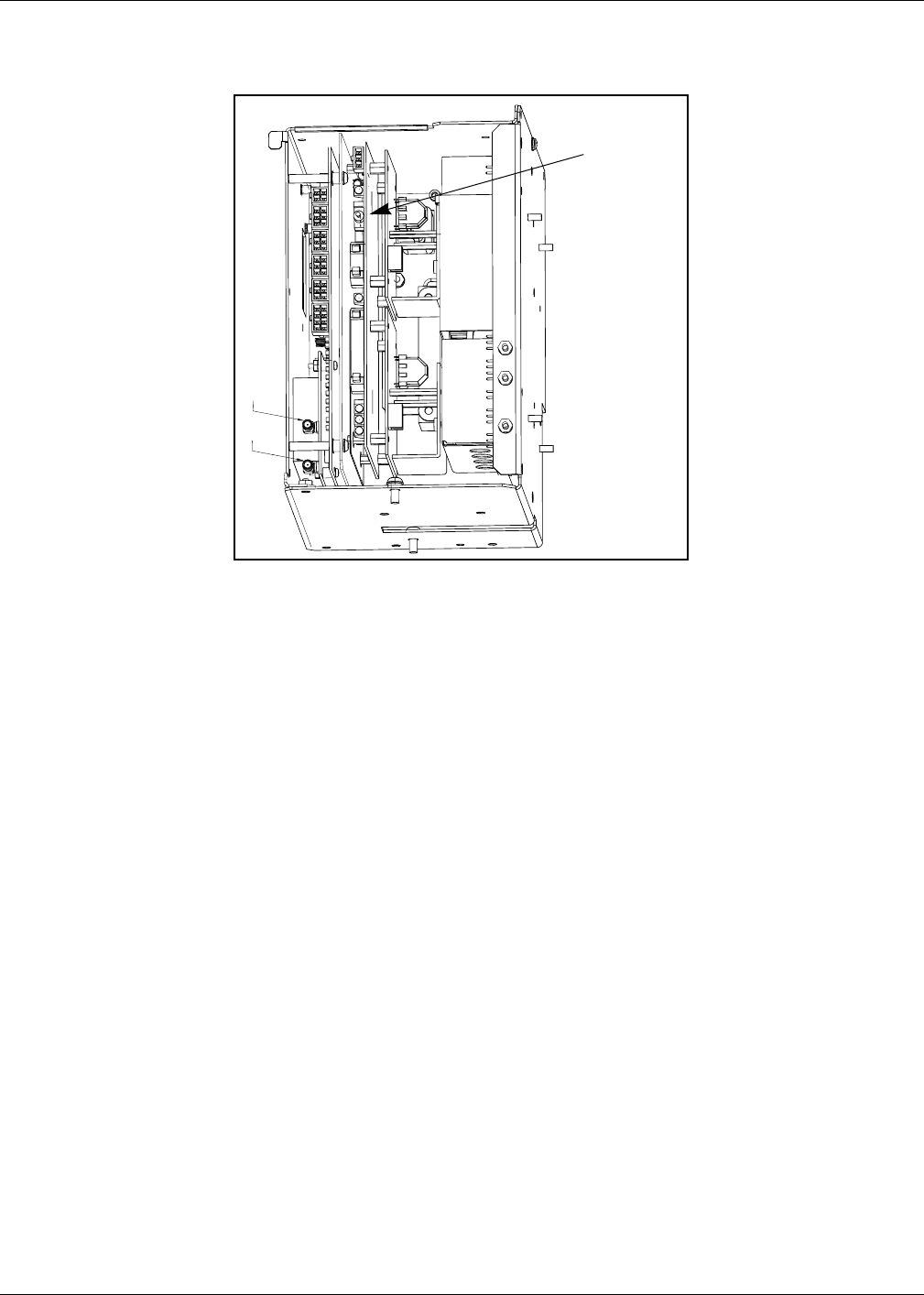
Dispenser Set-Up
Page 60 MDE-3591A TRIND™/TIRIS™ Retrofit Kits C00011-002-XXXX • 11/00
PRELIMINARY
FCC 11/30
3On card cage, move three position ‘tune’ toggle switch from center position to ‘A’.
4Connect leads on multi-meter set to DC voltage to field strength sensor.
5By fine adjustments to tuning pot, set to highest DC voltage reading.
Note: Voltage will peak at a point, and then decrease with turns in either direction.
Set at peak.
6Repeat Steps 1 through 8 for ‘B’ side and then return tune toggle switch to center
position.
B
A
A
B
‘Tune’ toggle
switch
location

MDE-3591A TRIND™/TIRIS™ Retrofit Kits C00011-002-XXXX • 11/00 Page 61
Dispenser Set-Up
PRELIMINARY
FCC 11/30
Testing TRIND™
1From ‘A’ side of unit touch hand held test tag (Q13630-02 from the ACS TRIND
tool kit) to TRIND target graphic. Door or faceplate TRIND indicator will light.
Note: If indicator fails to light check whether light on other side is on; if so it
indicates a crossing of ‘A’ and ‘B’ side cables. Check connections.
2From ‘A’ side of unit hold car mount test tag (Q13630-01 from the ASC TRIND
tool kit) in front of unit, at a distance of approximately 6 feet from overhead
antenna. Door or faceplate TRIND indicator will light.
3Repeat Steps 1 through 3 for ‘B’ side.
Alternative Testing Using Laptop
1Connect laptop to RS232 port on DCB.
2Go to:
•Windows program
•Accessories
•Terminal
•Settings
•Communications
3Set for:
•9600 baud
•8 bit
•No parity
•Comm 1
4Then go to:
•Help screen
•Antenna scan
•Choose 1, 2, 3 and 4
Note: This will test both antennas
5From ‘A’ side of unit touch hand held test tag (Q13630-02 from the ACS TRIND
tool kit) to front of TRIND target graphic. Door or faceplate TRIND indicator will
light.
6From ‘A’ side of unit hold car mount test tag (Q13630-01 from the ASC TRIND
tool kit) in front of unit, at a distance of approximately 6 feet from overhead
antenna. Door or faceplate TRIND indicator will light.
7Repeat Steps 5 and 6 for ‘B’ side.
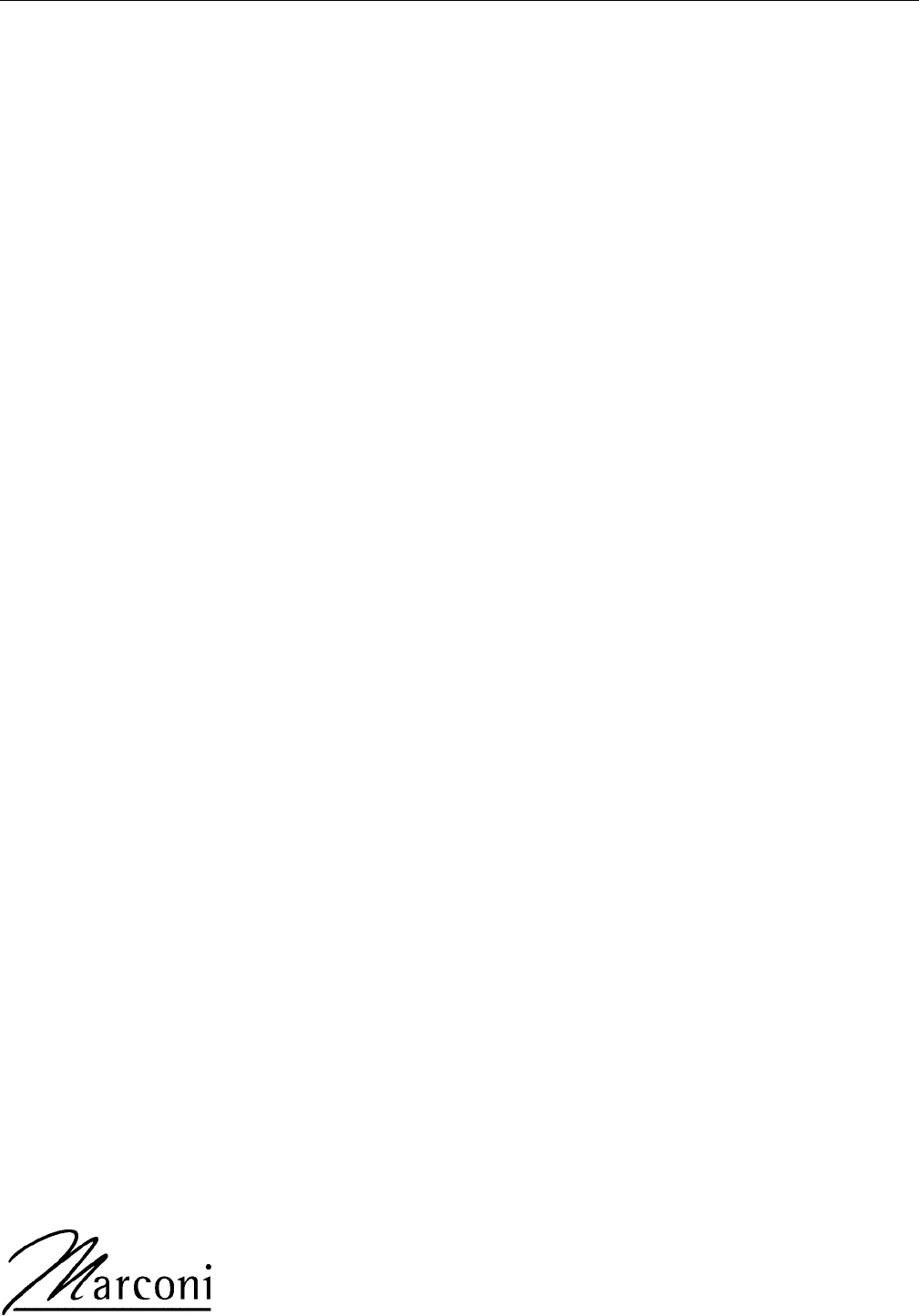
Dispenser Set-Up
© 2000 Marconi Commerce Systems Inc.
7300 West Friendly Avenue • Post Office Box 22087
Greensboro, North Carolina 27420
Phone (336) 547-5000 • http://www.marconicommerce.com • Printed in the U.S.A.
MDE-3591A TRIND™/TIRIS™ Retrofit Kits C00011-002-XXXX • 11/00
PRELIMINARY
FCC 11/30
Completing Installation
After all testing has been completed, do the following:
1Shut off all power to the unit.
2Replace or refasten all components and hardware, including:
•Replace all sheathing and/or pans removed.
•For units with Light Boxes, replace and tighten all mounting hardware.
3Close all secure all doors, including Light Box doors (if present).
4Clean up work site, removing all materials to be discarded and all tools.
5Reapply power and Cold Start the unit.